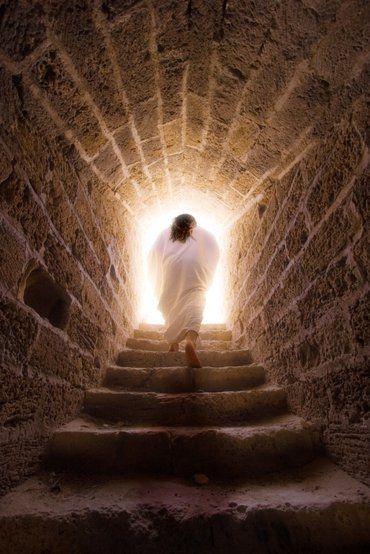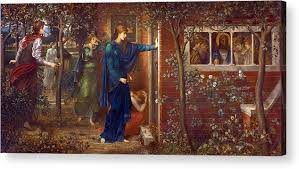Below are short posts from my Instagram and Facebook before I closed my accounts.
Click down to access videos, memes, articles, musings, whatever . . .
The Savior
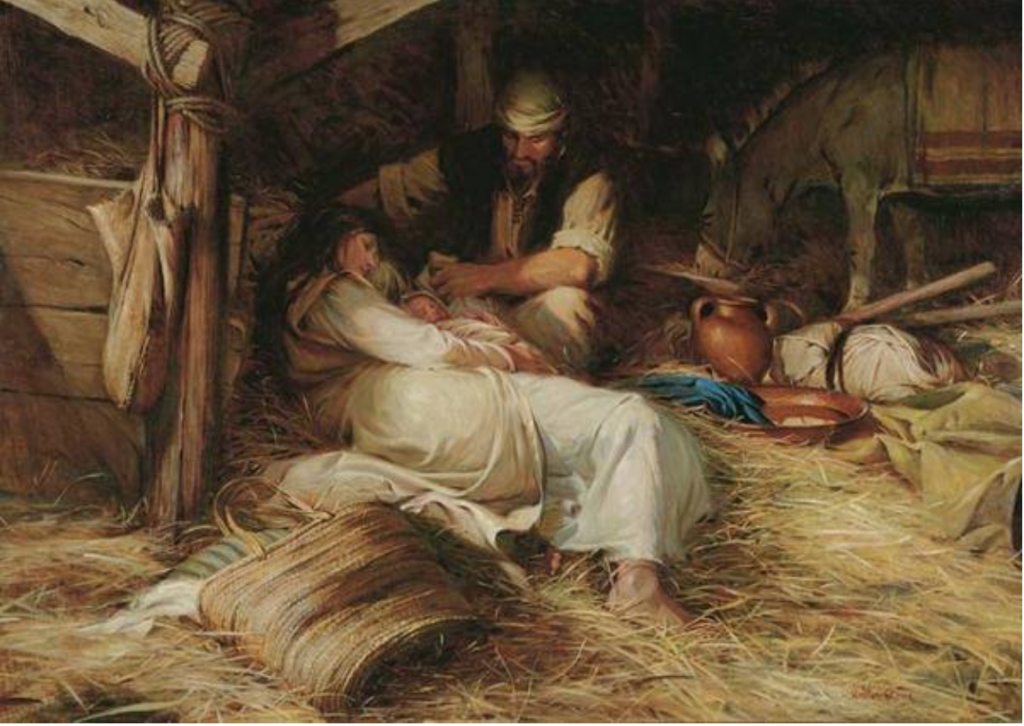
Many claim that religion is all that’s wrong with the world. But, religion is also much that’s right about the world.
Many claim that faith is for the weak. I have found that faith requires enormous amounts of strength.
I have entrusted my faith to a little baby—born in the humblest of circumstances—whose divine mission was to be the Savior of the world.
I’m so thankful that Christians take time each year to celebrate His holy birth. Christ is truly my Prince of Peace. The Prince of my inner peace.
Need a sherpa?

When scaling those mountains there’s no better sherpa than Christ!
Got a song?
Planetshakers: No Other Name
I often watch the Christian broadcast, “Life Today,” founded by Pastor James Robison and his wife, Betty. Sometimes, the program features Christian musicians whose artistry inspires me.
I’ve posted one of the featured artists above. This group called Planetshakers wrote and performed this beautiful song about the Savior entitled “No Other Name.”
I’m inspired by these young people and their musical testimonies of Jesus Christ—that only through Him and His atoning sacrifice do we attain forgiveness, healing, hope, and salvation. I also appreciate their obvious devotion to Christ while performing this song.
I’m so thankful for courageous Christians around the world who, as part of the body of Christ, boldly proclaim and testify of the divinity of Jesus Christ. Christianity is losing its worldwide influence while Christians, in many areas of the world, are hated, persecuted, imprisoned, enslaved, and murdered. Their sacrifice and suffering—because of their devotion to the Savior—still serves as a powerful testimony and example to the world.
In a hotel?
Dig through the drawers; this is worth a read

I will admit to this: I almost stole one of these Gideons International Bibles while staying at a hotel years ago. I had forgotten to bring my own scriptures on that particular trip and found this Bible in my hotel room. The plain and clear language made for easy reading compared to the King James Version translated in Elizabethan English. After reading a few pages, I got so enthralled that I seriously considered taking the book home with me. The irony of my situation was also plain and clear: Don’t steal. And especially don’t steal in Christ’s name. So, I bought a copy on Amazon and have since referred to it again and again.
The Gideons Old Testament descriptions of the temple rituals using animal sacrifices were particularly jarring to me. It’s hard to imagine being a temple worker back then; killing animals, taking out and using their entrails, then burning what’s left of the carcasses.
And the blood. Lots and lots of blood.
I’ve decided that all the blood and gore were purposeful lessons from God in teaching the Israelites. The Old Testament prophets—especially Isaiah—gave detailed written accounts of their heavenly visions of the future Messiah and His sacrificial suffering for our sins. Christ’s Atonement, torture, and eventual execution on the cross involved His blood. Lots and lots of His blood.
Christ willingly shed His precious blood for us. For me. I love Him.
#christmas2020 #merrychristmas2020 #givethanks
On stormy seas?
Here’s my last post for my 25 Days of Advent. I have broken it down into three parts:
1. Christ Calms the Stormy Sea
The Four Gospels tell of Jesus and the apostles crossing the Sea of Galilee by boat. A sudden furious storm threatened to sink the boat, and the panicked apostles awakened Jesus saying, “Master, carest thou not that we perish?” (Luke 8:22) In response, Christ rebuked the storm saying, ‘Peace be still.’ And “the men marveled, saying, ‘What manner of man is this, that even the winds and the sea obey him!’” (Matt. 8:27).
Eric Huntsman’s BYU New Testament Commentary entitled, “Calming the Stormy Sea,” further explains:
The disciples’ terror contrasts with the unperturbed calm of Jesus, who seemingly would have slept through the storm had his friends had not roused him, begging for his aid. In the second part of this miracle story, Jesus, in a moment of divine majesty, ‘arose, and rebuked’ (Mark 4:39). Jesus’ direct rebuke of the storm is followed by an implicit reprimand of his disciples in the next verse, when he says, ‘Why are ye so fearful? how is it that ye have no faith?’ The concluding part of the story relates the reaction of the disciples: “’they feared exceedingly, and said one to another, What manner of man is this, that even the wind and the sea obey him?’ (Mark 4:41) The common literary motif of greatness weaves the sections of the miracle story together, stressing the great storm that occasions the miracle, the great calm that ensues, and the great fear of the disciples that results” (2015).
Every time I turn to Him, Christ calms the tumultuous and stormy seas in my life. The water might not be perfectly still, and safe land might not be in sight, but that’s ok. Christ still navigates me to my eventual destination rather than leaving me tossed, floundering, seasick, and alone.
2. Christ Walks on Water
On another occasion, the disciples boarded a boat to cross the Sea of Galilee. There, they would meet Christ who had gone up to a mountain to pray alone. While crossing the sea, a violent storm emerged causing the disciples much distress. Their fear worsened when they caught their first glimpse of Christ walking on the water toward their boat. Telling them to, “Be of good cheer,” He bid the apostle Peter to step out of the boat and come to Him by walking on the water (Matt. 14: 22).
I love the Apostle Peter. I love his impetuousness and his zeal. He was also the only disciple courageous enough to get out of the boat and walk on water toward Jesus Christ. Yes, Peter started to sink, but his courage was still admirable. Even more, Christ caught him before Peter completely went under. Pastor/Speaker, Joyce Meyer reminds us that Jesus Christ is not found in our boatload of fears. Rather, He’s out on the water and beckons us to step out and walk toward Him. Most likely, we’ll feel increased anxiety as we “water-walk,” and like Peter, we’ll probably sink a few times along the way. On the other hand, as with Peter, Christ will not let us drown. He is our peace in the midst of our fears and anxiety.
3. Christ is our Prince of Peace
Isaiah surely got it right when he prophesied:
For to us a child is born, to us a son is given; and the government shall be upon his shoulder, and his name shall be called Wonderful Counselor, Mighty God, Everlasting Father, Prince of Peace (Isaiah 9:6).
Shortly before His crucifixion, Christ reassured His disciples, “Peace I leave with you; my peace I give to you. Not as the world gives do I give to you. Let not your hearts be troubled, neither let them be afraid” (John 14:27). After Christ’s resurrection, John records the stressful and dangerous environment the apostles were living in: “On the evening of that day, the first day of the week, the doors being locked where the disciples were for fear of the Jews, Jesus came and stood among them and said to them, ‘Peace be with you'” (John 14:27; John 20:19).
Many years ago, I read the book The Road Less Traveled, written by Dr. Scott Peck. I was so impressed with his insights, I read three more of his books. His writings completely changed my definition (and thus my attitude) about notions of peace. In The Road Less Traveled, Dr. Peck includes a quote about the peace of Christ from historian Thomas Beckett:
But think for a while on the meaning of this word ‘peace.’ Does it seem strange to you that the angels should have announced ‘Peace,’ when ceaselessly the world has been stricken with war and the fear of war? Does it seem to you that the angelic voices were mistaken and that the promise was a disappointment and a cheat?
Reflect now, how our Lord Himself spoke of peace. He said to His disciples, ‘My peace I leave with you, my peace I give unto you.’ Did He mean peace as we think of it: the kingdom of England at peace with its neighbours, the barons at peace with the King, the householder counting over his peaceful gains, the swept hearth, his best wine for a friend at the table, his wife singing to the children? Those men, His disciples knew no such things: they went forth to journey afar, to suffer by land and sea, to know torture, imprisonment, disappointment, to suffer death by martyrdom. What then did He mean? If you ask that, remember then that He said also, ‘Not as the world gives, give I unto you.’ So then, He gave to His disciples peace, but not peace as the world gives.’
Dr. Peck continues:
So with the peace of grace come agonizing responsibilities, duties, obligations. Most people want peace without the aloneness of power. And they want the self-confidence of adulthood without having to grow up [emotionally and spiritually]. So it is with spiritual growth, which is inseparable from the process of psychological maturation. For the call to grace in its ultimate form is a summons to be one with God. So the fact that many are called but few are chosen is easily explainable in view of the difficulties inherent in response to the call to grace (The Road Less Traveled, 1978).
I will end my 25 Day Advent by once again expressing my endless gratitude for Christ’s birth, His mission, His atonement, and His resurrection. Because of Him, I feel joyful. Because of Him, I feel triumphant. Because of Him, I love the seasons of Christmas and Easter. And because of God’s grace and His magnificent plan, our Savior is the greatest gift to us all. He is the Prince of Peace. He is the prince of my inner peace.
Need an Advocate?
For nearly 25 years, I taught a G.E. college course called “Argumentation and Advocacy.” Advocacy has many forms and contexts and is defined as any action that speaks on behalf of an individual and/or group who can’t speak for themselves. Advocacy also favors, recommends, argues, supports, pleads, or defends a cause.
Argumentation is coupled with advocacy. Listed below are the course objectives outlined in my syllabus. These objectives were the basic required skill sets in determining students’ grades. The objectives also served to blend the concepts of argumentation and advocacy:
1. Learn the basic principles of argumentation, models of argument, and how to put them into practice via written and oral communication.
2. Learn the principles of inquiry and advocacy in public discussion along with the necessary basic skills for intelligent participation in discussion and debate.
3. Learn how to think critically and engage in critical and analytical listening.
4. Learn how to assume the ethical responsibilities of the public speaker, including a basic understanding of the economic, legal, and social issues surrounding the access and use of information.
These objectives might sound clinical and impersonal, but as students learned, applied, and practiced these skills, they “found their voice” and “came alive.” By the end of the semester, they had come to realize their potential power to persuade and influence.
So, what does this have to do with Jesus Christ? Everything—every particle of those course objectives (and infinitely more) pertain to Jesus Christ and His mission. Christ is the ultimate and perfect advocate. In the pre-mortal realm, He engaged in analytical listening (followed by critical analysis) while Lucifer presented his own ideas and plan of advocacy for the eternal salvation of our souls. Lucifer’s arguments sounded well-meaning, altruistic, and were obviously very persuasive to many. Jesus Christ, however, recognized the fallacies in Lucifer’s arguments. Even more, Lucifer’s concept of advocacy was, in the end, self-serving narcissism disguised as altruism.
Christ’s idea of advocacy was loving selflessness: While in mortality, He would be our intercessor with the Father by taking our sins upon Himself, and offering Himself as a perfect (and perfectly innocent) sacrifice to atone for our sins. This is advocacy in its truest and perfect form.
The New Testament mentions Christ’s advocacy only once (although the word “intercession” is used); the Book of Mormon and Doctrine and Covenants directly and plainly discuss Christ’s advocacy. In a BYU Easter Conference, the Academic Vice President, John S. Tanner, taught:
“Even so, I believe that scripture provides a remarkably intimate glimpse into the mechanics of mediation—that is, into how it is done—in its descriptions of Christ as our advocate and high priest. Scripture allows us to overhear the Son pleading our cause to the Father. It invites us to enter into the heavenly Holy of Holies, where God dwells with our great high priest and where every day is a Day of Atonement. The scriptures we will consider provide sacred glimpses into how it is done. So on this Saturday before Easter, let us mentally doff the shoes from off our feet and enter into the sanctuary where our salvation is wrought.
The fullest and most intimate description of Christ as advocate in modern revelation occurs in Doctrine and Covenants 45:3–5. I have come to regard this passage much as I do Doctrine and Covenants 19:15–20, in which the Savior recounts His atoning sacrifice, “Which suffering caused myself, even God, . . . to tremble because of pain’” (Christ, Our Advocate and High Priest, 2006).
This Christmas season, I give endless thanks to Jesus Christ and His advocacy in my behalf. Through Him, I can gain eternal life. He has unselfishly and lovingly paid my debt in full, as I make and keep covenants with Him and consistently participate in the repentance process.
#25daysofAdvent #Christisouradvocate
Need a drink?
My 25 Days of Advent is coming to a close. Interestingly, my initial intention was to focus on the events surrounding Christ’s birth. Though obviously significant and timely for this holiday season, the Savior was infinitely more than His mortal birth. Consequently, my focus changed into a personal testimony of Christ and His mission. But how do I possibly condense my testimony of Jesus Christ to “just” His birth?
So, for the last remaining days, I will add water to my testimony of Jesus Christ. Lots of water. We know that that Christ used literal water in performing miracles and metaphorical water in teaching parables. In fact, one of His names is “The Living Water.” This name symbolizes our continual need for water to sustain our physical selves coupled with our essential need for Christ and His teachings to gain eternal exaltation.
Years ago, I read a National Geographic article about the preciousness of global freshwater resources. The hardships women endure to obtain water shocked me; the task of fetching water defines life for many women in developing countries. Journalist Tina Rosenberg followed an Ethiopian woman, Binayo, for a day and watched her spend nearly every hour of every day fetching water. I quote Ms. Rosenberg: “Where clean water is scarcest, fetching it is almost always women’s work. In much of the developing world, lack of water is at the center of a vicious circle of inequality” (“The Burden of Thirst,” 2004).
After reading this article, I felt shame and guilt for having been naive as to the preciousness of water and the hardship these women endure. Conversely, I am well acquainted with and greatly appreciate the preciousness of the “living water” of Jesus Christ. I simply cannot survive without this crucial resource. As we know, Christ lived in a land where water was scarce. Biblical women were also required to fetch water at the wells. At Jacob’s well, Christ talked to the Samaritan woman and said, “If thou knewest the gift of God, and who it is that saith to thee, ‘Give me to drink,’ thou wouldest have asked of him, and he would have given thee living water. Whosoever drinketh of the water that I shall give him shall never thirst, but the water that I shall give him shall be in him a well of water springing up into everlasting life” (John 4:13-14). I admire the Samaritan woman for recognizing Christ as the Messiah while so many others could not and rejected Him.
So what exactly is the living water? Elder Bruce McConkie defined living water as follows:
• The words of eternal life
• The message of salvation (meaning Christ’s atonement)
• The truths about God and His kingdom
• The doctrines of the gospel
Finally, there are the prophets of God: Where there are prophets of God, there will be found rivers of living water, wells filled with eternal truths, springs bubbling forth their life-giving draughts that save from spiritual death (Doctrinal New Testament Commentary, 1965, p.151-2).
To physically drink water requires a series of specific acts: First, we must find water, then find and use a utensil or cup to use for drinking (using our hands is ineffective), then fill the utensil with water, then bring it to our lips, and then swallow. And we must do this consistently every single day, or we die. Likewise, to drink the living water, we must also consciously and consistently choose to seek and receive the water. When we do this, we eventually become a well of living, nurturing water for others. I’ve learned that there is a direct correlation between the depth of our individual wells and the strength of the water current as it springs forth and flows within us. To dig and deepen our wells while increasing our water flow requires the following:
• A willing heart to search for oases of living water
• A committed heart to spending and sacrificing the required time and energy to fetch the living water. A humble heart: If we think fetching water is beneath us or mundane, we will thirst and eventually suffer spiritual death.
• A trustful heart: It takes guts to follow God, as He leads us through hot deserts to oases of living water.
• A heart of faith: Even Christ questioned whether to drink from “the bitter cup.”
• A heart of love for Christ and for His children.
• A courageous heart: Others will often criticize and mock us as we drink the living water.
Elder David A. Bednar, in his talk, “A Reservoir of Living Water,” further clarifies this imagery:
Given the vital role of water in sustaining all forms of life, the Savior’s use of the term ‘living water’ is supernally significant. As described in the fourth chapter of John, Jesus and His disciples passed through Samaria as they were traveling from Judea to Galilee. In the city of Sychar they stopped at Jacob’s well:
‘There cometh a woman of Samaria to draw water: Jesus saith unto her, ‘Give me to drink.’ Then saith the woman of Samaria unto him, ‘How is it that thou, being a Jew, askest drink of me, which am a woman of Samaria? for the Jews have no dealings with the Samaritans.’
Jesus answered and said unto her, ‘If thou knewest the gift of God, and who it is that saith to thee, Give me to drink; thou wouldest have asked of him, and he would have given thee living water.’
The woman saith unto him, ‘Sir, thou hast nothing to draw with, and the well is deep: from whence then hast thou that living water?’ Jesus answered and said unto her, ‘Whosoever drinketh of this water shall thirst again: But whosoever drinketh of the water that I shall give him shall never thirst; but the water that I shall give him shall be in him a well of water springing up into everlasting life'” (John 4:7–11, 13–14).
Elder Bednar continues:
The living water referred to in this episode is a representation of the Lord Jesus Christ and His gospel. And as water is necessary to sustain physical life, so the Savior and His doctrines, principles, and ordinances are essential for eternal life. You and I need His living water daily and in ample supply to sustain our ongoing spiritual growth and development.
The Scriptures Are a Reservoir of Living Water
The scriptures contain the words of Christ and are a reservoir of living water to which we have ready access and from which we can drink deeply and long. You and I must look to and come unto Christ, who is ‘the fountain of living waters’ (1 Nephi 11:25; compare Ether 8:26, 12:28), by reading (see Mosiah 1:5), studying (see D&C 26:1), searching (see John 5:39; Alma 17:2), and feasting (see 2 Nephi 32:3) upon the words of Christ as contained in the holy scriptures. By so doing, we can receive both spiritual direction and protection during our mortal journey.
Obtaining Living Water from the Scriptural Reservoir
I now want to review with you three basic ways or methods of obtaining living water from the scriptural reservoir: (1) reading the scriptures from beginning to end, (2) studying the scriptures by topic, and (3) searching the scriptures for connections, patterns, and themes. Each of these approaches can help satisfy our spiritual thirst if we invite the companionship and assistance of the Holy Ghost as we read, study, and search (BYU Devotional, Feb., 2007).
I’m so thankful to Jesus Christ, and how He allows me to drink constantly and deeply the living waters from His holy well.
#25daysofAdvent #Christisthelivingwater
Need a Good Shepherd?
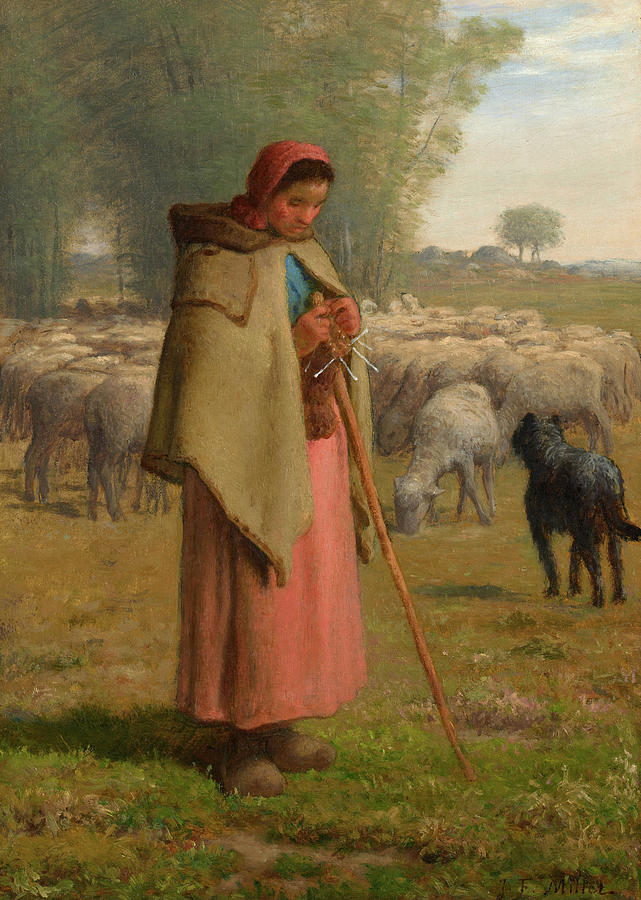
In Western culture, the label “sheep” has morphed into an insult and often aimed at religious people– particularly, Christians. Critics call us “sheep” because they claim that we don’t, won’t, or can’t think for ourselves.
I am proud to be one of Christ’s sheep. I follow Him. I’ve come to know His voice. And His voice speaks all truths—leading me in the right direction.
Got peace?
I first heard this song during the Christmas program in my daughter’s Utah ward. I love the lyrics; they bear a powerful testimony of our Savior Jesus Christ.
“Learn of me, and listen to my words; walk in the meekness of my Spirit, and you shall have peace in me” (D&C 19:23).
“Peace in Christ,” from Peace in Christ (2018 Mutual Album)
Written by Nik Day, Sung by McKenna Hixson
Lyrics:
There is peace in Christ
When we learn of Him
Feel the love He felt for us
When He bore our sins
Listen to His words
Let them come alive
If we know Him as He is
There is peace in Christ
Chorus:
He gives us hope
When hope is gone
He gives us strength
When we can’t go on
He gives us shelter
In the storms of life
When there’s no peace on earth
There is peace in Christ
Second Verse:
There is peace in Christ
When we walk with Him
Through the streets of Galilee
To Jerusalem
Mend the broken hearts
Dry the tear-filled eyes
When we live the way He lived
There is peace in Christ.
SHEET MUSIC: https://www.churchofjesuschrist.org/y…
LYRIC SHEET: https://www.churchofjesuschrist.org/y…
“Why look for the living among the dead? He is not here. He has risen.“
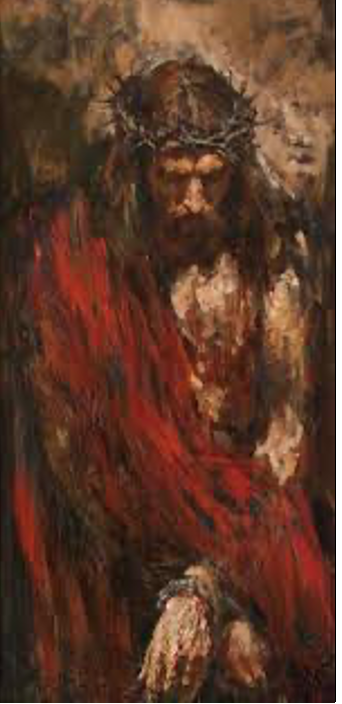
Because Christ willingly descended below all things, He also ascended above all things. And through Him, I too, can ascend.
Got art?
Elder Ulisses Soares
“Pietà.”

September 13, 2020 , BYU Devotional talk: Becoming a Work of Art
I love Elder Soares’ observations here. My husband and I saw this wonderful treasure back in 1993. During that trip, we marveled at the ingenuity and genius of Renaissance artists in painting, sculpture, and architecture. Their skill and craftsmanship are unparalleled. And even more amazing, their tools were primitive.
Much of Renaissance art and architecture were dedicated to God. Many artisans spent their lives in devotion to creating masterpieces for purposes in glorifying God. I believe God inspired them to inspire us to glorify God individually and collectively.
Like Elder Soares, I testify to Christ’s ability to construct, carve, forge, assemble, crystallize, cut, cast, whittle, build, embody, frame, mold, shape, bend (the list is endless) each of us into perfected masterpieces—but only if we willingly submit to The Master’s hands and allow Him to do His marvelous work upon us.
#TheMaster #TheUltimateArtisan
Below are excerpts from Elder Soares’ talk:
One of Michelangelo’s most famous sculptures is called the “Pietà.” It is located in St. Peter’s Basilica in Vatican City. This statue portrays the scene of Mary, the mother of Jesus, seated with Jesus Christ, her son, laying in her arms after having been taken down from the cross. Mary’s countenance expresses profound sadness for the suffering that she has experienced, and the face of Jesus expresses the suffering He had accumulated after having borne the arduous burden of taking upon Him the sins of the world and being nailed to the cross. It is a work of art that depicts the authenticity of the physical and emotional details of a scene of suffering.
Michelangelo used basically two main tools to accomplish his works of art: a hammer and a chisel. It is truly incredible to imagine how someone could create such an enormous and beautiful work of art from a piece of raw marble using these two tools. When I think about the works he produced and the results he achieved, I think figuratively about the wonderful plan of love our Heavenly Father developed in consideration for each of us and for what He hoped we might become when He sent us here to earth.
Figuratively, we all have the potential to become beautiful works of art in the Lord’s hands. In this sense, He is the sculptor and He uses a hammer and chisel to mold us through our experiences day by day. If we allow the Lord to shape us, the result will be wonderful. I bear my sacred testimony that Jesus Christ is our Savior. He gave His life so that we might repent and change our character.
Feeling sick?
Call upon the Great Physician. The Great Healer!
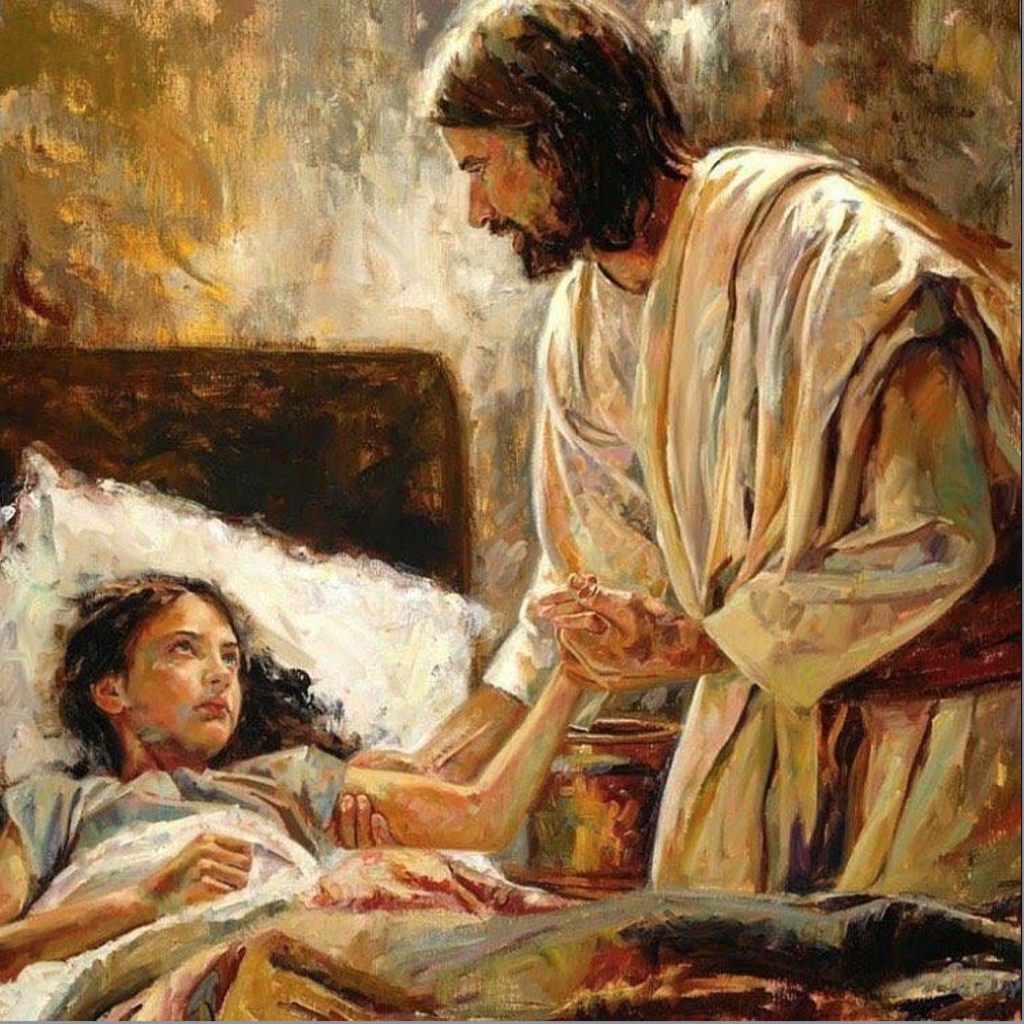
This poignant painting speaks to me on so many levels. The Savior is the great healer and physician.
When my daughter, Erica, was pregnant with her first child, she was hospitalized for six weeks due to premature labor. Simultaneously, her husband, Gustavo, had an allergic reaction to some medication so was upstairs in the intensive care unit in the same hospital.
On the brink of complete emotional exhaustion and despair, Erica asked me to attend the hospital’s Sacrament meeting service with her. As we sat in the small hospital chapel, surrounded by sick and dying people who had come to worship with us, Erica and I felt deeply humbled by what we saw and heard. Some of the sick had been rolled into the chapel as they lay on their gurneys along with their attached IV’s. Others came in their wheelchairs. Still others, were terminally ill. I admired their faith and determination to come and worship Jesus Christ and partake of His holy sacrament regardless of their physical conditions.
At the close of the meeting, the bishop testified, “Jesus Christ walks the halls of this hospital. He is the great healer.”
Erica and I felt the power and truth of his words. And we exited that holy meeting feeling emotionally stronger and more resolute because of the Savior’s ability and willingness to heal hearts, minds, and broken bodies.
#hehealsthehurt #hehealsmedaily #hehealsthebrokenhearted
Need inspiration?
I created this video of paintings that depict Christ as the great Physician and Healer:
Need to walk on water? Get out of the boat!
In the middle of every one of my life’s storms, the Savior is with me, saying, “Julie, peace be still.” And I am still. He is my North Star. He is my true compass. He is my guiding light.
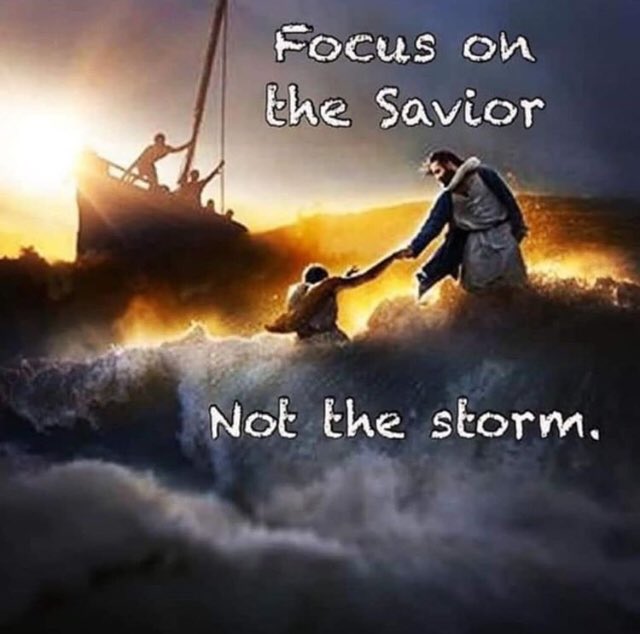
Seeding, Growing, & Sustaining Faith
Need your own Sacred Grove?
Why lean on another’s faith (or lack of) when you can grow your own?

My daughter, Erica, served her LDS mission in the New York, Rochester Mission. During the warmer months, she served as a missionary tour guide for the Latter-day Saint Church historical sites. My husband and I, along with our daughter, Cristi, and her husband, Zach, flew to New York to accompany Erica home at the end of her mission. During our trip, Erica gave us personal tours of these sacred sites. According to Erica, the Sacred Grove probably looked like this (in the above photo) when Joseph Smith had his First Vision in “early spring.”
Dear readers, I finally seeded and grew my own post inspired by the above photo. To access the full post, here’s the link:
https://hawkerfamily.com/part-2-suffering-crisis-of-faith-grow/
#thesacredgrove #seedingandsowing #faithisaseed #watchitgrow
Got questions?
Are you struggling with unanswered questions regarding your faith? This Brigham Young University professor gives excellent insights using metaphors and analogical reasoning.
Got doubts?
There can be certainties in our faith.
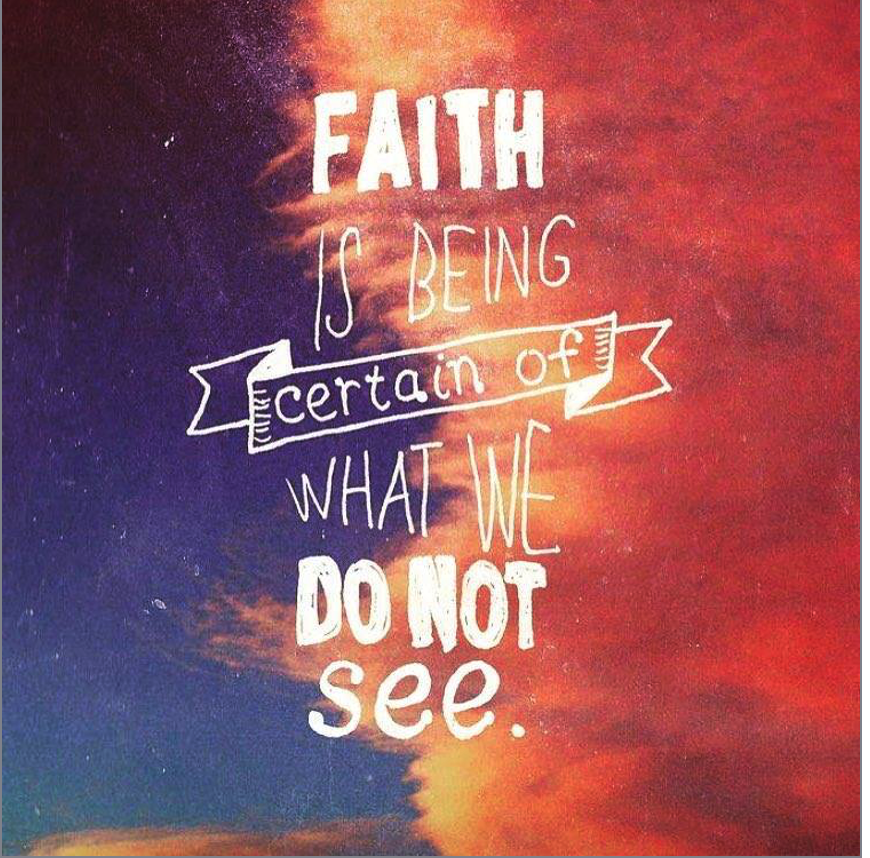
Radical faith takes us to radical heights!
#spiritualeyes #faithisnotforsissies
Got Faith?
Critical Thinking & Faith Can Co-Exist

Many people think that faith and logic cannot coexist. Yes, they can. Christ is the ultimate critical thinker! #faithandreason #religionandsciencecancoexist
“How do you define critical thinking?” I ask my students in a beginning-of-the-semester discussion and assignment. I always enjoy reading and listening to their ideas. Some responses make me smile:
- You can’t be a critical thinker and be religious.
- Those old Christian white men in Congress better keep their hands off my body (meaning access to abortion).
- Christians are hateful.
- Republicans are basically insane.
- I’m very open-minded and non-judgmental. (In the next paragraph this student judges and condemns groups with whom she disagrees.)
- Religion is for weak minded people.
- Religious people are irrational.
- My parents are incapable of thinking critically. (Young people have been making this claim since the Stone Age.)
- Religion is the cause of all world problems.
- Those crazy Christians…
- My grandparents are conservative so they’re closed-minded.
- My parents are religious which means they’re narrow-minded.
- We need to get the old white Christian guys out of government.
- My parents believe in religion but I don’t. I’m afraid to hurt them, so I go along with it for now. (This was written by a Hindu male.)
From the above student responses, we can see that much of my students’ criticism is aimed at faith and/or religion (specifically Christianity) because of its oft times oppressive influence in European and American history and culture. Surely, Christianity and other religions have engaged in their own terrible brands of bigotry, sexism, and racism. But, I don’t adhere to the belief that faith and religion is all that’s wrong with the world.
Jay Verlinden, the author of my course textbook, defines critical thinking:
The active application of principles of reasoning to your own ideas and those of others to make judgments about communication and reasoning, to analyze arguments, to expose underlying assumptions, to achieve better understanding, and to approach the truth (Critical Thinking and Everyday Argument, p. 26).
Nowhere does the above definition demonize faith or religion. However, many of my students question the concept of faith in God or religious belief because it contradicts the decades of increasing secularization of European and American institutions including education and society in general. (Please note: I don’t think that secularism is inherently wrong or evil. My point is this: Any ideology, faith-based religious or secular, can be used as an authoritarian and/or totalitarian tool to oppress others.)
It’s not surprising that many of my students believe faith and reasoning cannot co-exist. In fact, many of them claim that faith-based viewpoints and religious voices don’t even belong in the public square of inquiry and debate—let alone in helping to determine public policies within a democracy. Religion and faith, according to them, has no place in America unless its practice takes place behind private closed doors.
Now, after I’ve been teaching critical thinking for the past 22 years, I add my own criteria for thinking critically:
- Faith and/or religion and critical thinking can be compatible. I’ve encountered a lot of closed-minded secularists and atheists who consider themselves to be open-minded.
- A person can attain a lot of knowledge while attaining no wisdom.
- Tolerance does not equate to thinking critically. Neither does intolerance.
- Passing judgment often requires thinking critically. The same can be said about not judging.
- Dissent can, but does not inherently equate, to critical thinking.
- Conformity or compliance can, but does not inherently equate, to critical thinking.
- Traditional viewpoints and critical thinking can be compatible.
- Liberal/conservative viewpoints and critical thinking can be compatible.
- Kindness, compassion, and empathy are not necessarily inherent components of critical thinking. Humility is. Humility supersedes but breeds kindness, compassion, and empathy.
- Persecuting or verbally assaulting others in the name of compassion, tolerance, or kindness is still persecution and verbal assault.
- Aligning to a particular political party doesn’t necessarily equate to thinking critically.
- Cynicism or suspicion or entitlement do not equate to thinking critically.
- Critical thinking takes humility. Prideful arrogance is the antithesis to critical thinking. I’ve read many academic articles written by seemingly arrogant and/or insular scholars. Some religious leaders and their followers (including Latter-day Saint leaders/members) are often seen by others as arrogantly prideful).
- Those who think critically understand that they don’t know everything nor do they pretend to know.
- Critical thinking takes grace. It is often an act of grace.
- Critical thinking takes courage—the courage to be wrong, to be right, to be mistaken, and to admit mistakes.
- Critical thinking requires us to challenge our own assumptions and the assumptions of others.
- Critical thinking takes maturity and discipline.
- Critical thinking requires listening.
- Critical thinking understands that the ends don’t necessarily justify the means.
- Critical thinking can be a form of peacemaking.
- Critical thinking is rigorous and constant. All of us, at one time or another, may be too busy, too overwhelmed, or even too lazy to fully engage the process at any given time. (For example, studying issues, political candidates and then voting.)
Christ is the ultimate critical thinker. Honing our discipleship increases our ability to thinking critically.
Courage & Inspiration
Got rules?
Sometimes, a commercial or advertisement becomes a work of art, an inspiration, a motivation, an insight, a revelation . . . or whatever activates our inner power switch.
The lyrics of the featured song, “It’s the Last Good-bye, I Swear,” serve as a potent subtext in framing the dark and lonely images. The ending tagline is especially inspiring: “It’s what you do in the dark, that puts you in the light.”
In its historical context, this advertisement pays tribute to Phelps’ Olympic achievements: He’s won a total of 28 medals at the Olympic Summer Games in Athens, Beijing, London, and Rio de Janeiro. Before his comeback at the 2016 Olympics, Phelps fought personal demons including depression, suicidal feelings, a DUI, and rehab. His need for focus and meaning in his life motivated Phelps to make an astonishing comeback at the 2016 Olympics. Consequently, his additional gold medals made him the most decorated athlete in Olympic history—finishing his career with 23 gold medals and 28 overall. Furthermore, his performance in the Rio Olympics was unique in his win of multiple gold medals at 31 years old—well beyond the typical peak for male swimmers. His victory set the record for the most medal wins by any Olympic athlete making him the greatest Olympian of all time.
Soon after this video became public, my son, Steve, sent it to me, and we talked at length about the advertisement’s ability to resonate with viewers on so many levels. Since then, I’ve watched it many times when I feel a weakening resolve in my work (and it is work) in refining and transcending my spiritual and emotional self. In my previous blog post, I wrote about the strength and endurance required to overcome negative mindsets and destructive coping patterns passed down from one generation to the next. Moreover, suffering and struggle is part of our mortal experience. Disciplining and transcending our physical and emotional selves is an individual trek. And if we are to make progress, we must constantly hike uphill. Our work is often done in isolation and in the dark. The more we resist the work, the more stuck we become. And as we can see in this video, no one can do the work for us.
Thankfully, we have the atoning power of Christ to help us climb and conquer our mountains–or swim in our stormy seas. He helps us get back up no matter how far we fall, how badly we stumble, or how long we sit and refuse to move. However, we are the ones who still must decide how hard we want to work; how far we want to go, and how much we want to achieve spiritually, emotionally, and temporally during our mortal lives. Through Christ, we have the power to do it. And with and through Him, “What we do in the dark, puts us in the light.”
#ruleyourself #victoryoverself #climb #persevere
Got guts?
Courage under fire
I was surprisingly moved by this video.
The marchers are German Catholic Pro-Lifers.
Their courage inspires me.
They respond with dignity while being surrounded by anger and hate.
They epitomize grace.
Good thing I don’t speak German. Yikes!
Feeling imprisoned?
Alexander Solzhenitsyn
I finished reading Soviet dissident and political prisoner Alexander Solzhenitsyn’s The Gulag Archipelago. It should be required reading for high school or college students.
I hear many say, “This will never happen here in America.” But it is happening. Here and now.
Listed below are some of Solzhenitsyn’s points that resonate with much of today’s social, academic, and political discourse:
1. “To stand up for the truth is nothing. For truth you have to sit in jail.” (This principle also applies to present-day unpopular ideas, speech and cancel culture.)
2. “There’s always this fallacious belief: ‘It would not be the same here; here such things are impossible.’ Alas, all the evil of the 20th century is possible everywhere on earth.”
3. “A submissive sheep is a find for a wolf. People arrested were guilty of nothing and thus unprepared to put up any resistance….they (the Organs) are leading you. After your arrest you still believe resisting will just make your situation worse, and it will make it more difficult for them to sort out ‘the mistake.'” (People were so brainwashed they stayed loyal to the ideology right up to their own arrests and on into prison–thinking it was all “a mistake.”)
4. “You keep silent for fear they will punish you. They arrested your neighbor, your comrade at work, your close friend. You pretend not to notice…or you join with the chorus of the accusers to deter attention from yourself.”
5. “The lie as a form of existence. It’s the only safe form of existence. There exists a collection of ready-made phrases, or labels, a selection of ready-made lies. And not a single book–be it scientific, journalistic, critical or ‘literary’ can exist without the use of these primary cliches. In the most scientific of texts it is required that someone’s false authority or false priority be upheld somewhere, and that someone be cursed for telling the truth; without this, academic work cannot see the light of day. And what can be said about those shrill meetings and trashy lunch-break gatherings where you are compelled to vote against your own opinion, to pretend to be glad over what distressed you? In prison, Professor Tenno recalled with shame how two weeks before his own arrest he had lectured on ‘The Stalinist Constitution–The Most Democratic in the World.’ Of course not one word of it was sincere.”
6. “Why did we stand for it? Because it is . . . a succession of tyrannies.”
He ends with this warning to the West (Yikes!):
All you freedom-loving ‘left-wing’ thinkers in the West! You left laborites! You progressive American, German, and French students! As far as you are concerned, none of this amounts to much. As far as you are concerned, this whole book of mine is a waste of effort. You may suddenly understand it all someday–but only when you yourselves hear, ‘Hands behind your backs there!’ and step ashore on our Archipelago.“

Tyranny comes in many forms.
Anyone has the capacity to become tyrannical.
Tyranny is not confined to religion.
Tyranny is still tyranny even if it’s “for the greater good.”
Tyranny is an equal opportunity and equitable destroyer.
Got limits?
Get rid of them!
I’ve been following this wonderful man for years. Talk about turning our suffering into a force for inspiration! No suffering goes to waste if we use it to help and inspire others.
Suffering can be purposeful.
In pain?
Hardships & Trials = Strong & Often Overwhelming Emotions

Baltimore man had forgiven an anonymous shooter who nearly killed him. Then fate stepped in again
www.foxnews.comDamion Cooper thought he’d finally forgiven his unknown shooter. Then he found himself sitting across from the young man while volunteering in a Baltimore prison.
Got fire?
Get a fire in your belly.
(Meme by Raheem Kassam April 27, 2020)

I get that the late Andrew Breitbart was a controversial figure.
Still, I’ve always loved this quote.
And Breitbart’s mindset provided his courage for his convictions.
I am inspired by real, unfeigned courage.
I admire and respect those who willingly undergo great personal sacrifice for their moral convictions.
Today, people casually toss around labels like “brave” or “courageous” at anyone who defies cultural or societal norms.
Surely, there’s nothing inherently wrong with aspiring to be “different.”
For me, however, if the motivation for such “bravery” seems grounded in self-aggrandizement, self-pity, or attention-seeking behavior, I’m not inspired.
The coming days will require increased courage from those who profess and adhere to Christian discipleship. (In some parts of the world, Christians are sorely persecuted, tortured, and killed.)
We all innately desire approval, popularity, and love.
True discipleship requires us to ultimately shed these desires and seek only Christ’s approval.
At some point, that will mean upholding unpopular opinions and following and defending “unpopular” opinions or controversial leaders.
It won’t be easy; our detractors and enemies will know this.
They won’t like or approve of what we do, what we say, or who we are.
Still, I believe they will hold a grudging respect for those who display courage—even while they attempt to disparage or destroy us.
Today’s “cancel culture” is a mob mentality minus the pitchforks and torches. Regardless, finding oneself in the cross-hairs of a threatening and sanctimonious mob is frightening and intimidating.
Years ago, I decided I’d rather be respected than liked—regardless of the personal cost. I know; it’s easy to write this from my comfortable keyboard. Still, I hope that in making this decision, I can follow through when circumstances call for personal courage.
#convictionandcourage #lineoffire #inspire #Christiandiscipleship
Got a hammer?
Nailed it.
Martin Luther nails his “95 Theses” to the door of the castle church in Wittenberg, Germany in 1517 ushering in the Reformation.
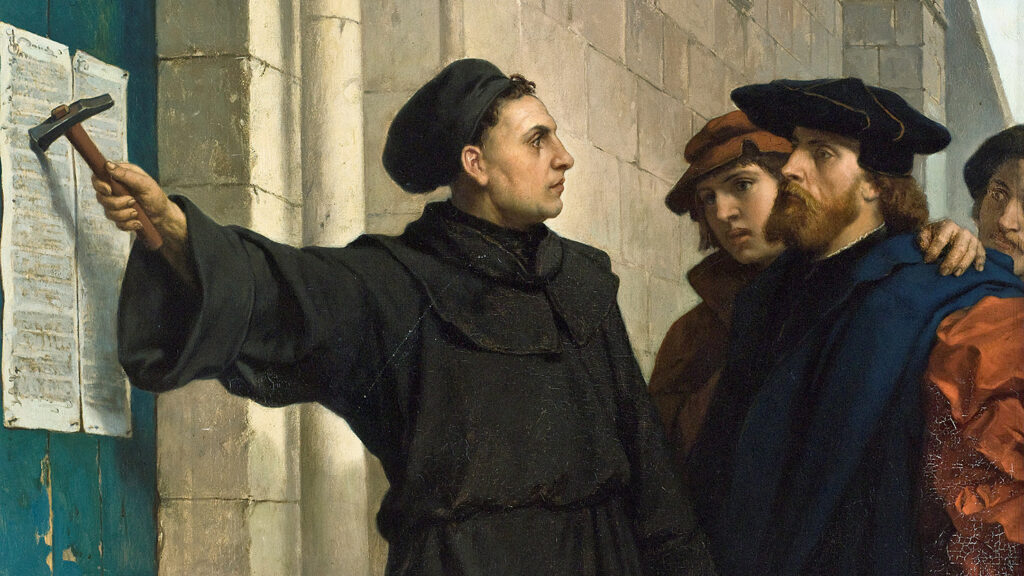
I had forgotten this historical event shares the same date with Halloween.
I’ve always admired Martin Luther’s courage in confronting the corruption of the Catholic Church and thus birthing the Reformation—which eventually helped to paved the way for Joseph Smith in his role in the restoration of this last dispensation.
I quote from the “Family Gathering” website:
On October 31, 1517, Martin Luther nailed his Ninety-five Theses to the church door in Wittenburg, Germany. The reformation of Faith changed the world and led to the restoration of the Gospel in our day.
Martin Luther said this about his mission:
I have sought nothing beyond reforming the Church in conformity with the Holy Scriptures. … I simply say that Christianity has ceased to exist among those who should have preserved it.
(E. G. Schweibert, Luther and His Times: The Reformation from a New Perspective [1950], 590).
Happy Halloween, everyone! I had a fantastic one trick-or-treating with my grandkids!
Feeling the tumult?
Dealey Plaza, Dallas, Texas
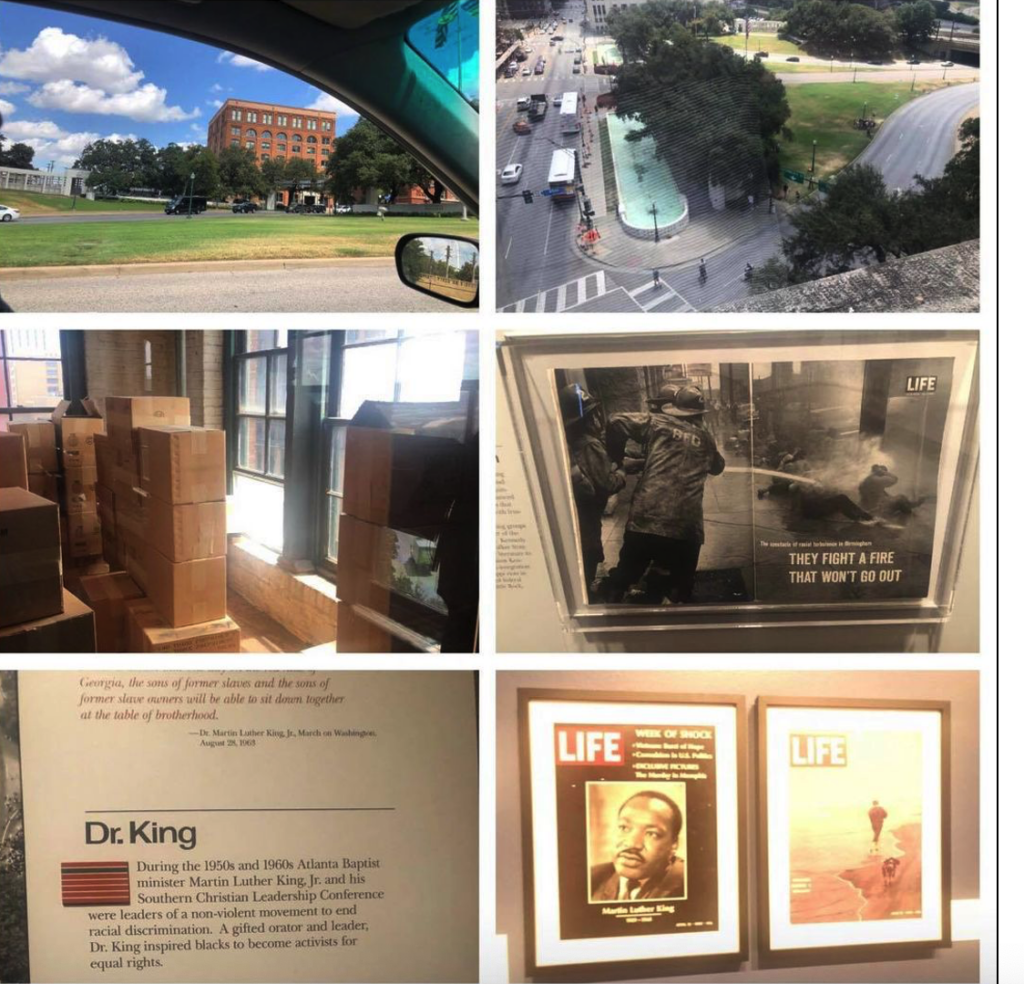
A sobering experience today for my husband and I. We visited Dealey Plaza where President John F. Kennedy was assassinated. At that time of his death, I was 5-years-old and remember my mother crying as we watched his funeral procession on tv. The 6th floor book suppository building (where Lee Oswald fired the fatal shots) is now a historical museum.
I get that recorded and accurate historical markers are important for remembering history. Still, I was taken aback by the two X markers painted on the Elm Street pavement identifying the exact locations where Kennedy was shot. In the book suppository window (clearly visible from the street), a white poster with a black dot marks the spot where Oswald stood as he took aim and shot the President.
I also remember the assassinations of Robert F. Kennedy and Martin Luther King, Jr. five years later. My parents were avid readers of Life and Time magazines, so as a child, I remember staring at the covers of these particular issues pictured above. Along with the Vietnam Nam war protestations and student riots, I couldn’t understand and was fearful of the societal divisiveness and anger.
Times have changed, yet times have not changed. Americans are more divided than ever. Back then, most, if not all Americans believed in America’s moral legitimacy as a nation and its institutions. Today, many Americans question and/or condemn America’s institutional foundations along with America’s right to exist as a nation. I also wonder if MLK and his methods in fighting for civil rights would be accepted or embraced in present day America. As a Christian preacher who eschewed “the ends justify the means” approach and its accompanying violence, MLK might be considered too religious and too “soft” by today’s standards. Death by assassination often elevates activists and leaders to iconic status.
Forgive my philosophical meanderings. Regardless of societal divisiveness, I’m still grateful to have lived this long and have learned so much in these tumultuous times.
Prophets, Apostles, & Disciples
Got radical faith?
Peter had it.

Out of all the ancient apostles, I feel the greatest kinship to Peter. Like all of us, he was full of contradictions: brave and fearful, impetuous and hesitant, loyal and inconstant, full of faith and full of doubt.
Still, as he watched Christ walk atop the turbulent sea, Peter was the only apostle who had the faith and temerity to get out of the boat and onto the water. Ok, so he eventually sank. But, at least he got out of the boat.
I’m striving to do the same. Sure, I’m getting wet (well . . . drenched) in my attempts to walk on water. But, I’d rather take my chances in the water as I walk toward Christ than to stay dry and “safe” in a boat that will sink in a storm. And thanks to Peter’s literal and figurative example, I know Christ will save me from drowning.
#christisourlifesaver #wecantwalkonwaterunlesswegetoutoftheboat #waterwalker #sothanksfulforancientandmodernapostles
He is risen!
The Disciples Peter and John Running to the Sepulchre on the Morning of the Resurrection by the artist Eugene Burnard
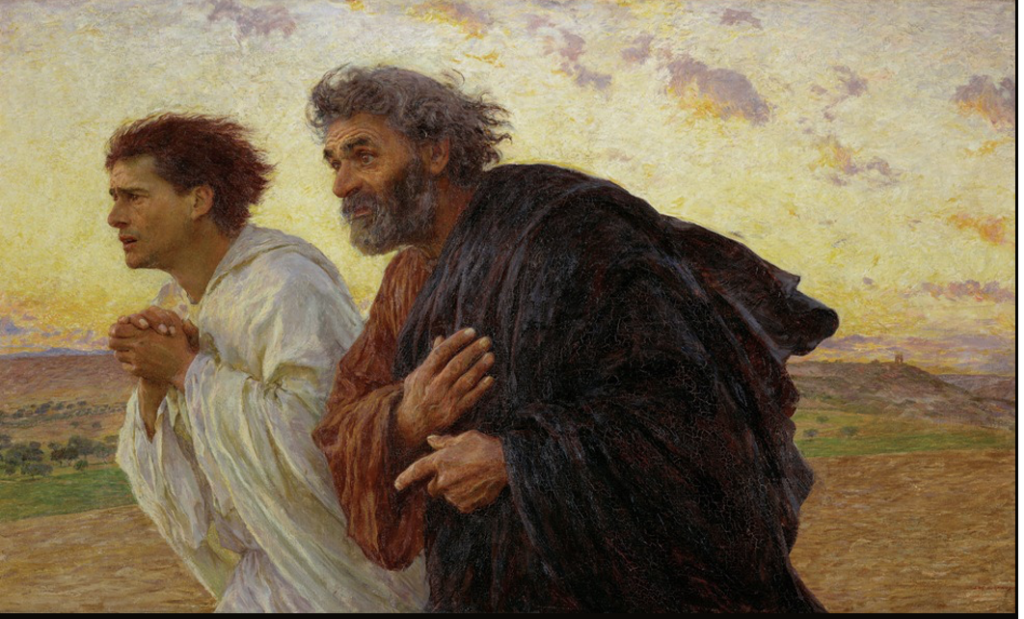
(Originally posted in April, 2020.)
During this Easter season, this beautiful artwork expresses my feelings as the world suffers from the Covid-19 pandemic. Through our prayers, our fasting, and our faith, we seek and will find the Savior of the world—to heal, to bless, and to love us. He lives. And though we die, He still lives. His atonement and resurrection assures us that we can live with Him eternally.
Writer Elise Erhard, in her article, “The Greatest Easter Painting Ever Made,” gives an insightful critique of Burnard’s work:
Tucked away in a central Parisian museum that was once a railway station, there hangs an Easter painting quite unlike any Gospel masterpiece created before or after it. It is not painted by a Rembrandt or a Rubens or the patron saint of artists, Fra Angelico. The painting is the work of a little-known Swiss painter. For those who make a trip to see it, viewing the canvas is a special spiritual experience in their lives.
The work does not even show the risen Jesus. It merely portrays two witnesses, Jesus’ oldest and youngest apostle. The youngest who was the only man brave enough to stay by Jesus’ cross and the only one who did not die a martyr’s death as a result of it. The oldest apostle who first denied Jesus in fear, yet ultimately chose to be crucified upside down by the Roman authorities rather than deny Christ’s resurrection.
In ‘The Disciples Peter and John Running to the Sepulchre on the Morning of the Resurrection’ by Eugène Burnand, John clasps his hand in prayer while Peter holds his hand over his heart. The viewer feels the rush as their hair and cloaks fly back with the wind. They are sprinting towards discovery of the moment that forever altered heaven and earth. As you look at it, engage for a moment in what the Catholic blogger Bill Donaghy calls ‘the visual equivalent of Lectio Divina.’ As Donaghy notes, ‘This Resurrection scene does not put us before still figures near a stagnant stone, or figures standing with stony faces in a contrived, plastic posture, pointing to an empty tomb. This scene is dynamic; we are in motion.’
Through the movement and immediacy of the scene, the preceding minutes with Mary Magdalene are palpable. In a sense, she is in the painting too. ‘You can almost hear her voice in the background, can you not, a few minutes earlier, as she burst into their house…’ writes the Episcopal Bishop Dorsey McConnell in an Easter sermon meditating on the painting.
Look into Peter’s wide open eyes and John’s intense gaze. Their eyes contain a mix of anxiousness and hope, the way a parent or grandparent’s eyes look at the news of an impending birth. A new life is about to emerge, but there is still uncertainty because it is a mystery beyond full human comprehension or control. Peter and John’s faces capture the same sense of anticipation.
Burnand created a sparse, simple painting capturing two of the most important players in the greatest story ever told. Meditate upon their faces as Burnand intended you to do and through them discover the empty tomb.
https://www.crisismagazine.com/2014/the-greatest-easter-painting-ever-made#.U1E5JDaxciQ.wordpress
Got counsel?
President Russell M. Nelson
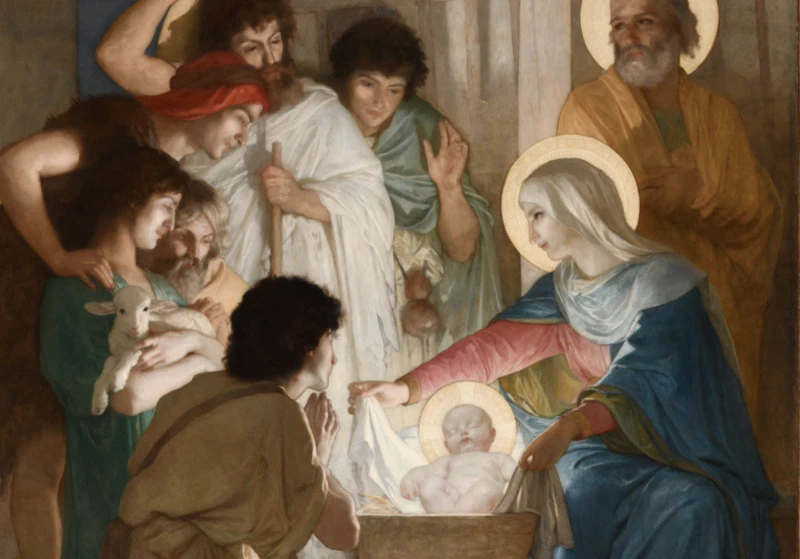
I love President Nelson’s insights. Perhaps this special star will be a personal sign of hope for all of us who are seeking Christ, His healing, and His answers to our prayers. President Nelson says:
Tonight, December 21, is the winter solstice, regarded in many traditions as the darkest and longest night of the year. How fitting that astronomers and scientists are predicting tonight’s appearance of a ‘Christmas star,’ formed by the great conjunction of Saturn and Jupiter, a rare event not seen in nearly 400 years.
While we don’t need to ascribe any special meaning to the actual phenomenon, tonight’s Christmas star will undoubtedly draw our minds and hearts to the original star that appeared in the heavens to mark the birth of our Savior Jesus Christ. For the shepherds in Judea, for the Wise Men, and for the believers in the New World, the star brought more than mere physical light—it brought hope.
My dear friends, as we near the end of a challenging year, one that may feel to many as a time of uncertainty and darkness, let us never forget that the light of hope still shines brightly. Jesus Christ is the light, the life, and the hope of the world. As we turn our hearts to Him, He will pour out His love for us in unmeasured ways. I wish you all a very merry and hope-filled Christmas season.
#LightTheWorld December 21, 2020
Got issues?
Elder Jeffrey R. Holland

I cannot say enough how much I love this man!
#thespiritualityofimperfection #elderhollandrocks #generalconference2017
Elder Holland said:
I hear many who struggle with this issue: ‘I am just not good enough.’ ‘I fall so far short.’ ‘I will never measure up.’ I hear this from teenagers. I hear it from missionaries. I hear it from new converts. I hear it from lifelong members.
I believe in God’s perfection, and I know we are His spiritual sons and daughters with divine potential to become as He is. I also know that as children of God we should not demean and vilify ourselves, as if beating up on ourselves is somehow going to make us the person God wants us to become in eternity. No!
With a willingness to repent and a desire for increased righteousness in our hearts, I would hope we could pursue personal improvement in a way that doesn’t include getting ulcers or bulimia, feeling depressed, or demolishing our self-esteem. That is not what the Lord wants for children or anyone else who honestly sings, ‘I’m trying to be like Jesus.‘
I testify of that very Jesus, who Himself continued ‘from grace to grace’ until He received in His immortality a perfect fulness of celestial glory. I testify that in this and every hour He is, with nail-scarred hands, extending to us that same grace, holding on to us and encouraging us until we are safely home in the embrace of Heavenly Parents.
Got speech?
President Dallin H. Oaks
Elder Oaks’ speech at Claremont Religious Freedom Conference, delivered Friday, March 25, 2016, at Claremont Graduate University:
As a scholar and former Utah Supreme Court judge, President Oaks has serious “street cred.” He was president of Brigham Young University, Provo when my husband and I were students there in 1978 and 1979. President Oaks is an eloquent and elegant voice for a topic that is deeply important to me: the steady encroachment upon religious liberty and religious voices in the public square. Many inside (and outside) academia have come to equate Christian voices to “hate speech” which should therefore be socially shamed or silenced.
A growing number of people claim that Christianity is the genesis of Western oppression and colonialism. During the 22 years I have been teaching argumentation and debate college courses, I see a growing number of students show open hostility toward Christians and Christianity. One student told me that she wanted “the old white Christian men to get out of Congress.” Surely, many self-proclaimed Christians have participated in historical atrocities. Still, Christianity as a philosophy and a religion, has also facilitated much good in the world.
Dr. Albert Mohler, President of The Southern Baptist Theological Seminary, gave a speech to Brigham Young University (Provo) students a few years ago. His concerns echo mine when he said:
While Mormons and Evangelicals are divided theologically, we share common concerns and urgencies about unprecedented and ominous attacks” on religious freedom. I was shocked when he said, “I do not believe that we are going to heaven together, but I do believe we may go to jail together.
Yikes. I’d never thought about the jail part—but he’s right. Since then, I’ve repeatedly pondered this idea. How far am I willing to go for my religious rights—and the religious rights of others?
During a recent visit to Santa Cruz (California) with my son and his family, I was disheartened and frustrated as I listened to a hostile crowd attempt to shut down a Christian street preacher. One man was yelling at the nearby cops to arrest the preacher for “hate speech.” The “debater” part of me could no longer hold back; I yelled back to the crowd, “Free speech rocks!” One man responded to me with an “Amen!” while another woman told me that the children (meaning teenagers who were heckling the preacher) should be protected and shielded from the preacher’s views. I also thanked the cops for refusing to arrest the preacher and protecting his right to speak.
I also had a similar encounter a few years ago in San Francisco—again involving a Christian “street preacher.” As another man bullied and heckled him, I yelled to the preacher that I respected his courage regardless of his views. I have actively sought to be a peacemaker, but I’ve also decided that if need be, I will take to the streets and even go to jail for my right and the rights of others pertaining to religious liberties. When necessary, I defend the free speech rights of religious (and other) voices in my classroom when these issue arise. There’s no question that in the years to come, the growing vitriol will increasingly spill out onto the streets and coupled with violence.
And sooner, rather than later, all religious people will be impacted by this issue.
Got courage?
Women’s Conference: President Russell M. Nelson
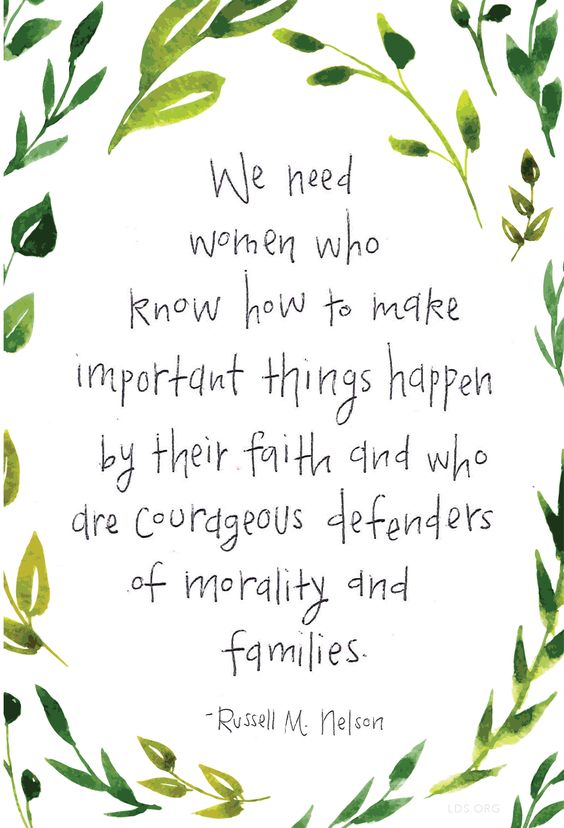
President Nelson’s talk at the Women’s Conference was one of his most powerful.
Our Prophet is placing increasing emphasis on personal spiritual autonomy through personal revelation and priesthood covenants.
Moroni challenged us to know for ourselves “the truth of all things.” I can testify to the power of this principle. My strong faith comes from a constant and direct access to God while utilizing the strength and healing power of Christ’s atonement. As a result, my faith does not depend on church policy, church history, doctrine, leaders, or whatever negative information is found on the internet. And, I believe unwavering faith and spiritual autonomy is what President Nelson wants for all of us.
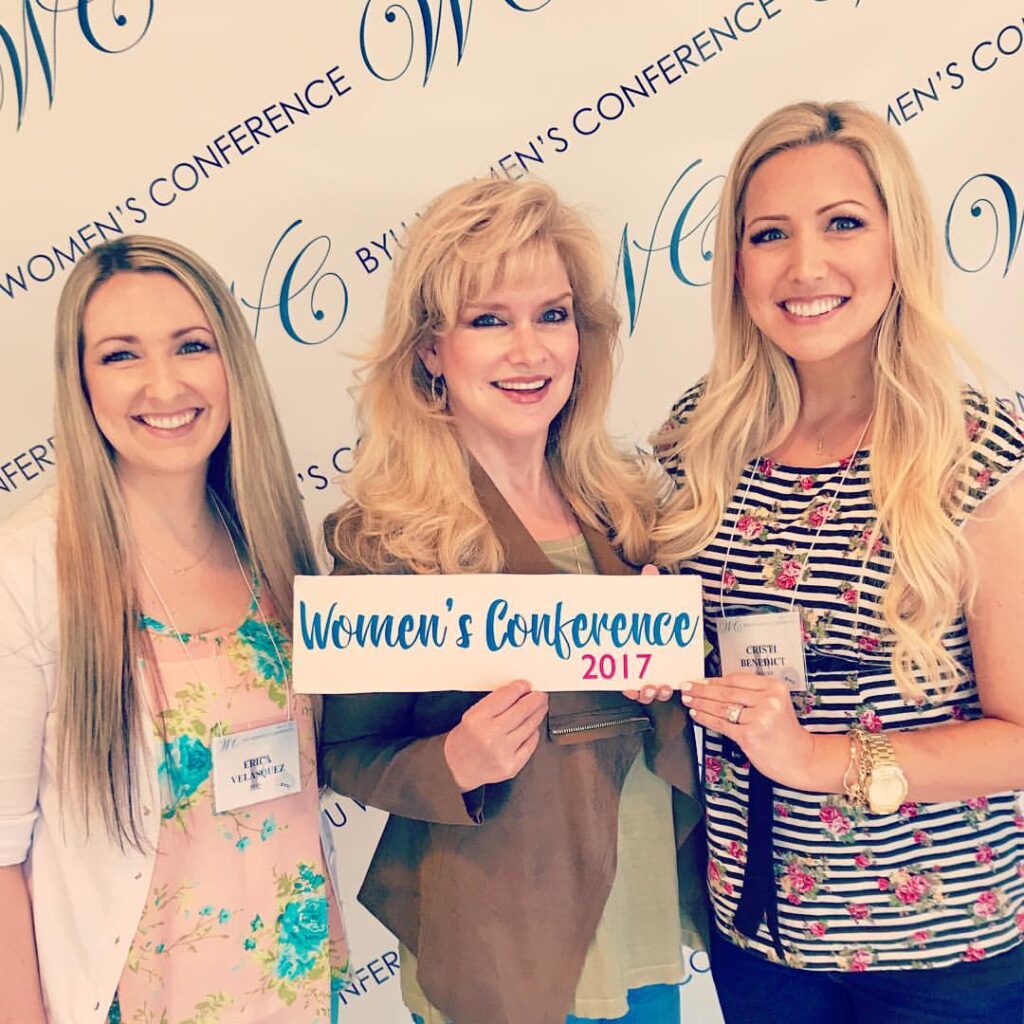

With my daughters at BYU’s Women’s Conferences
Got conference?
“Come listen to a prophet’s voice.”
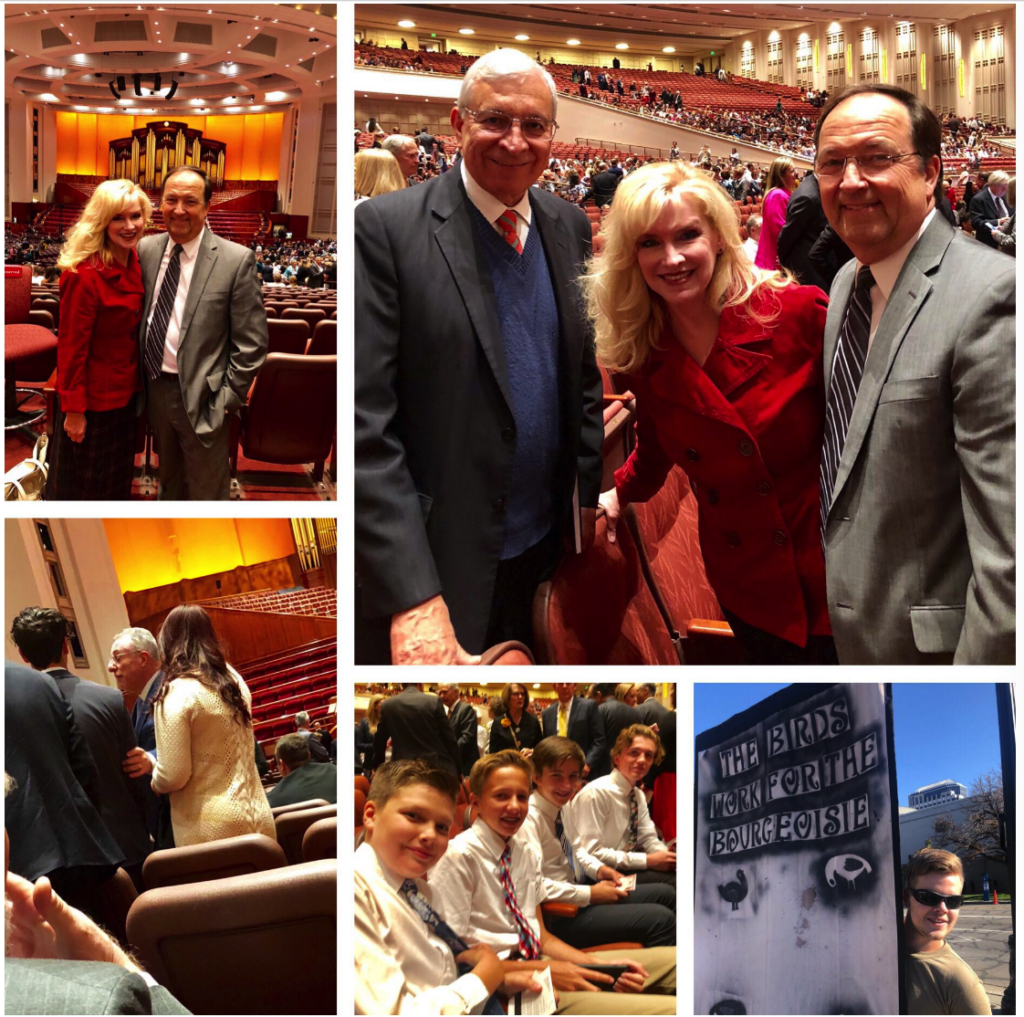
What a wonderful Sunday afternoon session at The Church of Jesus Christ of Latter-day Saint conference! Outside around the Conference Center, protestors and counter-protestors created a carnival-like atmosphere as they chanted and waved around their signs. Other people lined the street asking for conference tickets while another young man jokingly held up a sign that read, “Searching for an eternal companion.” Nearby, a bunch of young women in a car laughed and shouted to the guy, “We’re available!”
The conference talks comforted and inspired me. Thank you for your service as a General Authority, Elder Falabella, and providing us with such great seats! And thank you to our son-in-law (and Elder Falabella’s nephew), Gustavo, for giving us the tickets.
Pictured above: Rick and I with Elder Falabella and Elder Ulysses Soares.
I sat by these four boys who were pointing at their grandpa on the stand. I asked who their grandpa was. They said, “Elder Evans.” What a great experience for these young men!
#GeneralConference2019
Inspirational Women
Need female role models?
A few years ago, I cobbled together some of my favorite paintings of Jesus Christ and His disciples and converted them into a short video series. I also added my own comments and then posted them on Facebook and Instagram. Below are some of these videos (in random order) along with my original commentary:
Mary, the Mother of Christ
I created these videos to honor faithful women disciples of Jesus Christ. This video features Mary who birthed and mothered the Savior of the world. I’ve also included my favorite paintings of faithful women who followed and served the Savior.
What can I say about this remarkable and holy woman? I have read a few apocryphal books about Mary. One apocryphal book, called the Gospel of James claims Mary to be the daughter of Joachim and Anne. As a barren woman for many years, Anne was very advanced in years when she gave birth to Mary. When Mary was three years old, Anne brought Mary to the Temple in Jerusalem to live in service with the temple workers as a consecrated virgin until Mary’s young womanhood and betrothal to Joseph.
I have also read the apocryphal book, the Infancy Gospel of Thomas, which discusses some of the difficulties Mary had in parenting the young Jesus before he reached the accountability age of eight years old. Surely, it would be hard to parent a child who was highly intelligent and already able to exercise great power. The massive responsibility of raising the Savior of the world would overwhelm any mother. Still, Mary was no ordinary woman who faithfully fulfilled her divine mission of mothering our Savior and Redeemer.
Lastly, the ancient writer, Hyppolitus of Thebes, says that Mary lived for 11 years after the death of her son, Jesus, dying in 41 AD.
I understand that apocryphal texts are historically unreliable. Still, they give readers a glimpse into the awesome, inspirational preparation and responsibilities of these noble, chosen vessels of God.
One of my favorite scriptural verses about Mary pertains to the immediate aftermath of her giving birth to the Savior: “But Mary kept all these things, and pondered them in her heart” (Luke 2:19).
We, too, can ponder Christ’s sacred birth and His divine mission—along with His personal atoning influence in our individual lives.
Mary Magdalene
Of all the innumerable women disciples of Jesus Christ, I hold my deepest respect and admiration for Mary, the mother of Jesus, and Mary Magdalene. Raised in Magdala, Mary Magdalene was a Jewish woman who traveled with Christ throughout His ministry. She witnessed His crucifixion, helped prepare Christ’s body for burial, and was the first witness of His resurrection.
The Four Gospels mention her name 12 times—-more than any other apostle except for Peter. I’ve often thought about her initial introduction to Jesus Christ. The Books of Luke and Mark describe Mary “as possessed with seven devils” whom Christ cast out (Mark, 16:8; Luke 8:2). What exactly were the seven demons that held Mary captive? Did she suffer from a mental illness such as depression or schizophrenia? Whatever her demons, her suffering must have been terrible. When the Savior healed her, Mary’s life was profoundly changed, and she became one of His most devoted disciples.
Years ago, I read a book called, The Gospel of the Beloved Companion (also known as The Gospel of Mary), an apocryphal text about Mary Magdalene. The text originated from a Coptic translation preserved in a fifth-century manuscript and discovered in Cairo in 1896. Later, it was translated from Greek by Jehanne de Quillan. As with the “Gospel of Thomas,” these apocryphal ancient writings are not canonized scripture, but, in my opinion, are still worth reading.
The Gospel of Mary is significant because it’s the only surviving apocryphal writing named after a woman and written about a woman. In this text, Mary is portrayed as a visionary woman, married to Jesus, and anointed and given authority by Him to teach and spread the gospel. The Gospel of Mary parallels the writings of John in the New Testament. The text also emphasizes the idea that Mary understood Jesus in a way that His apostles could not.
Whether or not the Gospel of Mary is authentic, this text serves to underscore Mary’s strength, courage, and unwavering faith in Jesus Christ. His torture and crucifixion must have been unbearable for her, but she stayed with the Savior while disregarding her own safety. Her foreordained mission as the first witness to the resurrected Lord is eternal confirmation and proof of her righteousness, fortitude, and faith.
In her Ensign article, “Mary Magdalene—Tower of Strength,” Margo Hovley describes Mary’s faithfulness:
In the Gospel of John, we learn that Mary Magdalene stood near the cross, along with Mary, the Savior’s mother (see John 19:25). Whether near or far, what’s clear is that Mary felt compelled to be with the Savior as He endured immense agony and suffering. Even in—and perhaps especially in—this dark hour, her devotion to and love for the Savior were manifest. She would remain His disciple to the end. The honor of being the first person to see the Savior as a glorified and resurrected being can’t be overstated. His victory over death is the greatest event in human history, and it was Mary, humble and devoted to the very end, who was the first to see the truth of it (www.churchofjesuschrist.org).
During Christmas, and in every season, I’m so thankful for the life of Jesus Christ; for righteous male and female witnesses who walked and talked with Him, and then testified of His divinity.
Elizabeth, Mother of John the Baptist

Elizabeth was also the older cousin of Mary, the mother of Jesus. Elizabeth was advanced in years and pregnant with John the Baptist and would give birth six months before Mary. Furthermore, it was Elizabeth to whom the young and anxious pregnant Mary went for guidance during this tender time for both women.
Patricia Holland, in her 1983 Ensign article, “The Fruits of Peace,” wrote poignantly about these two women and how they exemplified a special, spiritual, and authentic sisterhood:
I have always been touched that in her moment of greatest need, her singular time of confusion and wonder and awe, Mary went to another woman. . . . It was their very womanhood that God had used for his holiest of purposes. Elizabeth is not petty or fearful or envious here. Her son will not have the fame or role or divinity that has been bestowed on Mary’s child, but her only feelings are of love and devotion. To this young, bewildered kinswoman she says only, ‘Blessed art thou among women, and blessed is the fruit of thy womb. And whence is this to me, that the mother of my Lord should come to me?’ (Luke 1:42–43).
As women, we surely have an enormous influence on each other. We know how to love, nurture, care for, uplift, praise, comfort, advise, and be each other’s soft place to fall when we are feeling needy, low, and vulnerable. But like Elizabeth and Mary, let us also be a place from which we can fly, revel, glory, and delight in each other’s great news.
(The Visitation by Raphael)
Anna the Prophetess
Most of us are familiar with Luke’s account of Simeon, an elderly temple worker, who was given the desires of his heart: to see the face of the Savior before Simeon mortal life ended. With great joy, Simeon recognized the Christ child when Mary and Joseph brought the baby Jesus to the temple to be circumcised.
Then there’s Anna. A faithful widow, who was also a prophetess, had served in the temple for many years. She, too, was spiritually prepared to meet the Christ child along with Simeon. Biblical scholar, Robin Gallagher Branch gives insight into Anna and her lifestyle:
Regarding Anna, Luke provides three terse verses that manage to vividly depict her as a woman deserving the honor bestowed on the elderly in the ancient Mediterranean world. The appositive ‘prophetess’ heads her description (Luke 2:25). In this she outranks Simeon, a man praised as righteous and devout (Luke 2:25) who may be a priest because he holds the baby Jesus. Anna is the New Testament’s only named female prophetess. As a prophetess, Anna receives insight into things that normally remain hidden to ordinary people; she recognizes who this child is and tells of His significance to selected people in Jerusalem.
Luke dwells on Anna’s advanced age . . . and her widowhood when she meets the young family. She worships night and day [in the temple], fasting and praying. Her lifestyle evidently invigorates her, for she is mobile, articulate, alert, spiritually savvy and unselfish. Luke indicates that her habits of worship, prayer and fasting represent a routine, probably one of decades. She listens to God and prays as directed. Others recognize her as a prophetess. The work of prayer indeed characterizes a prophet. Anna knows fasting brings results. With this in mind, Anna shows one model of aging in the Biblical text. Luke presents her positively, as a woman without the bitterness that may come with age and as one full of hope. As she moves throughout the Temple, no doubt she seeks to do good to those whom she encounters. Luke’s description shows her as well adjusted, engaged in Israel’s life and useful to the Lord‘ (“Bible History Daily,” Biblical Archeology Society, 2013).
During my time as a Latter-day Saint ordinance worker in the California Oakland Temple, I often thought about Simeon, but I especially thought about Anna. In fact, her example is one of the reasons I became an ordinance worker. Anna spent years preparing herself to see Christ and temple work was a large part of her preparation. I, too, seek the Savior’s face and hope one day to behold His countenance. The month of December, my first Christmas season as a temple worker, took on new meaning for me. Unlike Anna, I didn’t and still don’t yet have the luxury to serve in the temple on a full time basis. Like other Church members, I must straddle my temporal and spiritual worlds. Still, my two worlds become increasingly confluent; and will one day be singular.
Like Anna, my time in the temple furthers my opportunity for reflection and contemplation. Like Anna, I am an older woman whose children are grown and married. Like Anna, I have more time to devote to temple work. Like Anna, I know my devotion includes time as a temple worker—not “just” as temple patron. And like Anna, I’m gaining much more understanding and insight into God’s magnificent design. Someday, I hope to be as strong as Anna: instructed and prepared; a spiritually powerful prophetess who prophesies glad tidings about our Savior, Jesus Christ.
Faithful Women of the Bible
Though oft written through a patriarchal lens, history (including The Holy Bible and The Book of Mormon) offers glimpses of powerful women–-as individuals and as a collective group. In the Old Testament, for example, around 200 named women are mentioned and more than twice that number of unnamed women are referred to, but that is still a very small number when compared to the number of men named in the book—nearly 3,000. Also, The Holy Bible mentions women by name roughly 137 times which includes two books of the Old Testament—Ruth and Esther—that are named after women (Book of Mormon Central, KnoWhy, #391, December 19, 2017).
Her identity is not certain, but the humble woman who washed and anointed the Savior’s feet embodies her devotion and great love for Him:
“Book of Mormon Central” gives further detail pertaining to women in The Book of Mormon. They tell us that “. . . only six women are mentioned by name, and there are just over 150 passages that explicitly reference women.”
Regardless, named and unnamed women throughout the scriptures hold a powerful influence. For example, Abish is a heroine and servant of King Lamoni . She plays a pivotal role in a missionary work. King Lamoni’s wife, though unnamed, is loyal and shows great faith in Ammon’s priesthood power in healing her husband. Nephi’s unnamed wife pleads for his safety on more than one occasion. The unnamed mothers of the young warriors in Helaman’s army were powerfully faithful in teaching and preparing their sons.
Thus, despite cultural norms that stifled their voices, strong and faithful women were still righteously and enormously influential.
Unfortunately, the same can be said about women who used their power for unrighteous purposes. The Old Testament discusses Jezebel who instituted the worship of Baal and whose priests taunted Elijah the Prophet. We also read about the jealous Herodias who bade her daughter, Salome, to dance for King Herod. The King was so entranced by her dance he offered to grant the girl any wish. At the request of her mother, Herodias, she asked for the head of John the Baptist, which was delivered to her on a platter.
Today, women’s influential power (for good and for evil) is the greatest ever on the world stage. How are we using our individual and collective influence? The divine roles of righteous women, mothers, and exemplars to Jesus Christ illustrate the righteous, influential power of women.
Faithful Women of the Book of Mormon
Got a destiny?
Esther

I spoke in Sacrament meeting today. I based my talk on Elder Gary L. Stevenson’s general conference talk, “Be Not Deceived.” Here, he emphasizes Satan’s deception in terms of our identity and worth. We are indeed children of God. Our divine individual worth supersedes any attempts to self-identify. The Savior is our ultimate source of empowerment—not our group identity, not human-made rules or government laws, not social groups, not wealth, not status, not friends, not fame, not protests for our moral causes and activism.
I also spoke about Esther of the Old Testament. I love this story—especially the part where the villain, Haman, put forth an edict against all the Jews in Persia. As part of the royal court, Esther (a Jew) had influence with the king. But Esther’s initial fear kept her from approaching the king about the plight of her people.
Her mentor, Mordecai, challenged Esther to forget about herself and do something to stop the destruction of her people. He reminded her, “Who knoweth whether thou art come to the kingdom for such a time as this?” Knowing that she risked losing her royal position and perhaps her life, Esther accepted her mission, saying, “If I perish, I perish” (Esther 4:16).
All of us have been born “for such a time as this” with a special identity and foreordained mission. To fulfill our life’s mission, we need to find out who we really are, who we were in our pre-mortal lives, and what our special assignment is here on earth. Through personal revelation, we can find out. Let the Savior identify us and our mission individually. And through His atoning power we can have the strength and fortitude to accomplish our life’s mission.
P.S. The best part of giving my talk: Watching and hearing my little granddaughter, Savannah, shout from the back of the chapel, “Gwammy!!” My daughter finally had to take Savannah out to the foyer. 🙂
#forsuchatimeasthis #thebookofEsther #selfidentity
Got oil?
The Ten Virgins
Jesus Christ’s parable of the Ten Virgins (Matt. 25; D&C 45) becomes ever more meaningful to me as we prepare for His second coming. This parable (sometimes called a “watching parable”) is specifically directed to our generation–as individuals and as a church. The parable serves to reinforce Christ’s call for spiritual readiness in a time of upheaval and uncertainty. It also emphasizes the bridegroom’s delay, which in turn, lulls half of the virgins into complacency, passivity, and even indifference—despite their initial excitement and anticipation. The bridegroom’s sudden appearance results in their chaotic panic and then bitterness at being denied entrance to the wedding.
D&C 45:57 mentions the “wise virgins” in cautioning us against deception. They are those who “have received the truth, and have taken the Holy Spirit for their guide, and have not been deceived.” Deception can take many forms including secularism, trendy ideologies or popular opinion, pride, narcissism, self-deception, false teachers, etc. We are also counseled to avoid the assumption that our future place in Christ’s wedding chamber is unconditionally assured.
Surely, we all drift from our faith in varying degrees––and our patience and faith will be tested. For these reasons, the parable instructs us to be wise by accumulating and storing extra oil in our vessels. Extra oil requires extra work and self-discipline on our part in growing our faith, our spirituality, deepening our relationship with Christ, keeping our covenants, etc. Discipleship and spiritual preparation for the second coming is an ongoing, active, consistent process.
The apostle Paul compared his spiritual journey to a race. He wrote, “I have fought the good fight, I have finished the race, I have kept the faith” (2 Timothy 4:7). Paul leaves no doubt concerning his struggles in holding to his faith and keeping his focus on Christ. This same theme is reflected in Hebrews 12:1. The line, “Let us run with endurance the race set before us,” underscores the idea that faith is akin to a marathon and requires disciplined tenacity.
Finally, the key to a successful race or marathon is to cross the finish line. “Finisher” is one of the many names given to Christ. Hebrews 12:2 says, “Looking unto Jesus the author and finisher of our faith, who for the joy that was set before him endured the cross, despising the shame, and is set down at the right hand of the throne of God.”
This Christmas season and every season, I celebrate Christ’s faithful endurance. He exemplified perfect faith while enduring unspeakable suffering—completing His mission as our Savior and Redeemer. The wise virgins inspire me to run my race with faith and tenacity as I prepare to meet Christ at the finish line.
#25daysofAdvent #HisSecondComing
Got influence?
“A Plea to My Sisters” by President Russell M. Nelson
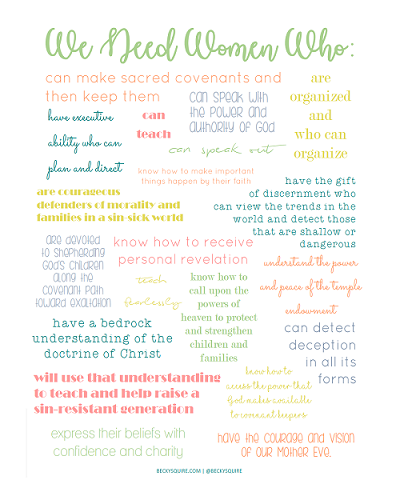
This is one of my favorite quotes. Every day, I ask the Lord to empower me, and especially, to give me utterance: when speaking in front of my students, my children, my friends, my husband, on social media, and when writing blog posts. When we seek the Spirit and the Savior’s influence, our words become His words. And that’s powerful.
#hegives #hegivesmestrength #hegivesmeutterance, #power #womenoffaith #neverunderestimatethepowerofspiritualwomen
Got a hard or soft heart?
Mother Teresa
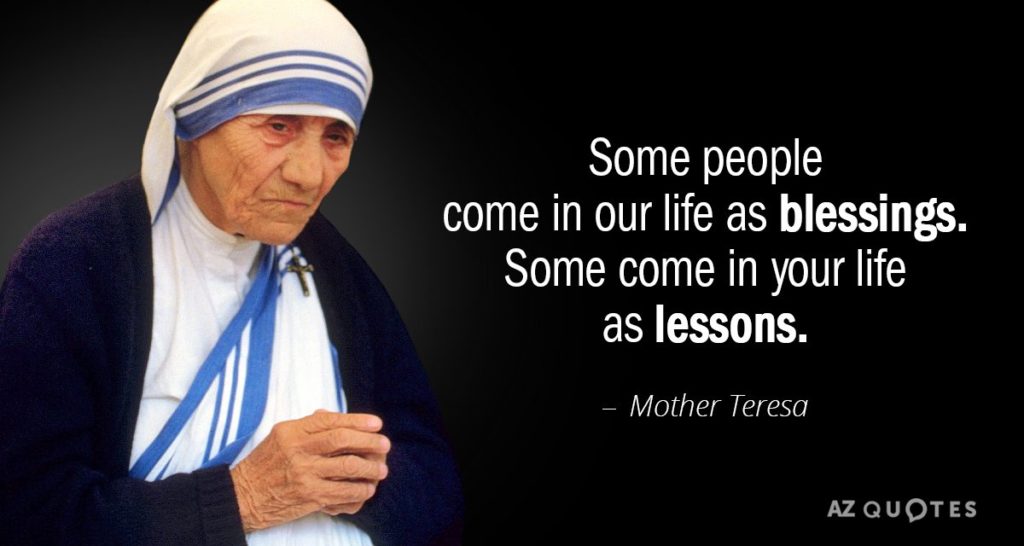
So true! And the sooner we see challenging and difficult people as sources for our spiritual and emotional growth, the less likely they will leave permanent scars on our hearts.
Christ has been the one who salves my wounds. Because of Him, my scars fade away. Regardless of the yearly Christmas and Easter seasons, we can celebrate—every single day—the ultimate person, Jesus Christ, who came to this earth and graced our lives as the greatest of all our blessings. It is HE who heals our hearts!
#softeninghearts #mindfullearning #blessing
Got armor?
Joan of Arc
I constantly pray for divine help to give me the courage of my convictions. We never know the depth of our courage unless or until it’s tested. I’m thankful for historical accounts featuring extraordinarily brave women who exemplified unimaginable resolve and tenacity.
Here’s to our individual and collective “brave new world!”
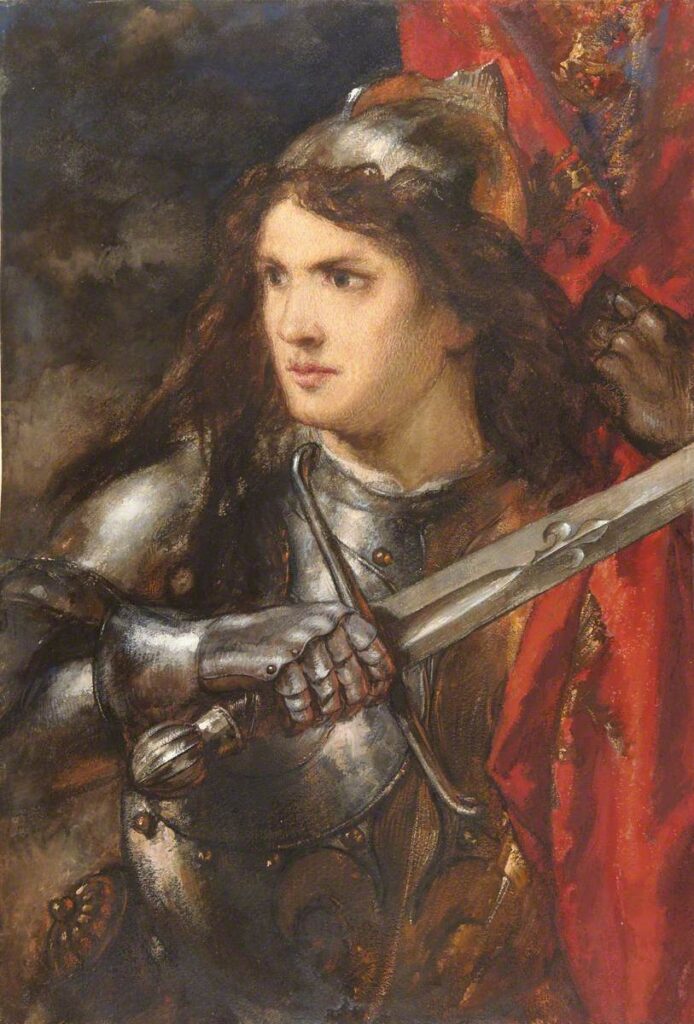
I echo Elder Jeffrey R. Holland’s observations about the courageous Joan of Arc. Below are excerpts from his talk, “A Brand New Year,” prepared for the 2008 New Year’s Eve celebration. Below are some excerpts:
“TRUE TO THE FAITH: I would like you to go back nearly 600 years to the New Year of 1412. That week in the small village of Domrémy, France, a baby girl was born who, a little later, at roughly the age some of you are, changed the political and religious landscape of her world. Through military developments and a variety of personal religious experiences, Joan of Arc, sometimes called the Maid of Orléans, was made a captain in the French army at the tender age of 16. In a rather remarkable series of battles and victories, she brought acclaim to herself and her cause, inspiring not only the men under her command but also the entire French nation. Later she was captured, tried, and put to death—burned at the stake—her life complete at 19 years of age.
As the fires were being ignited around the stake to which she was tied, Joan was given a last chance to save her life and regain her liberty if she would deny her religious—and thus some of her personally motivated political—beliefs. She refused to deny anything she believed or anything she had said about her faith, and thus chose fire above freedom, and principle above politics. Maxwell Anderson, who wrote a moving drama about this young woman and her courage, has her say in his play as the flames begin to consume her: ‘The world can use these words. … Every man gives his life for what he believes; every woman gives her life for what she believes. Sometimes people believe in little or nothing, [and yet] they give up their lives to that little or nothing. One life is all we have, and we live it as we believe in living it, and then it’s gone. But to surrender what you are, and live without belief—that’s more terrible than dying—more terrible than dying young‘ (Joan of Lorraine, Act 2, Interlude 3).
My young brothers and sisters, that is my message to you—a message from me, from the leaders of the Church, and from a teenage young woman of 600 years ago. ‘One life is all we have’ and our happiness will come in living it the right way for the right reasons—reasons that are eternal, reasons that matter in this life and in the next. Now, we don’t want you to die! And we surely don’t want you to die young, but truly there are some things worse than dying. In Joan’s words that would be to ‘live without belief,’ to surrender what you are and live contrary to what you know—or should know—to be true.
Two years ago the Mutual theme was to be ‘steadfast and immovable, always abounding in good works’ (Mosiah 5:15). Last year’s theme was to ‘be … an example of the believers’ (1 Timothy 4:12). And this year’s theme is to ‘be strong and of a good courage’ (Joshua 1:9). Those themes say scripturally and much more powerfully what that little French girl tried to convey so long ago:
Stand up and be strong. (In some cases that means to grow up and be strong.)
Be faithful.
Be courageous.
Be worthy.
Be clean.
————————-
In previous writings, I’ve used various paintings of Joan of Arc to underscore my points. In fact, I recently bought a print of my favorite painting of her: Painter Gaston Bussiere’s beautiful rendition of Joan receiving divine ministrations. I’m in the process of matting and framing the print (see below) to hang in my home.
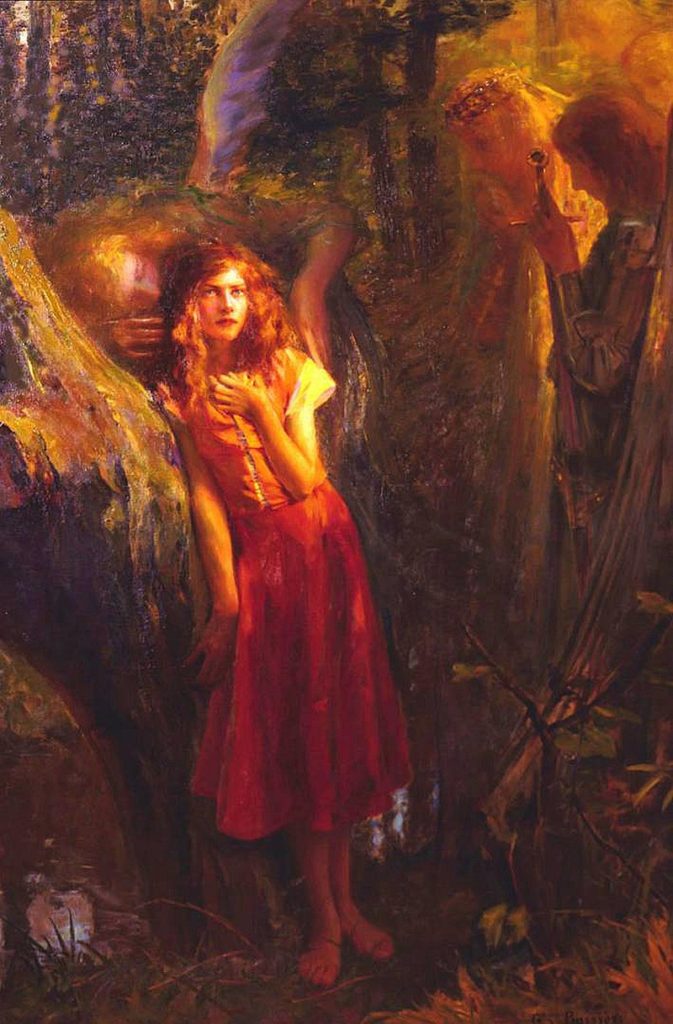
Holy Temples

For Catholic quinceañeras, Oakland’s Mormon temple is place to be
www.mercurynews.comThe history of how the site became a popular location for quinceañera photo shoots is murky, but one thing is clear: It’s not just quinceañeras who stop by for a quick pic.
________________________
Over the years, I have watched many young women and their entourages arrive in limos to the Oakland Temple grounds. Shadowed by a professional photographer, these girls have their photos taken for their quinceaneras—and using this temple as a backdrop.
At first, I was taken aback by all the flashy opulence and large crowds. Ironically, Latter-day Saint brides often have to wait their turn for their own bridal photo ops due to the groups of Catholic girls.
As I watched one particular photo session for a quinceanera, I got a very distinct impression that these activities were tangible and symbolic evidence of the Oakland Temple’s significance: It is truly a beacon in multiple ways and dimensions. It beckons. It calls. The statue of the trumpet blowing Angel Moroni (perched on the highest spire) exemplifies the clarion call to all who desire joy and peace.
The article gives further insight:
“It’s not just quinceañeras, said Tawn Gorbutt, a security officer at the temple. He patrols the temple’s grounds and said he sees people of all faiths and inclinations enjoying the space, from Ethiopian Coptic weddings, an orthodox Christian faith, to Tongan celebrants, first communions to birthday parties, graduates in caps and gowns to teens getting ready for prom.”
I’m very happy and honored to be a part of this joyful commonality. ❤️
Can’t enter in? Then use the parking lot.
Mt. Timpanogos Temple
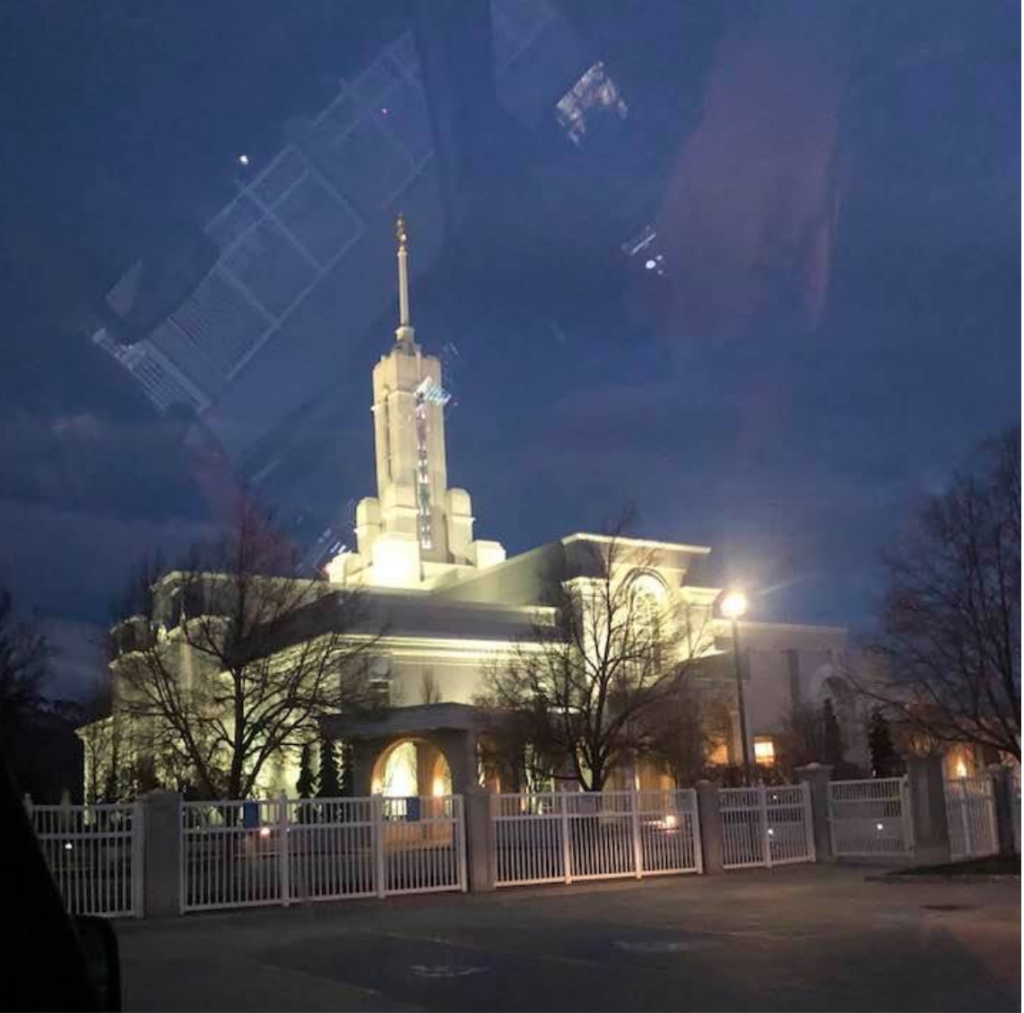
See the window reflection? I took this photo from the backseat of my daughter, Cristi’s, truck. Surely, the 2020 Covid-19 pandemic has shut down significant segments of our lives.
For my family, our temple attendance has been put on hold—and we’re feeling the loss. Unable to access the peaceful abundance within the temple walls, my daughters, daughter-in-law, and I decided the temple’s parking lot was the next best thing.
So, we—along with our prayerful hearts—piled into Cristi’s truck and drove to the temple grounds. Upon arriving, we noticed other people who had had the same idea. Like us, they sat in their cars, gazing at the temple, with scriptures in hand.
I hope they too, found the peace and reassurance we experienced that night. In a truck. In a parking lot. On the holy grounds of the temple.
Got temples?
Oakland, California Temple
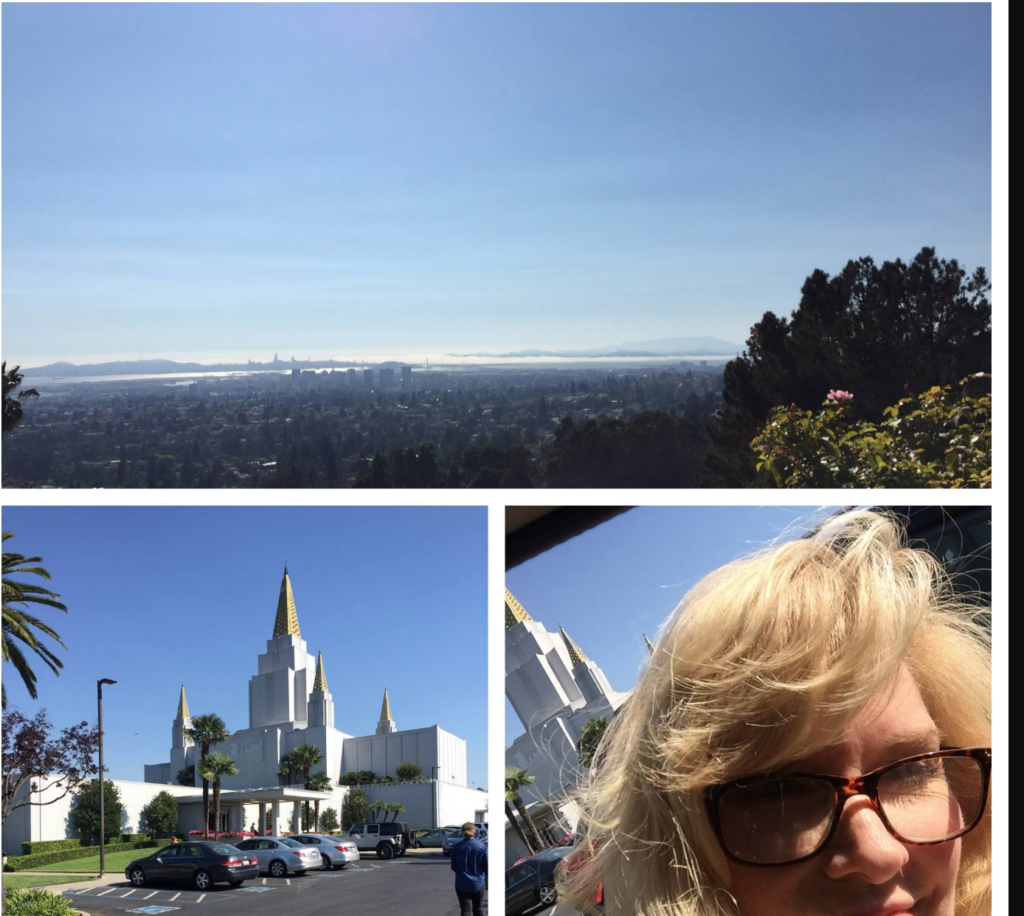
August 21, 2017
At my peaceful, happy place! See that fog rolling into San Francisco Bay? That means cooler weather is coming to the South Bay town of Morgan Hill where I live. Yay! @ #citybythebay #oaklandtemplelove

Just finished a temple session and admiring the Christmas decorations. #OaklandTemple
This particular temple has played a huge role in my life!

The Oakland Temple will always be “my” temple because:
1. My parents took me to its first dedication in 1963 when I was 5-years-old. I barely remember it.
2. As young girl, whenever I visited the Oakland temple grounds, I dreamed of one day marrying my “handsome prince” here.
3. As an adolescent and teenager, my Young Women leaders brought my friends and I to this temple to perform proxy baptisms.
4. As a teenager, I twice participated in the Oakland Temple Pageant which deeply strengthened and solidified my faith in Jesus Christ and the significance of temple ordinances..
5. As a young 21-year-old bride, I married my “handsome prince” here.
6. As a mother, I spent many hours in prayer within the Oakland temple’s walls. I always found answers and peace.
7. As teenagers, my children did proxy baptisms in this temple and participated in the Temple Pageant.
8. Rick and I took our firstborn son, Steve, to this temple as he prepared for his mission.
9. As an empty-nester couple, Rick and I served as ordinance workers for two years in this temple.
10. My daughters and I want to attend its re-dedication this month symbolizing a “full circle,” but Rick and I are in the process of moving, thus unable to attend.
11. Utah’s Timpanogos Temple has also become “my” temple when all of my adult kids married and moved to Utah.
Even better, unlike the 1 hour and 20 minute drive to get to the Oakland temple, Rick and I now live just minutes away from the Timpanogos, Saratoga Springs, Draper, Lindon, Orem, Provo, and Taylorsville temples! In any case, throughout my life, I’ve been so blessed to have these holy edifices nearby. ❤️
From Oakland’s “Temple Hill” to San Francisco Bay
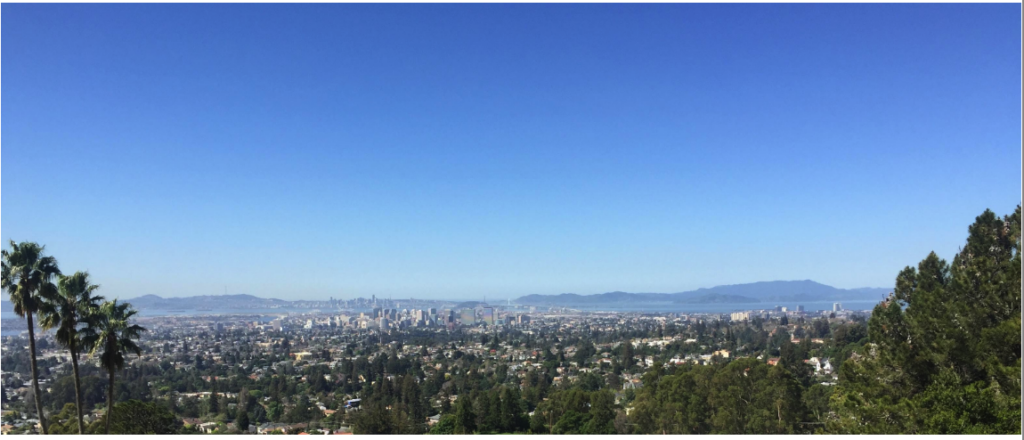
Awesome day at the Oakland temple. In the foreground is downtown Oakland. Across the bay is San Francisco. The Golden Gate Bridge is barely visible. Growing up and living in the Bay Area has its challenges but has also been a great blessing throughout my life.
Mar 16, 2016, 8:26 PM
Awwww. Don’t you just love happy endings . . . especially in the temple?!

A company accidentally put the Mormon temple on ‘Beauty and the Beast’ phone cases, and the …
www.sltrib.comKatie Hoyos didn’t know what was missing from her “Beauty and the Beast” collection until she saw it: a phone case featuring Belle and the Beast striding toward the LDS temple in Salt Lake City.
Updated Aug 15, 2018, 8:05 PM
National & Global Issues
_____________________________________
As a recently retired college instructor, I have witnessed and been compelled to abide by the ever increasing crusader mindset and approach regarding social justice issues among university administrators, professors, and students. This ideology and its methods have become so deeply embedded within most academic disciplines that it is now part of academic mission statements and within primary course objectives throughout academia. Consequently, the suppression of free speech and thought are the casualties of a “righteous” mindset and and its methods.
Former college student and campus social justice “activist, Trent Eady, wrote about his experience of ideological possession in a remarkable personal essay from 2014. What began as a passionate desire to advocate a change “for the greater good” evolved into a consuming orthodoxy that became “the darkest chapter in [his] life.” This kind of activism begins, writes Eady, with “good intentions and noble causes, but metastasizes into a nightmare. In general, the activists involved are the nicest, most conscientious people you could hope to know. But at some point, they took a wrong turn, and their devotion to social justice led them down a dark path.”
Eady’s world became divided into what he calls “the righteous and the wrong-teous.” There were those chosen and special—and then everyone else. In-group status could be maintained only by strict adherence to the special truths: “When I was part of groups like this, everyone was on exactly the same page about a suspiciously large range of issues. Internal disagreement was rare. The insular community served as an incubator of extreme, irrational views.”
Eady gives his own cogent definition of a crusader mentality: “an extreme self-righteousness based on the conviction that they are doing the secular equivalent of God’s work.” He continues with a warning:
The danger of the crusader mentality is that it turns the world in a battle between good and evil. Actions that would otherwise seem extreme and crazy become natural and expected. I didn’t think twice about doing a lot of things I would never do today.
Trent found that when he laid down the yoke of ideology, “a world that seemed grey and hopeless filled with color . . . Losing my political ideology was extremely liberating. I became a happier person. I also believe that I became a better person.”
Got class?

“The job you do is not in vain. I will never forget what I learned this semester. The work you do is amazing. Please don’t stop doing what you’re doing, because sometimes a class isn’t just a class; sometimes it’s a life changer.”
Yesterday, was the last day of class, thus one of my students wrote this in an email. We are all teachers and students in one way or another. Life’s lessons can be difficult and painful. Our Savior helps us through the pain.
#christisthemasterteacher #Heismytutor #tryingtobeaquickstudy
Got tolerance? How much?
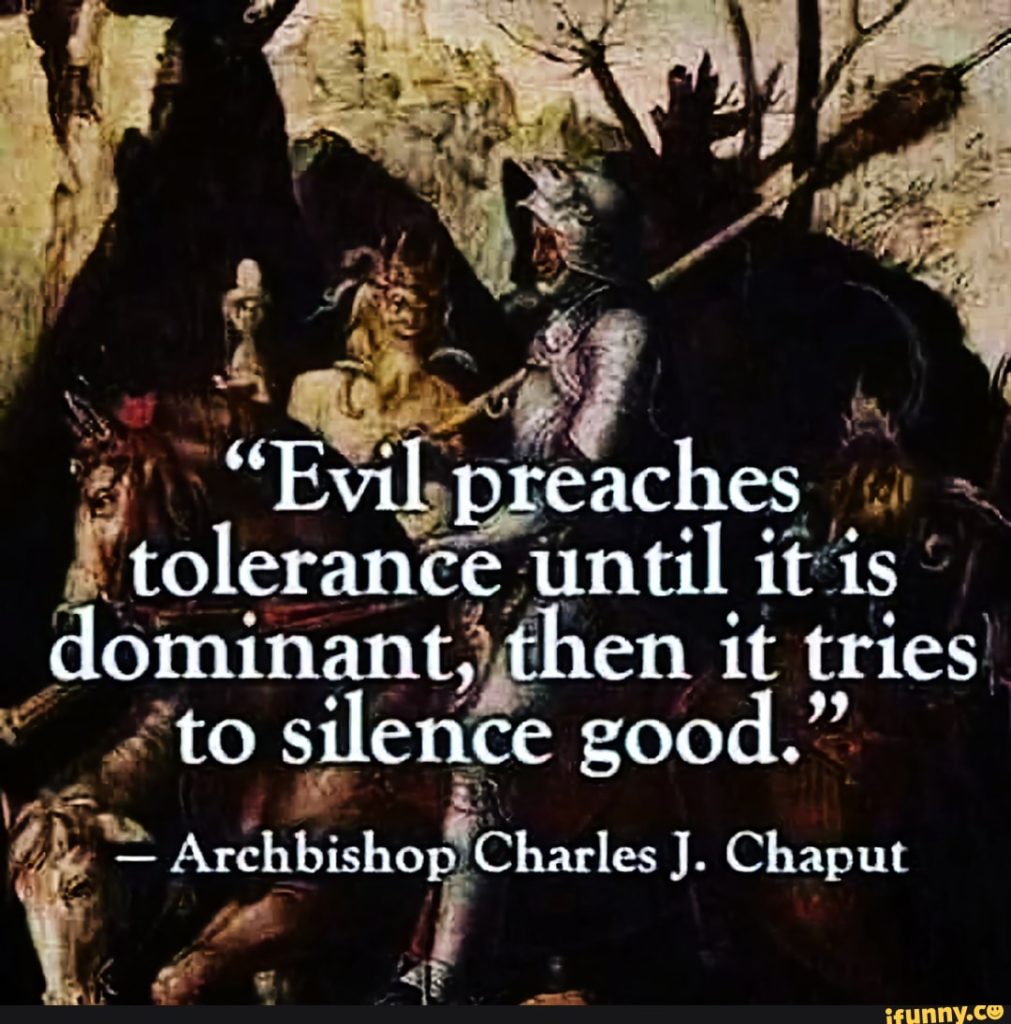
Throughout the 20th century, leaders of oppressive governments and/or various groups justified their evil for the sake of the supposed greater good (think communism coupled with its forced, unjust methods that caused millions to starve to death, the political imprisonment of dissidents confined to work in camps where they froze to death, the Nazi genocide, theocratical governments who abuse women, etc.). Today, as individuals and as groups, Western civilization has allowed and now, I believe, is endanger of collapsing by falling into the same traps. Too often we justify our bad behavior or fool ourselves and others by claiming we’re acting for the greater good than for what it really is: self-interest, self-aggrandizement, and power. Our fractured society, with its increasing focus on tribalism and collectivist group think over the worth of the individual, becomes more vulnerable to similar narcissistic dangers—especially when coupled with accusations and assertions between groups for power and political gain.
Psychologist Dr. Scott Peck says this mindset easily leads to evil:
The behavior of groups [like individuals] is strikingly immature. One of the causes of group immaturity is the problem of specialization (or feeling special) because of its potential for evil; it passes the moral buck onto another group.
Group members often feel pressure to conform to group norms because any truth tellers (who are the group’s moral conscience), are ostracized or destroyed. Dr. Peck also warns of too much group pride:
Group failure [and individual failure] wounds our pride, and it is the wounded animal who is vicious. In the healthy organism failure will be a stimulus to self-examination and criticism. But since the evil individual or group cannot tolerate self-criticism, it is in time of failure that he or she [or the group] will inevitably lash out one way or another. Group narcissism also leads to enemy creation or hatred of the “out group.’
Indeed, whether as individuals or as a group, when “we flee self-examination and guilt by blaming and attempting to destroy whatever or whomever highlights our deficiencies,” we are embracing and even promoting some level or dimension of evil—all while exhorting everyone else to either follow, tolerate, or promote our own (or our group’s) evil or evil tendencies.
#collectivistmindsetcanbedangerous #mindofchrist #aligningwithchrist #conformtochrist
Feeling polarized?
The polarized state of America is alarming. What can ordinary citizens do?
As a former college instructor who taught critical thinking and argumentation, I challenged (and required in my classroom) students to understand viewpoints other than their own, to put aside their own assumptions that they are “right” and those who disagree with them are “wrong,” and to engage in civil discourse during class debates. Every student was surprised as to the difficulty and maturity required to meet this challenge.

“People don’t just disagree with each other. They can’t imagine how a decent human being could disagree with their own view of race or the minimum wage or immigration or Trump. Being a member of the virtuous tribe means not only carrying the correct card in your wallet to reassure yourself. You have to also believe that the people carrying any other card are irrational, or worse, evil.
This means an end to not just civilized conversation, but often to any kind of conversation at all. This intolerance and inability to imagine the virtue of the other side is the road to tyranny and chaos. It dehumanizes a good chunk of humanity and that in turn justifies the worst atrocities human beings are capable of. We all understand in some part of our being how dangerous self-righteousness can be. But once people feel sufficiently self-righteous about their dislike for their opponents, violence comes easily” (July, 2018 Issue).
Going to college?
Higher Education’s Increasing Moralistic Approach Is Eclipsing Objective Truths

New faculty-led organization at Harvard will defend academic freedom – The Boston Globe
www.bostonglobe.comThe new Council on Academic Freedom at Harvard is devoted to free inquiry, intellectual diversity, and civil discourse. Leaders are diverse in politics, demographics, disciplines, and opinions, but …
Wisdom & Age
Got a mentor?
So many things I wish I could tell my younger self.

This powerful quote from scientist, political commentator, and author Ayesha Siddiqi has inspired many. Whether we apply this concept to helping others and/or helping our emotional and spiritual selves, we help to strengthen and uplift. I like getting older. Wisdom comes with age.
Other benefits: increased confidence, increased ability to love unconditionally, enjoyment in the fruits of our labors, and surrounding ourselves with loving family and friends. The lyrics from an old Rod Stewart song are strangely appropriate for the above meme:
I wish that I knew what I know now
When I was younger
I wish that I knew what I know now
When I was stronger.
I know I’m getting old when my adult children echo these same sentiments! It’s all part of the human experience. And . . yet . . we do another form of work as we age. We learn to still be compassionate with ourselves for not knowing better when we were younger. #WisdomForThePain
Got Wisdom?
Feeling Appreciative?

So true! One reason why humility is so important in our learning curve. #bethouhumble #wisdomversusknowledge #humilityteaches
Got anger? Got resentment?
The act of forgiveness is a process. Sometimes a very long one. And that’s okay.
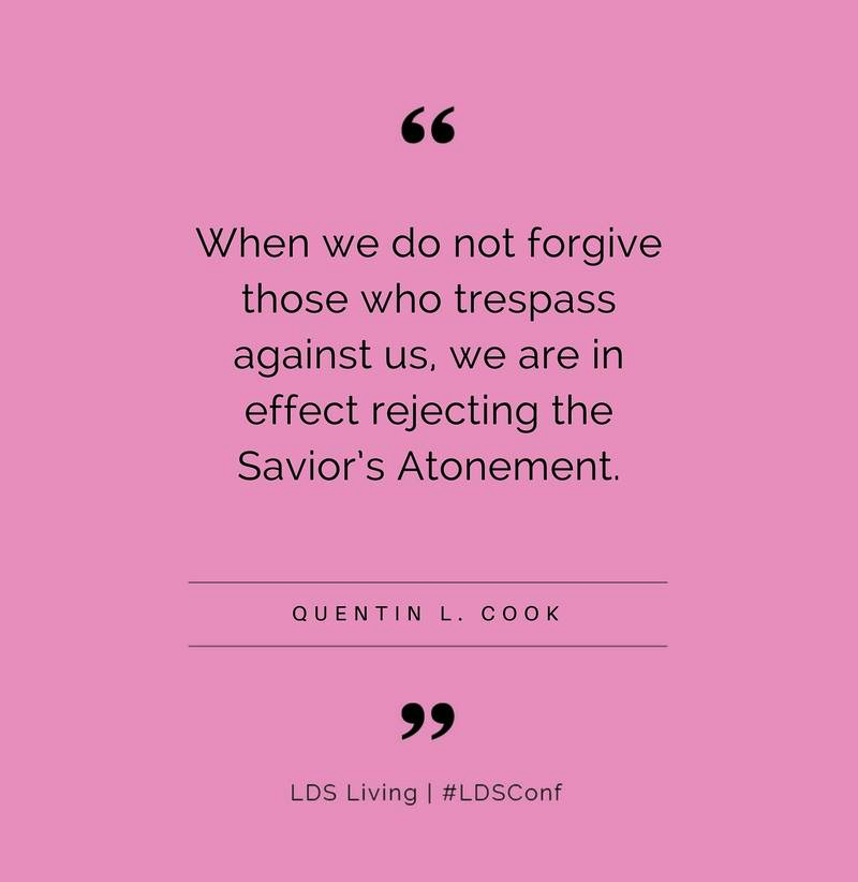
Not all relationships have happy endings. Many of our encounters with others will be negative. Still, we need not stay mired in sadness or anger. If our peace and happiness depend on receiving apologies from those who have wronged us, we will never find peace or happiness. With Christ’s help, we can learn how to forgive unconditionally.
#unconditionalforgiveness #choosepeace #choosetoforgive #generalconference
In denial?
Suffering is full of paradoxes. Here’s one:
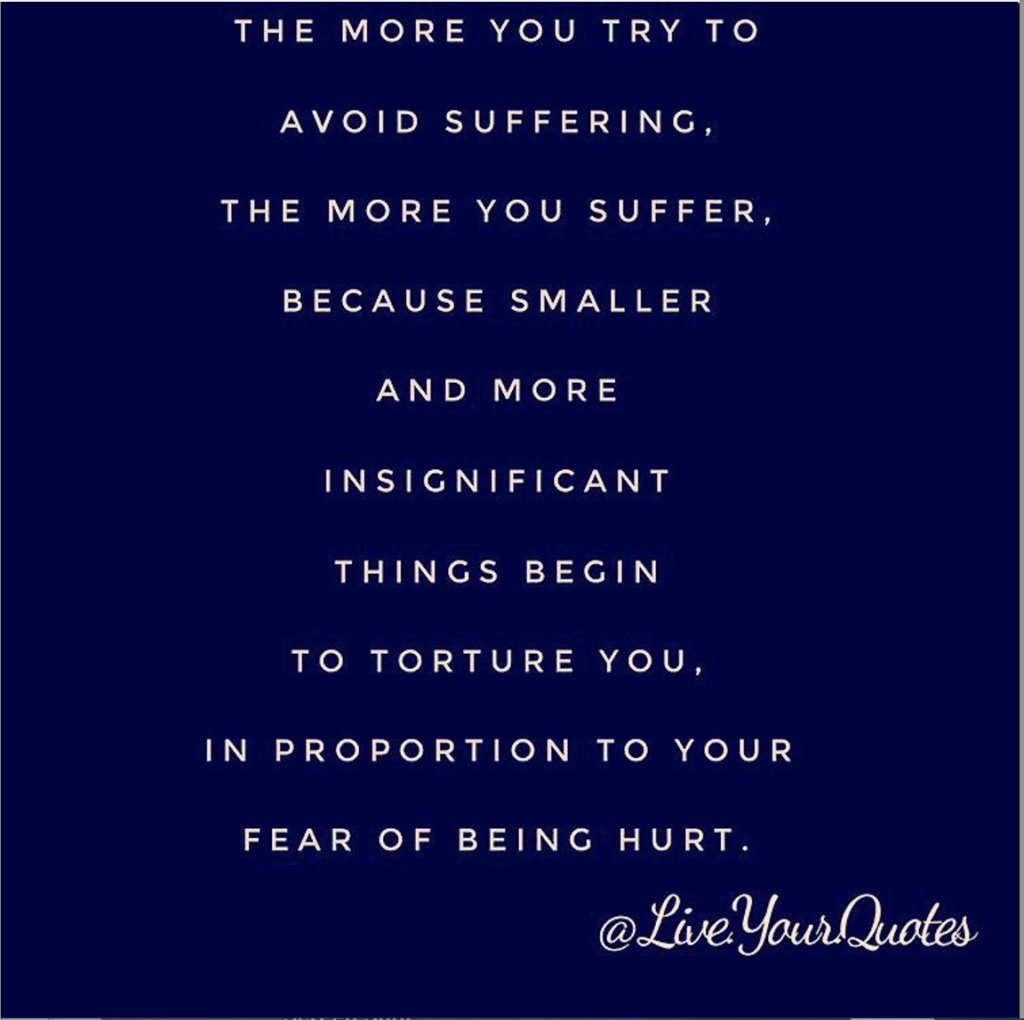
Our denial might bring temporary relief, but it never solves the problem; it magnifies it.
Got truth?
Sometimes, we lie to ourselves to help ease our emotional pain. But lies are never sustainable—for ourselves or for others.

Very profound. Especially the lies we tell ourselves. Yes, the truth often hurts. Sometimes it’s hard to tell the truth. Sometimes it’s hard to hear the truth. Sometimes we think our truth is THE truth. Here’s the good part: Christ has promised that the truth shall set us free. And the temple endowment promises us that we can learn to more fully discern between truth and error.
So . . . are we willing to hear truth? Are we willing to speak truth?
Christ has also promised to give us the courage to do both.
Need a light?
Viktor E. Frankl
“In some way, suffering ceases to be suffering at the moment it finds a meaning, such as the meaning of a sacrifice.”
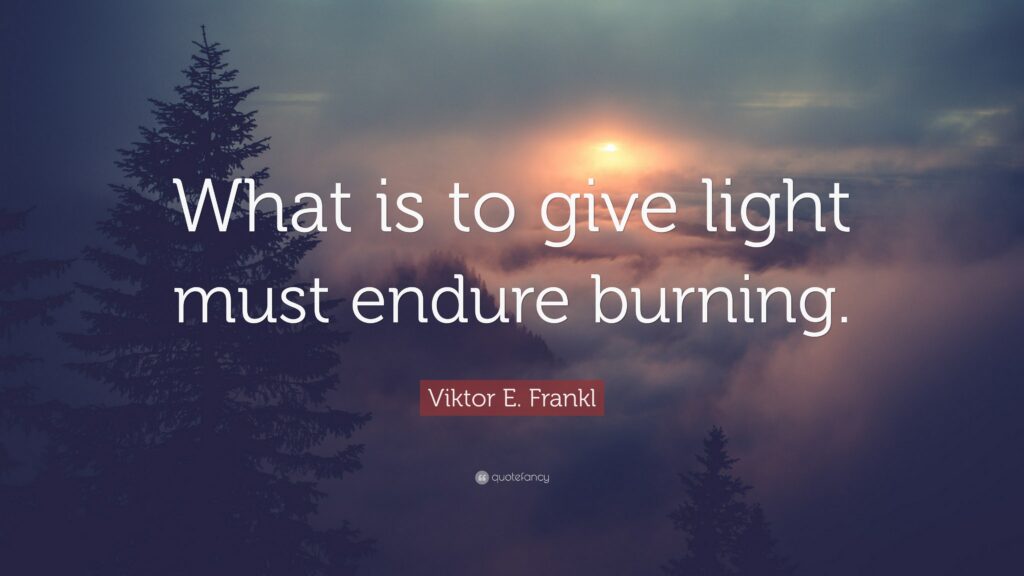
Frankl’s book, Man’s Search for Meaning, is a profound read. He is one of my heroes. As a psychiatrist in Vienna, he spent three years in a Jewish concentration camp. #feeltheburn
Got insecurities?

(I wrote this post in April, 2017 while living in California.)
I sense a growing discord among Latter-day Saint Church members regarding the fallibility and moral frailties of past and present Church leaders. I don’t have the answers or presume to counsel our Prophet, Apostles, and other General Authorities. However, my husband and I attended stake conference today and were uplifted by a talk given by the stake patriarch. He recounted his experience as a young bishop serving in San Francisco:
A woman called me on the phone and said that our then Prophet David O. McKay couldn’t be a prophet because she knew him personally. She began telling me all of President McKay’s faults until I couldn’t take anymore and hung up on her. That really shook me up; Satan worked on me. It was the week of General Conference. I went but I was still upset. I was praying as I took my seat in the balcony overlooking the pulpit.
As President McKay stood up to speak, he looked up—right up at me and our eyes made contact. I began to cry like a baby. My tears were of joy born from the Spirit. When Peter denied Christ three times, he cried bitter tears of anguish. It wasn’t until the Pentecost that Peter received more of a fullness of the Spirit.
There’s a difference between having a testimony based on knowledge and a testimony born of the Spirit. Reach out and stretch your spirituality to receive revelation upon revelation and knowledge upon knowledge to know the mysteries of God—until all of the mysteries are unfolded and you learn the peaceable things of the kingdom. And when thou art converted, strengthen thy brethren.
I felt the power of the patriarch’s words. Are you crying tears of anger and anguish or tears of joy and peace . . . or both? Do you feel resentment toward the Church because of historical disparities or leadership? Sometimes, having faith in humans and organizations is hard. So, I take my concerns directly to the source: God. He will answer. Our testimonies cannot thrive on a constant diet of anger, negativity, sadness, resentment, or hopelessness. Don’t hand your power or testimony over to anyone else but Him.
#doubtyourdoubts #steadfastandimmovable #pressforwardfaith
Got a muzzle?
Is someone barking at you? Are you one of the barkers? Maybe it’s time to muzzle it.

Making a difference often means putting yourself out there. Sometimes our influence attracts various forms of low hanging fruit: Some might resent us while others might attempt to dominate us. Still others might work to pollute our influence or try to steal our joy as we enjoy the fruits of our labors.
We cannot and should not respond to every critic who comes our way. To do so generates negative energy within ourselves and with our critics. Through the Spirit we can discern when to act and when to stay still. It also takes tremendous discipline to refrain from barking back! (That’s one reason I got off social media for good; I didn’t want to be one of “the barkers.” :))
#letthembark #barkbark #noteveryoneisyourfriend #critics #criticscomewiththeterritory #theresalwaysaprice
No matches? Let the Spirit light the fire!
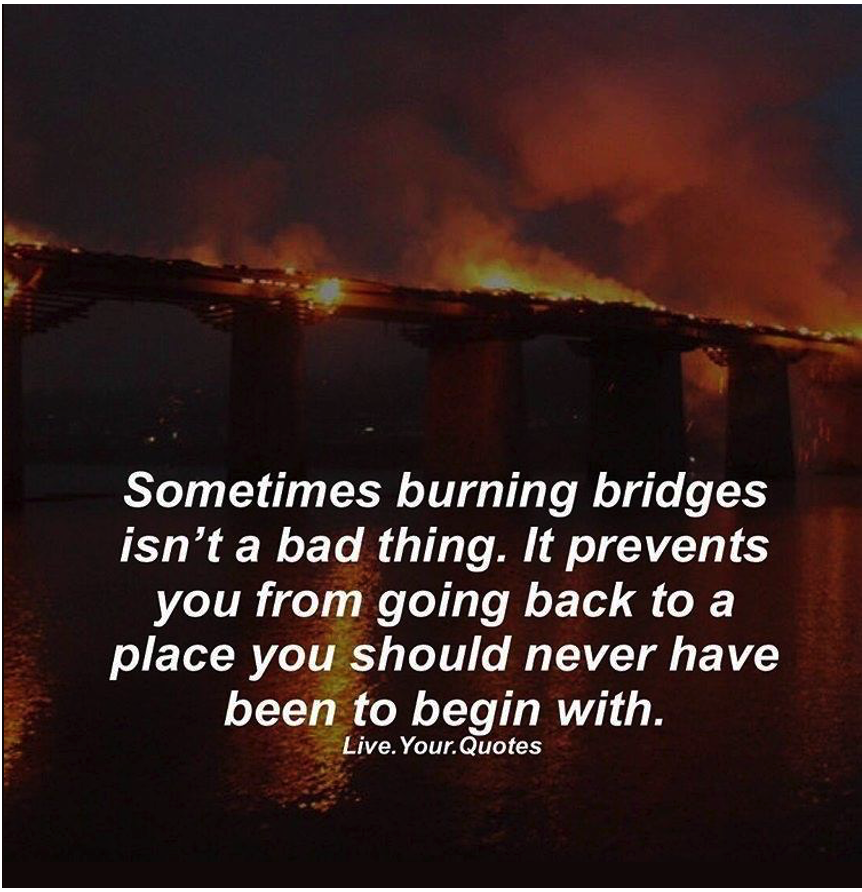
Burning some of our bridges can be an act born of wisdom and self-preservation. If we must burn them, let the Spirit light the fire!
#lightthefire #burning #fire #burningbridges
Got boundaries?
Trying to please everyone? Trying to be nice? Trying to avoid conflict? Is it working? Nope.

May 5, 2016
4 Shares
A friend of mine posted this on her Facebook page today. I’ve posted about this subject before, but this compact list of principles is worth sharing. In looking over these basic impactful truths, they seem so simple. But they’re not.
So, why are these concepts so difficult to learn and incorporate into our lives? Because we (and those with whom we set boundaries) often mistake boundary setting for being unkind or mean. Growing up in emotionally unhealthy homes, we often mistake pain and manipulation with acts of love.
Setting and maintaining healthy boundaries takes courage and practice. The process is painful but also liberating. Painful because we’re often dealing with family members and other people we love (or may not love). Liberating because we unchain ourselves from dysfunctional and negative dynamics.
So, in setting boundaries, expect pushback. No one is going to automatically respond by saying, “Thank you for setting this boundary with me. You’re so right about my negative behavior.” Instead, expect anger, sadness, grief, denials, guilt, and many other painful reactions. But pushing through and staying strong will eventually bring positive results.
Again, if we’ve grown up in homes where no healthy boundaries existed, learning to set boundaries will be all the more challenging. It requires untangling a lot of emotional knots:
- First, we learn what healthy boundaries look like.
- Next, we learn to incorporate boundaries with ourselves and with those around us.
- Expect some sort of fall-out or denial from the person to whom we’re setting the boundary. But push through the discomfort. There’s nothing wrong with expecting people to treat us with dignity and respect.
- In the aftermath, expect the possibility of losing the friendship/relationship.
- Be patient with ourselves as we learn how to foster healthy relationships.
Got a car?
Want to make your car a sacred space? It’s possible—especially without rambunctious kids in the backseat!
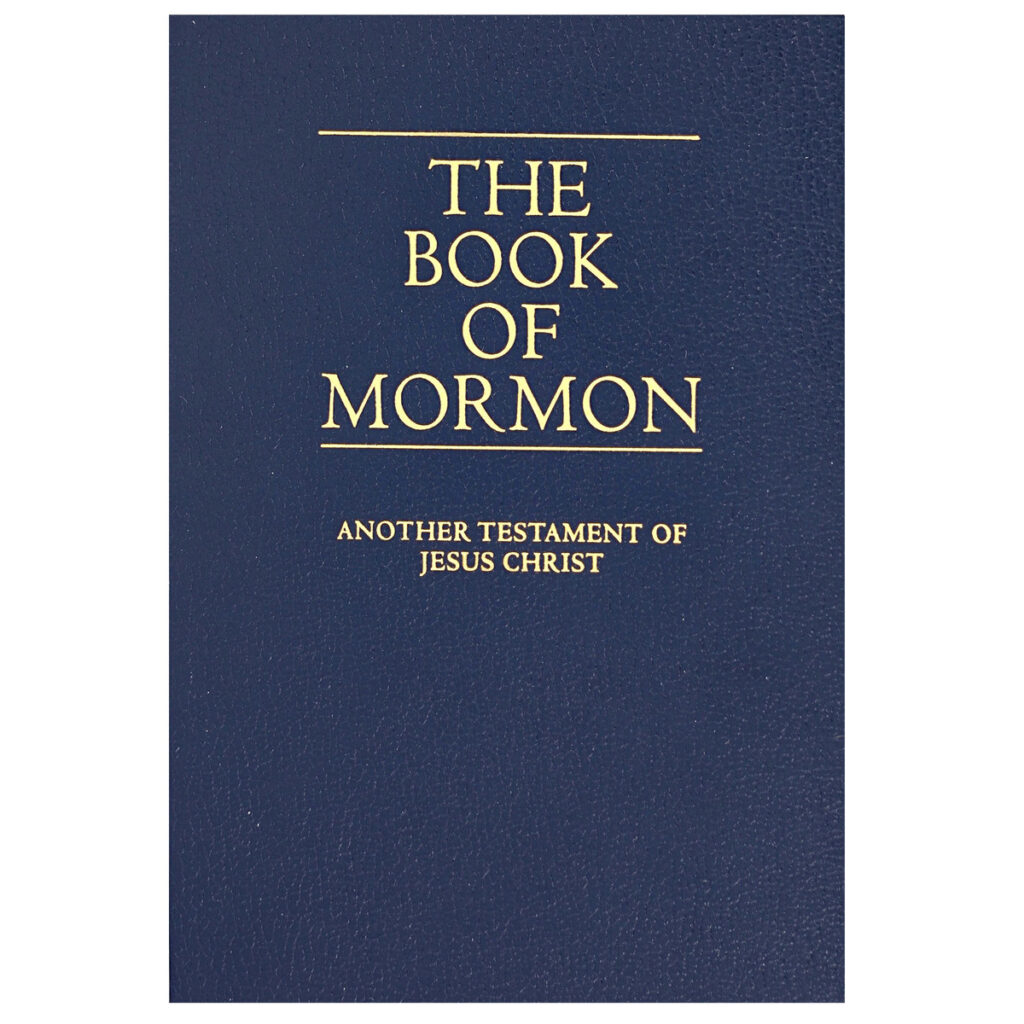
Three months ago, my stake president challenged us to read the Book of Mormon in time for our stake conference today. Using the app on my iPhone, I listened to the audio version every time I drove my car. I finished the book a couple of weeks ago. My car became a holy place during this time frame because it was filled with these sacred teachings. I love the scriptures!
Parenting, Grandparenting, & Marriage-ing
Got grandkids?
Book of Mormon Stories: Alma 24.

“And the people assembled together, they took their swords, and all the weapons which were used for the shedding of man’s blood, and they did bury them deep in the earth. And it came to pass that they threw down their weapons of war, and would not take them up again, for they were stung for the murders which they had committed. . . And they covenanted with God that they never would use weapons again for the shedding of blood . . . “
Our grandchildren chose to bury their various “weapons” in the form of teasing, not sharing, fighting with siblings, etc., by writing their promise (covenant) on pieces of paper, and then burying them in a hole.
The writings of Alma tell us more about this story. The bad guys came back and began slaughtering the people. But the Nephites had covenanted never to fight again. What to do? Their sons and daughters who hadn’t taken the oath got their own weapons and fought back—defeating the bad guys and driving them out of the land.
Sometimes, we have to pick up our weapons to fight in defending and protecting ourselves and our families. And when we’ve defeated our enemies, we need to know when to lay down our weapons of war for peace. Our ability to discern these moments comes through the guidance and direction from the Spirit. #strengthandpeace
Got annoying kids?
Wait for the grandchildren—they make it all worth it!

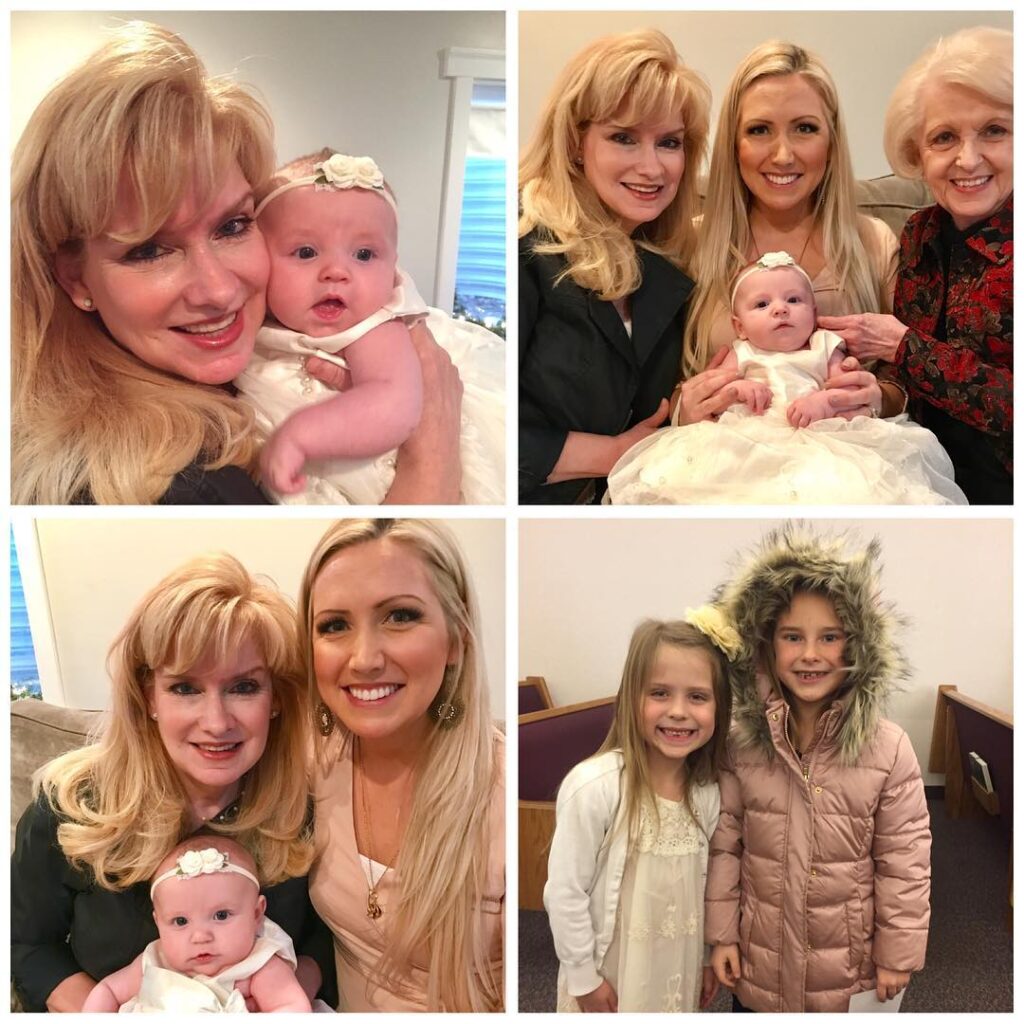
Baby Blessing Days and 4 generations.
Comparing notes?
This applies to grandmothers too! Haha.
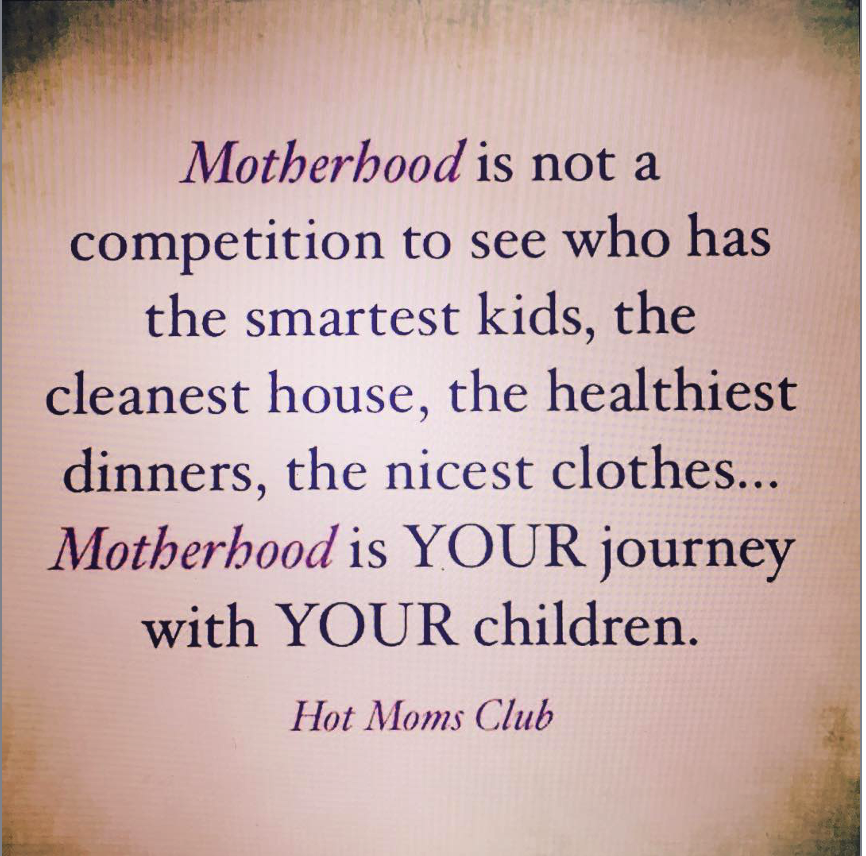
Sometimes, women can their own worst enemies. And our kids get hurt in the competitive crossfire. #mykidsarebetterthanyours. #notokay
Go live!
A first for my daughter and I: A live session in the Salt Lake Temple
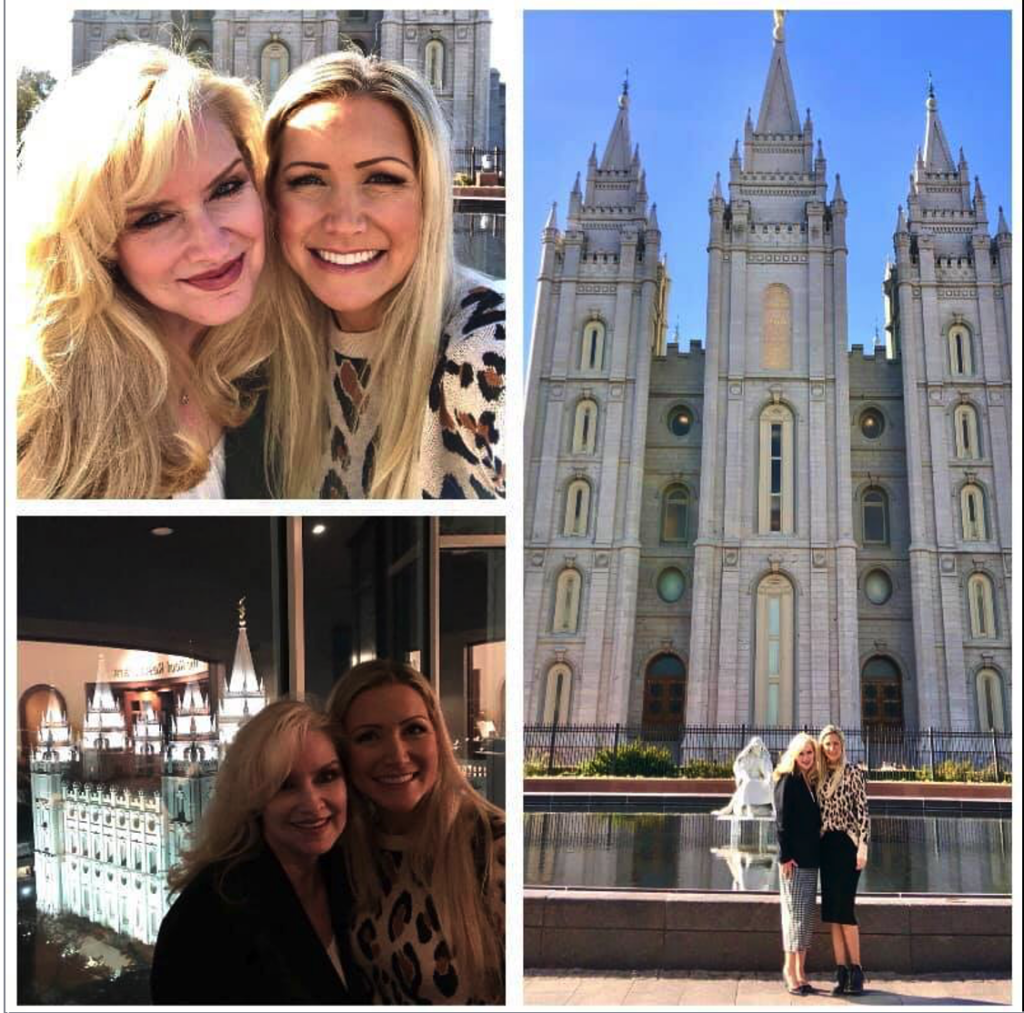
November 8, 2019 Salt Lake City
Today was the first time I have ever attended a temple session in this glorious, magnificent structure. And, I loved sharing this experience with my daughter.
As a former temple ordinance worker, I appreciated the efforts of those serving in live sessions. My paternal grandfather, Willard Mounteer, had served in this capacity thus making this experience especially poignant for me.
The detailed artistry was so beautifully inspiring. No wonder our Latter-day Saint pioneers spent 40 years building it. Their craftmanship and dedication to God stands as a testament that burns ever more brightly.
Got sons?
At Mt. Timpanogos Temple with my firstborn and last born.
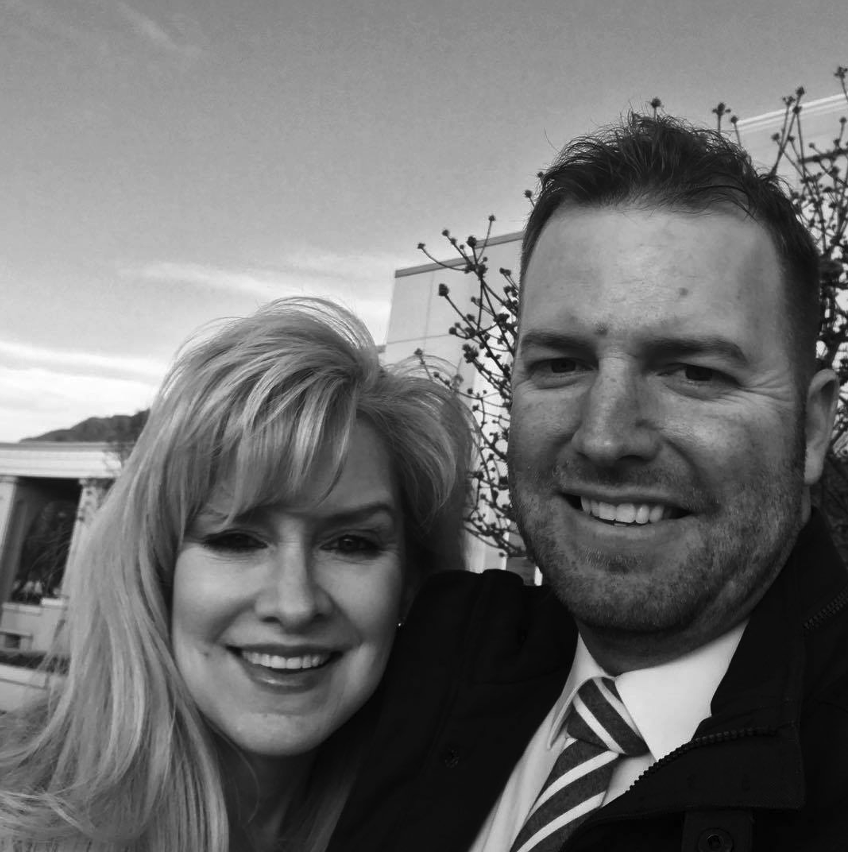
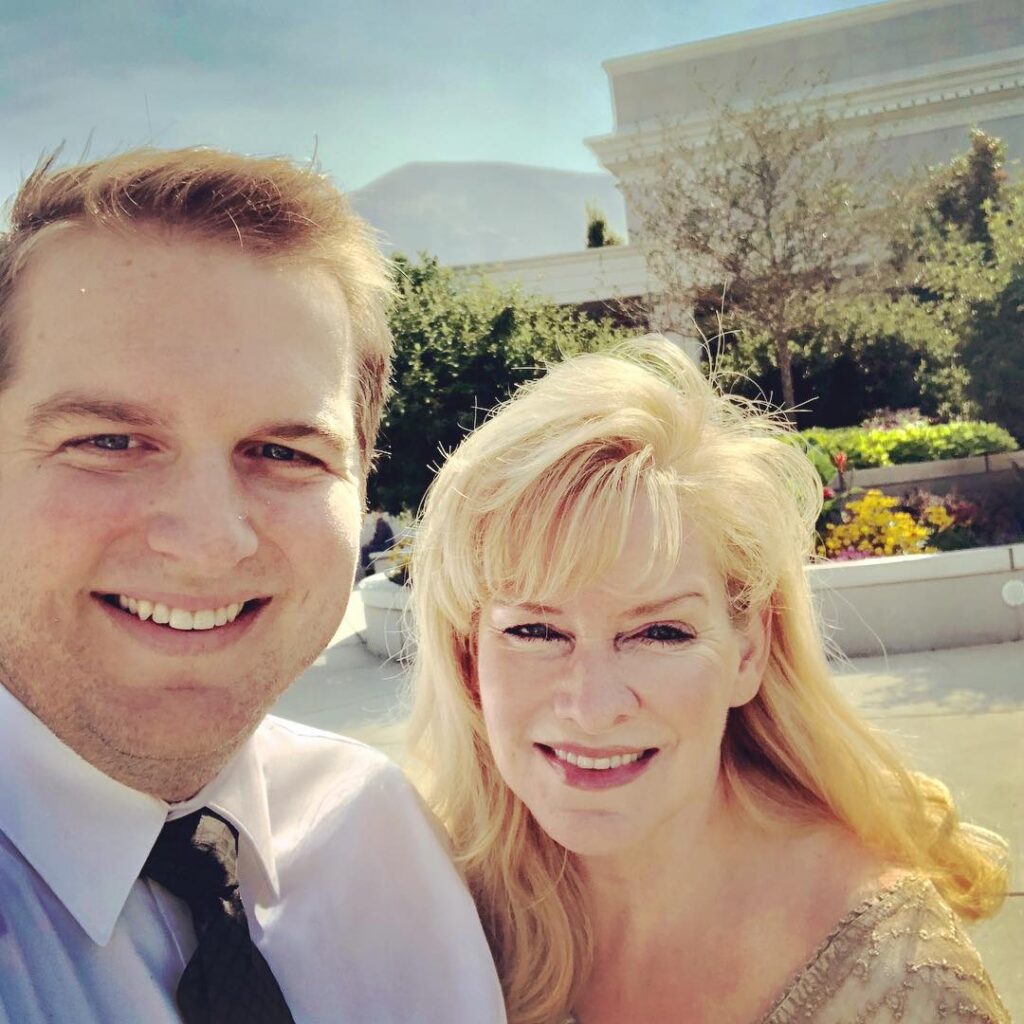
One of the highlights of my Christmas and New Year’s: Attending multiple sessions with my husband and kids at the Timpanogos Temple. I wasn’t able to get a photo with all of them, but I’m sharing these photos of my sons as we stand in front of this holy edifice.
#loveattendingthetemplewithmykids #Timpanogostemple #hardtogobacktocalifornia #mysacredplace
Got moms, grandmoms, daughters, sisters, aunts, nieces?
Women’s General Conference
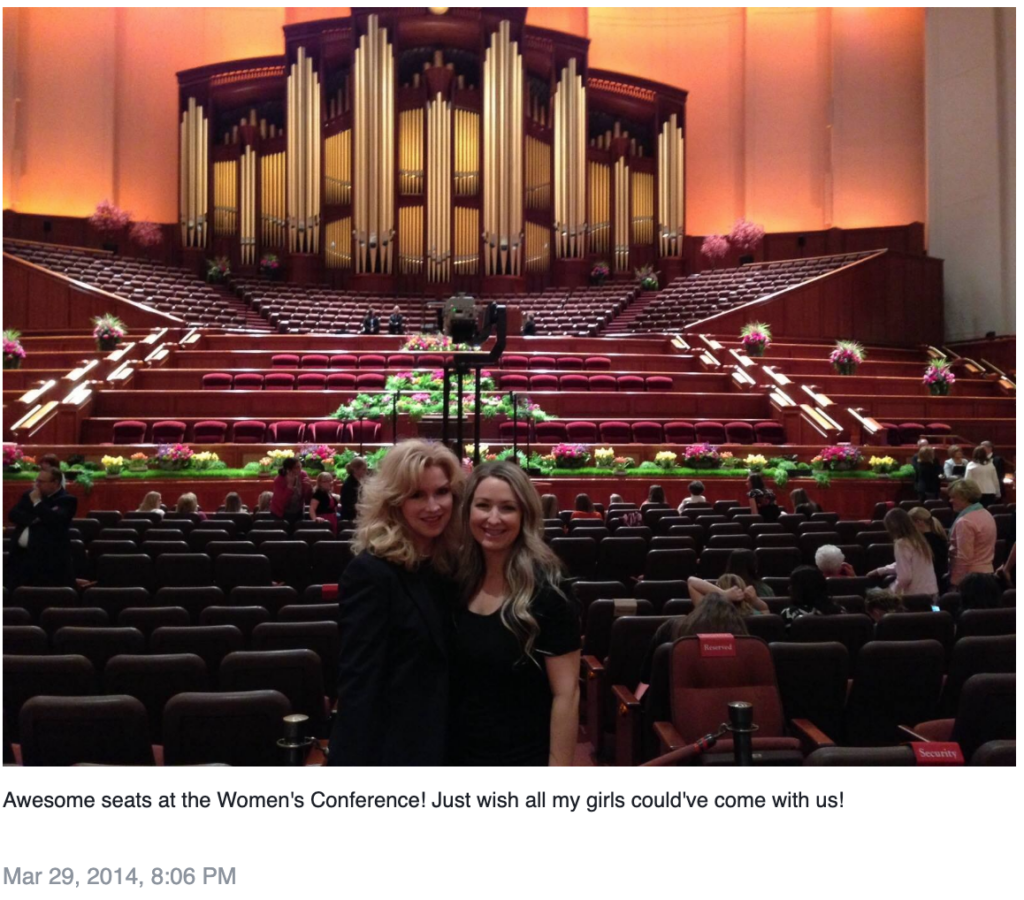
My daughter, Erica, and I before conference begins.
Got a missionary?
At Mt. Timpanogos Temple with our youngest right before his mission
2009

Got fish?
Let’s teach our kids how to spiritually fish!
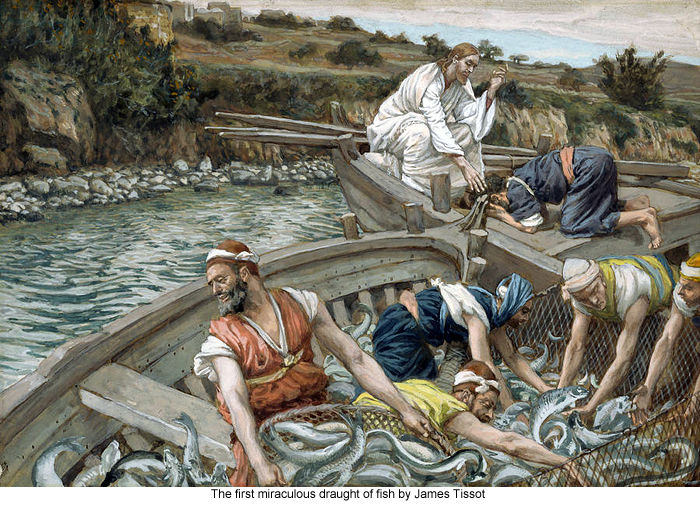
So true. When we teach our kids to “spiritually fish” for themselves, they are far less prone to the fiery darts of the the adversary.

How your children’s spirituality can help them overcome some of the most common forms of …
www.ksl.comOne of the nation’s premier experts on spirituality says it’s part of
Need a baptismal dress?
“I like my birthdays every one . . . but I can’t wait until I’m eight for then I’ll be baptized you see.”
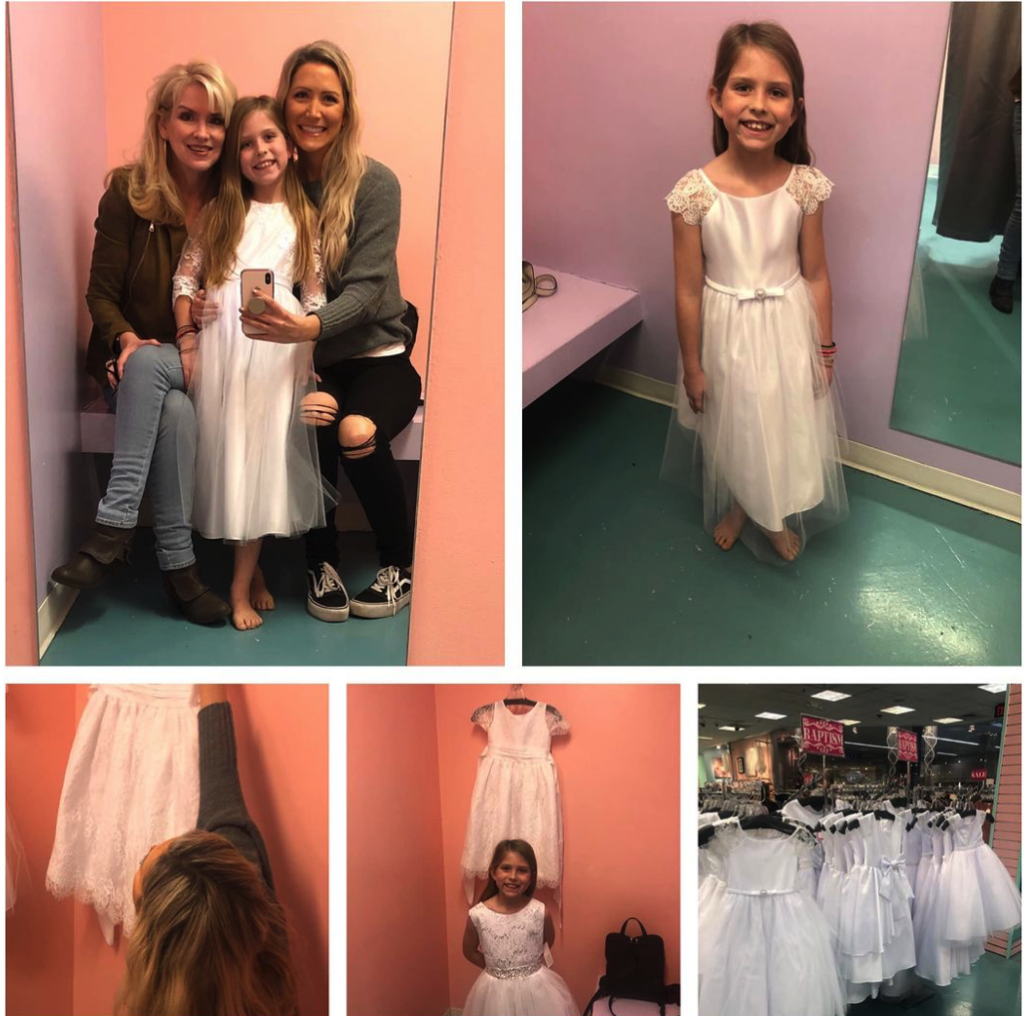
Posing for a three-generation photo op while shopping for a special white dress for Madison’s upcoming baptism and temple grounds photo shoot.
Though still spiritually somber, Latter-day Saint baptisms have become much more celebratory and joyful in the last decade. One of the many perks of life in Utah: Baptismal and Blessing outfits readily available at the local mall. I love days like this with my children and grandchildren—truly a “joy in your posterity” experience!
Got ancestors?
Memorial Day, 2020
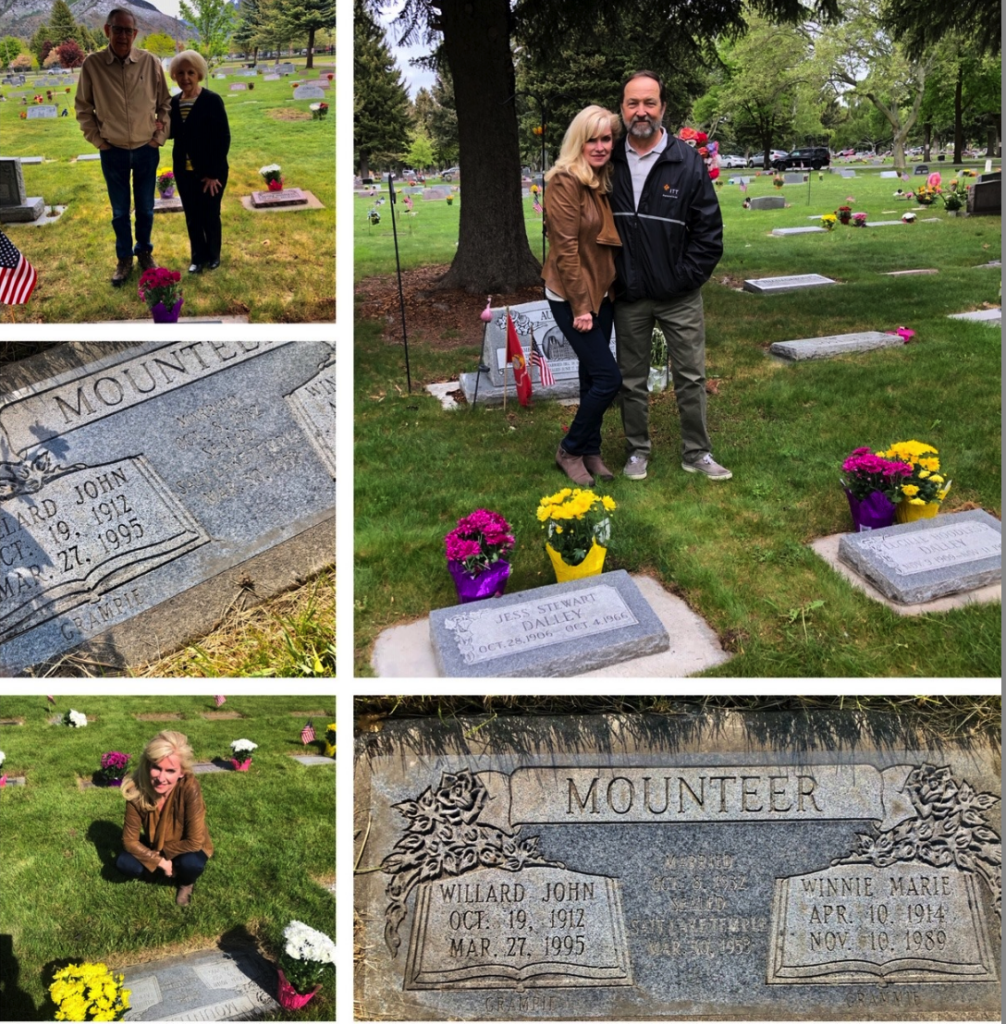
Rick and I, along with my parents, spent today in Logan and Sandy, Utah for Memorial Day remembrances. I’m so thankful for my family legacy and want to pay tribute to them in this post:
My parents who taught me the gospel, kept their temple covenants, and exemplified the value of a secular education.
My grandparents: I was especially blessed with gentle, kind, and loving paternal grandparents, Willard Mounter and Winnie Allred Mounter (“Grandpie and Grammie”). I loved the authoritative strength of Grampie’s prayers. Grammie referred to me as her “jewel” which made me feel especially valued. They bore powerful testimonies of the gospel and sustained and supported the prophets and apostles. I love that they had their names, “Grandpie and Grammie,” etched on their gravestone. I tried to get a close-up photo below. My grandchildren call me, “Grammy;” a great honor as I strive to live up to my Grammie’s legacy.
My great grandparents: Even though I have limited memories of them, their loving guidance nurtured my parents’ budding testimonies of Christ. They prepared the soil and sowed the seed, and as their posterity, we continue to reap a rich harvest. My LDS ancestral accounts mirror the stories of fellow pioneers within and without the Church. Indeed, storied struggles and triumphs are a commonality within the human family. And so it is with my ancestors, my parents, my siblings, myself, my own family, and with all of us. We live out our lives in a patchwork of paradox and
contradiction; a compilation of struggle and endurance, of sadness and joy, of achievement and failure, of humiliation and glory, of holiness and sin, and ultimately, of transcendence and peace.
Some of my Latter-day Saint ancestors were more diligent than others in keeping their temple covenants. Others disassociated themselves completely and permanently from the Church. In his book, A Proud Heritage, my father penned a tribute to his maternal grandparents, Asa and Uretta Allred which reads:
The lived by the old verities of love, honor, courage, virtue, integrity, and respect . . . and under-girding all of these was a deep and abiding religious faith. Many of the details of their histories deal with their religious experiences. Over again we see examples of the intervention of a loving Heavenly Father, as they turned in time of need. Grandpa . . . had a concern for his posterity.and this was a man to be loved and his life to be emulated. Grandma’s love of the gospel and her testimony of its truthfulness came from the rock solid experiences of her youth. Her grandmother Richardson had lived in Nauvoo and had been married by the Prophet Joseph Smith. She had worked in his household and had known the family firsthand. She had been driven out of Nauvoo when the mobs came. Grandma Richardson’s stories became as real to Grandma Allred as if she had lived them herself. This legacy she passed on to her children and grandchildren by telling and retelling, with tears in her eyes, the stories she had been told. Her life was filled with many faith-promoting stories of her own, which she has passed on to her posterity.
Our work is to pay it forward by passing this legacy onto our posterity.
#PayltForward #LivingTheLegacy #TiesThatBind
P.S. Rick and my sons/sons-in-law have been growing beards during the Covid-19 sheltering in place. Rick promised to shave it in a couple of days. He’s almost unrecognizable with an “old codger” beard! I told him I wanted my old Ricky back!
Got moms?
Mother’s Day
April 2, 1990, the day my son, Philip, was born.
(See the spot? It’s a dusty camera lens.)
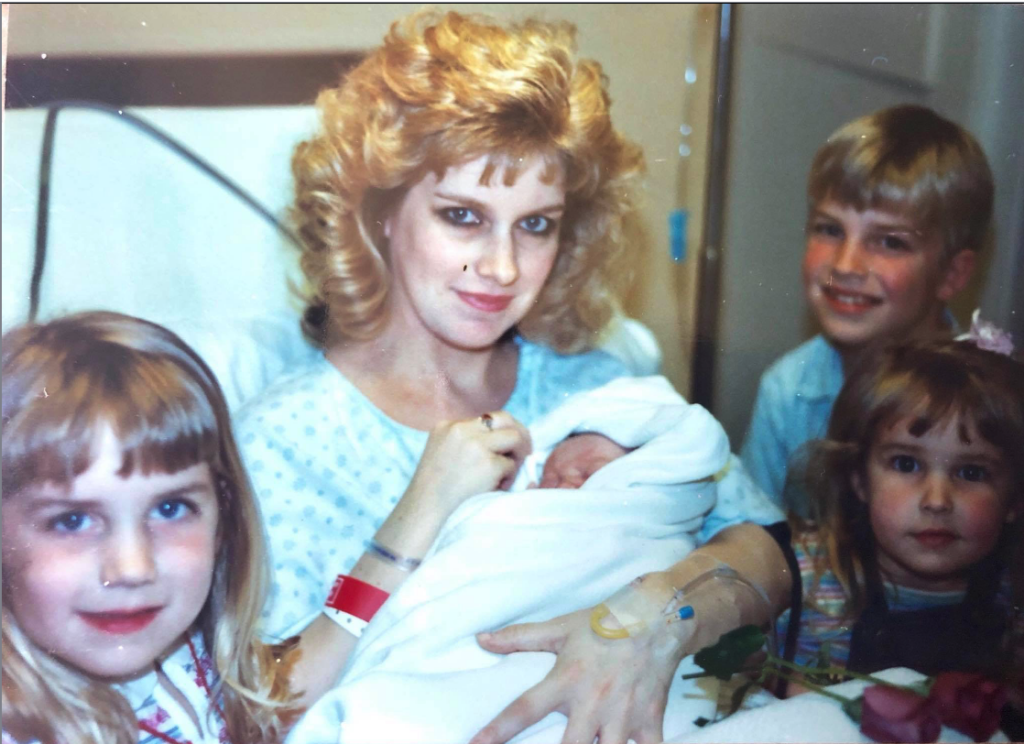
“There is no other role in life more essential and more eternal than that of motherhood.” — President Russell M. Nelson. I’m so thankful for these precious souls who have taught me so much! I’m grateful to be with them in this life and in the next! Happy Mother’s Day, everyone.
#sacredstewardship #prayersofamother #partnershipwithGod #heartmightmindstrength
Feeling guilt over your kids?
Nathan Mitchell, Actor, and Clinical Director of the ANASAZI Foundation
I loved Nathan Mitchell as an actor playing the roles of the Apostle Peter and Joseph Smith. Now, I love him even more.
Need a family coach?
Call on God.
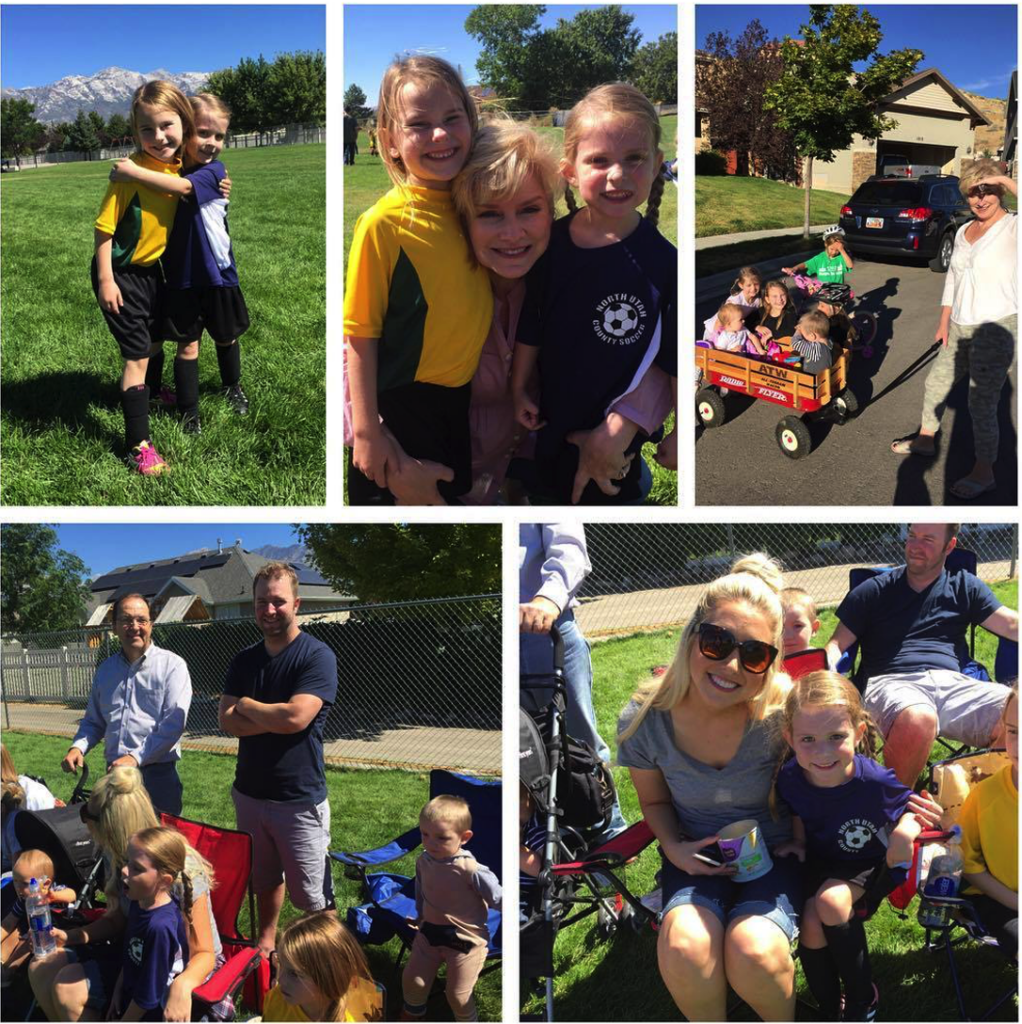
While attending our granddaughters’ soccer games today, it occurred to me that our family has gotten through tough times using cooperation and teamwork. We pull together by looking to God and our Savior Jesus Christ for strength, comfort, peace, and healing.
#Godisourcoach #righteousgoals #Christhelpsustowin #goodsports
Got babies?
I love being a grandmother!

Now that I’m a grandmother, a New Testament verse has come to resonate with me all the more:
But continue thou in the things which thou hast learned and hast been assured of, knowing of whom thou has learned them. And that from a child thou hast known the holy scriptures which are able to make thee wise . . . ” (2 Timothy 3:14-15).
Got cabin fever?
Covid-19 and my 62nd birthday
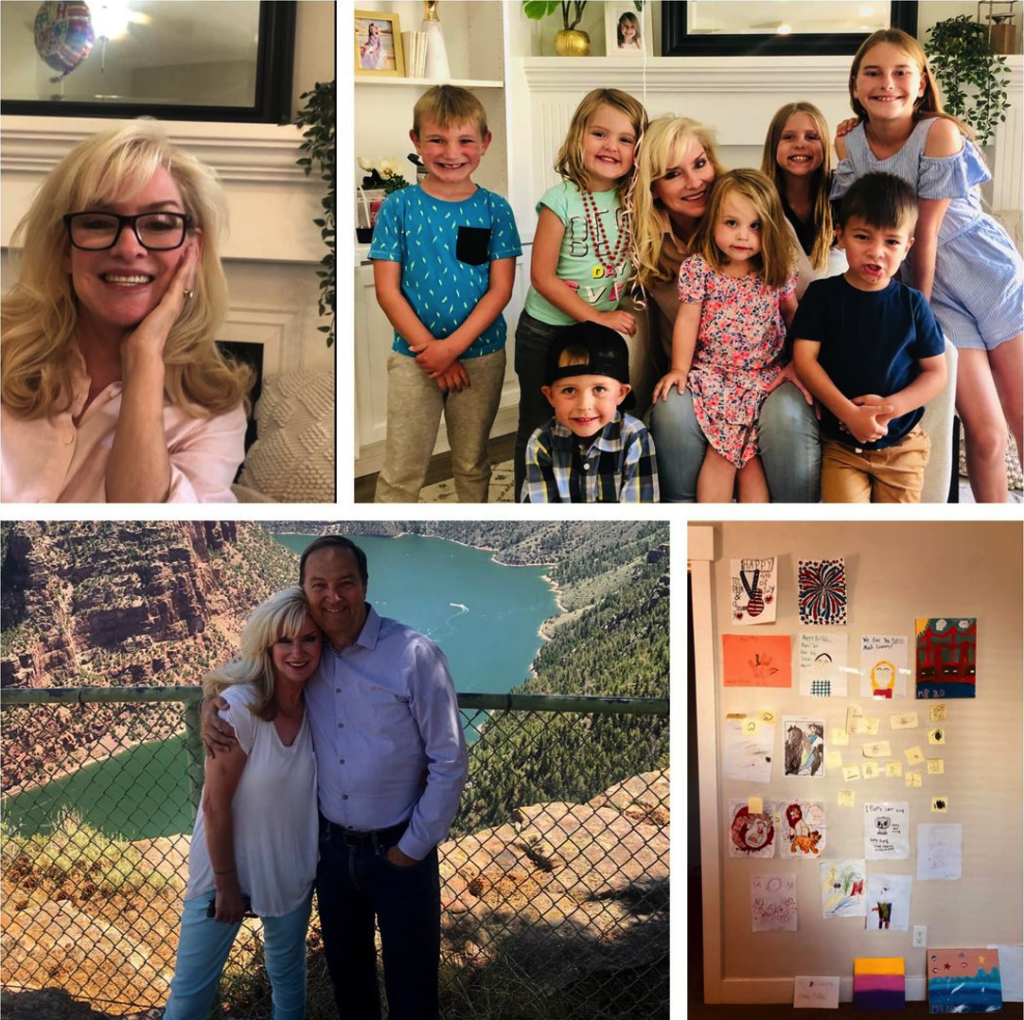
On my 62nd birthday today, I give many thanks to my Heavenly Father for my life, for my family, and most of all, for my Savior. My nearly 3-year-old granddaughter took a random photo of me (top left) effectively capturing my joy.
For over a year now, my husband and I have been living in a 600 square foot apartment while we oversee the construction of our house. On our bedroom wall, hangs a collage of our grandchildren’s drawings, paintings, and written notes. I plan on framing most of these items and hanging them on a special “Grandchildren Wall’ in our house. I love looking at these wonderful tokens and treasures of love.
I have lived long enough to have experienced and overcome trials and emotional pain through the healing power of Jesus Christ. He is my greatest joy and the greatest gift I could ever hope to have. Because of Christ, I have been able to—not just endure—but to flourish in my trials and challenges. Through Him, I conquer every sorrow, every hurt, every difficulty, every opposition, every issue, every obstruction, every sickness, every everything.
Recently, I reviewed Elder Jorge Alvarado’s October 2019 Conference talk entitled “After the Trial of Your Faith.” His words are truly prophetic—especially as we strive to live and teach the gospel under the constraints of the Covid-19 pandemic. His quote below stresses the need for a “home-centered Church.” He says:
Our example of righteous living can make a great difference. President Nelson has said: ‘As Latter-day Saints, we have become accustomed to thinking of ‘church’ as something that happens in our meetinghouses, supported by what happens at home. We need an adjustment to this pattern. It is time for a home-centered Church, supported by what takes place inside our branch, ward, and stake buildings.’
As difficult as the pandemic has been, I’ve heard many comments from various Latter-day Saints who feel that home-centered church meetings have helped them develop skills in presenting gospel lessons and have strengthened their family relationships as a result. In my own family, my husband and I love watching our children teach our grandchildren the gospel. And we love teaching the gospel directly to our grandchildren. I realize that not everyone is fortunate to live in close proximity to loved ones. And I realize that many church members feel isolated from their ward families. I also sorely miss attending the temple. Still, “home-centered Church” has surely taught all of us valuable lessons!
Elder Alvarado gives additional counsel relevant to “home-centered Church.” He says:
Ultimately, everything God invites and commands us to do is an expression of His love for us and His desire to give us blessings reserved for the faithful. We cannot assume that our children will learn to love the gospel on their own; it is our responsibility to teach them. As we help our children learn how to use their agency wisely, our example can inspire them to make their own righteous choices. Their faithful living will in turn help their children to know the truth of the gospel for themselves. Young people, as you seek guidance from your loving Heavenly Father, listening to the counsel of living prophets and watching the example of righteous parents, you too can become a strong link of faith in your family.
This pandemic has given all of us ample opportunities to teach our children, and for our children to participate in the learning, sharing, and teaching of gospel principles within the family.
Elder Alvardo also emphasizes how influential parental teaching can be:
The influence we have on our children is more powerful as they see us walking faithfully on the covenant path. The Book of Mormon prophet Jacob is an example of such righteousness. His son Enos wrote of the impact of his father’s teachings: ‘I, Enos, knowing my father that he was a just man–for he taught me in his language, and also in the nurture and admonition of the Lord–and blessed be the name of my God for it . . . And the words which I had often heard my father speak concerning eternal life, and the joy of the saints, sunk deep into my heart . . .
He continues:
The mothers of the stripling warriors lived the gospel, and their children were filled with conviction. Their leader reported: ‘They had been taught by their mothers, that if they did not doubt, God would deliver them. And they rehearsed unto me the words of their mothers, saying: ‘We do not doubt our mothers knew it.’ Enos and the stripling warriors were strengthened by the faith of their parents, which helped them meet their own trials of faith.’
One more valuable insight from Elder Alvarado concerns the trials of our faith:
No matter the obstacles we face in life, we can trust that Jesus Christ will prepare a way forward as we walk with faith. God has promised that all who live according to the covenants they have made with Him will, in His time, receive all His promised blessings. Elder Jeffry R. Holland taught, ‘Some blessings come soon, some come late, and some don’t come until heaven’ but for those who embrace the gospel of Jesus Christ, THEY COME.’ Moroni taught that ‘faith is things which are hoped for and not seen; wherefore, dispute not because ye see not, for ye receive no witness until after the trial of your faith.’
Now that I’m a grandmother, I can personally testify to the truthfulness and practicality of Elder Alvardo’s words. Creating a family is life’s hardest but most rewarding endeavor. It wasn’t meant to be easy, and we don’t easily see the fruits of our labors until our children are grown. Teaching our children and/or family members requires much seeding and planting—and the harvest is a prolonged process. But family ties are eternal and richly rewarding! The Lord doesn’t require perfection, but He does require effort.
Challenging and scary times are upon us like never before. Political and social upheavals are the new normal until our Savior returns. With the help of the Spirit, my family and I are temporally and spiritually preparing. We are striving to be Christ’s warriors. The battle lines become ever more clear each day. May we all become sharp, pointed, swift, and polished arrows in our Savior’s quiver.
#ForSuchATimeAsThis #SaturdayWarriors
Got spring fever?
Coming back to life post Covid-19
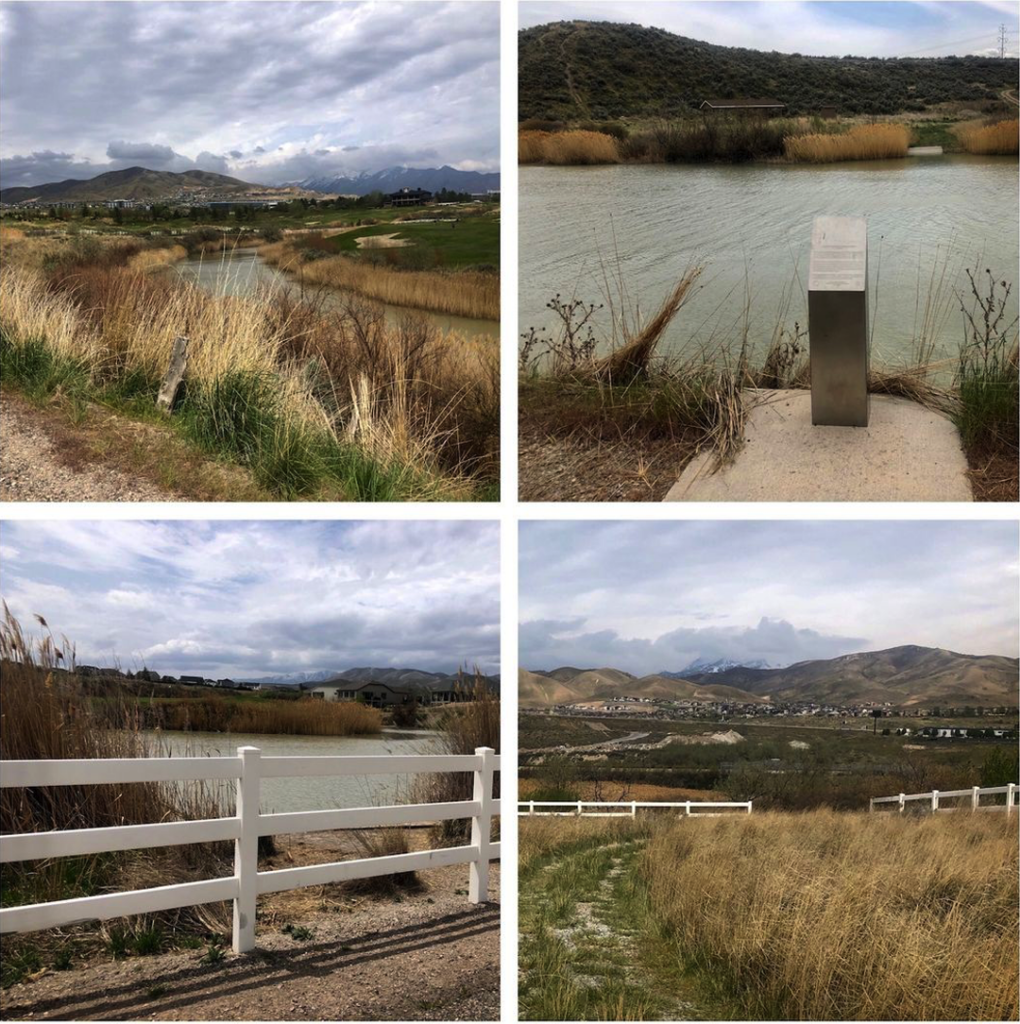
Paralleling the spring season, our community is gradually coming back to life after months of sheltering from Covid-19. The added bonus of warmer weather has finally allowed me the luxury of outdoor exercise until the gyms re-open. Watching my muscle, strength, and stamina wither away these past months (despite me and my daughters’ best efforts doing home workouts) has been a bit disheartening. As a younger woman, I was naturally thin and in good health. With aging, I’ve had to incorporate regular gym work-outs and weight lifting in order to retain muscle, strength, and maximum brain capacity. Like everything else, if we don’t use it, we lose it.
Exploring the Jordan River Trail has helped to revive my body and mind. I love the comforting rhythmic look and sound of flowing water. The meandering Jordan River is very beautiful in this area. I discovered the trail marker (pictured below) where pioneers ferried their wagons across the river. High runoff made fording this part of the river very dangerous. Hence, the Indian Ford Ferry was initiated and used by the early Latter-day Saint pioneers, the Pony Express, the Overland Stage Company, and many other travelers on their way to Oregon and California. The ferry operated 24 hours a day but was disbanded after the 1869 completion of the Transcontinental Railroad. Reading the trail marker’s etched words, I was again reminded of Utah’s LDS pioneer heritage; their magnificent sacrifice and miraculous ability to settle this land and make it bloom. Even more, these heritage markers are embedded throughout Utah in the form of city and street names, abundant temples and church buildings. In every day I’ve lived here, my mind and spirit are nudged by the sacrifice and testimony of the early Saints.
Their legacy set a nearly impossible standard of love, devotion, and grit for their posterity to follow. And for whatever reason, many of their children, grandchildren, and extended posterity have not followed and left the Church—leaving their children and/or posterity without a gospel tether. Surely, those ties and tethers are very tenuous; each generation is dependent upon the next to keep alive the gospel flame within families. In striving to teach our children and forging those gospel links, I’ve looked back at the years of hard work required by my husband and I to build a covenant keeping family. It’s never an easy work (for any family in any circumstance) because teaching and exemplifying gospel principles to children and grandchildren is a very long term investment. Conversely, it only takes one parent in one generation to break the chain. And one parent in one generation to re-tether to the gospel chain.
I sat on the ground next to the Jordan River trail marker and basked in the sunshine. While thinking about the significance of this particular spot of river and land, I took heart. Yes, our Covid-19 sheltering has been difficult and chaotic. But sheltering has given our family—along with the rest of the world—many gifts. (I surely realize the great suffering and pain caused by this pandemic. I don’t mean to minimize that in any way.) Because my family lives closely together in the same neighborhood (we are very fortunate, I know), sheltering together has aided in strengthening our own gospel tethers. We have felt much joy, love, and growth in having church services together at home. Watching my husband, sons, and sons-in-law bless and pass the Sacrament to family members has given this particular ordinance a new intimacy. Our Sunday lessons have produced fruitful and meaningful discussion. For home school, I’ve loved participating in “recess” with my grandchildren. One day, while helping my granddaughter with her school lessons, she said, “Grammy, you should be a teacher. There are lots of grandmas that teach at my school.” My heart sang as I described to her my career in teaching “big kids and grown-ups.” The innocent earnestness of children is so tender and sweet. They look to us to teach, to testify, to exemplify.
As children of God, when we earnestly seek the Savior, He teaches, He testifies, He exemplifies—if our hearts are open to the learning process. And this pandemic has been a time of great learning in the midst of great global suffering.
#LearningLessons #GospelAndFamilyTies
Got dads?
Father’s Day
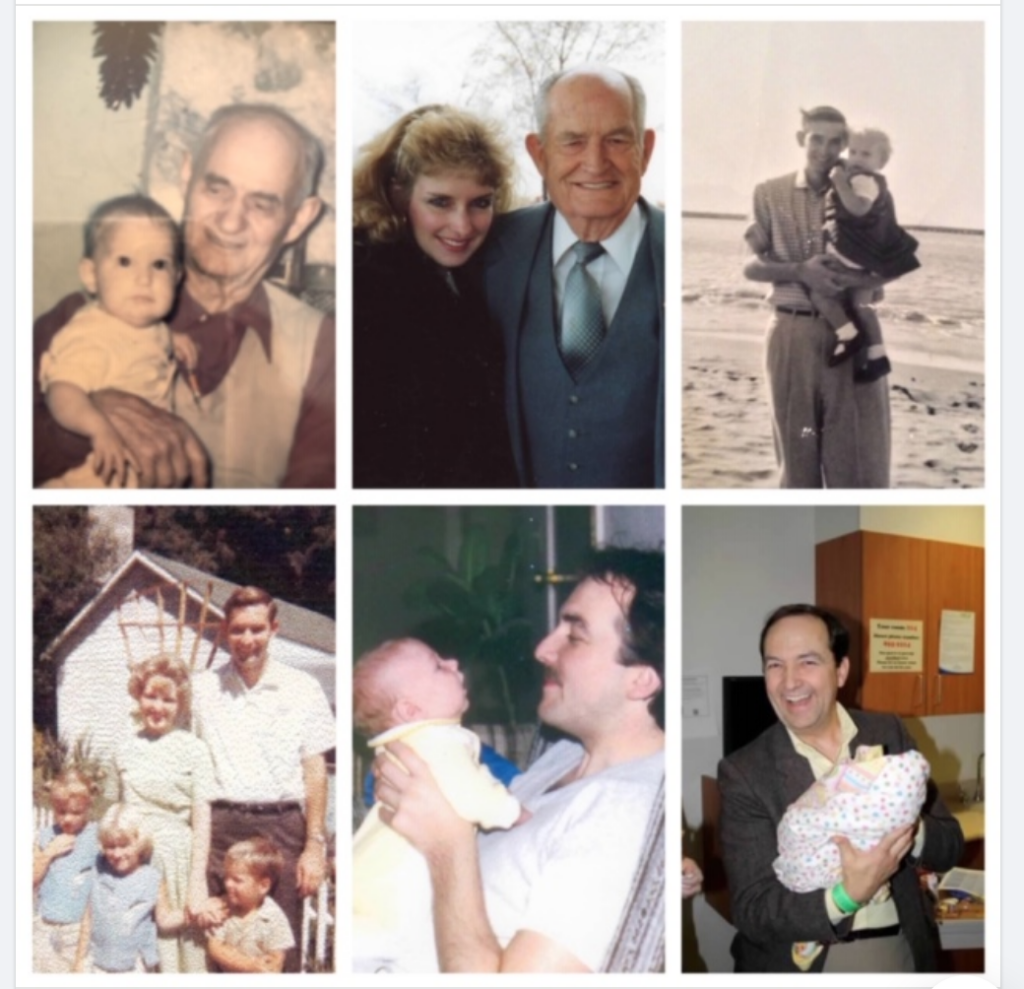
Presently, our society emphasizes the significance of women—almost to the exclusion of men. Righteous, loving, devoted men who serve as husbands, fathers, grandfathers, uncles, brothers, and leaders are of equal importance to healthy families and societies.
I’m so blessed to have been loved, lead, partnered, and influenced by these righteous men who upheld their covenants and became powerful and influential leaders to their posterity.
Pictured below:
1. My paternal great-grandfather, Asa Newton Allred
He was called by President Lorenzo Snow to serve a mission to the southern states. When B.H. Roberts “set him apart” by laying his hands upon Grandpa’s head, Elder Roberts stated, “You will be hated and despised. You will be threatened of being whipped and mobbed. But if you will honor the priesthood and obey the council over you, you will go in peace and return in safety. You will even be shot at. You have the gift of healing, even the dead will live through administration under your hands.” Grandpa died when I was 10 years old. I remember him as a man of great faith.
2. My paternal grandfather, Willard John Mounteer (Grandpie)
Grandpie was born and raised as one of 11 children in Fort Union, Utah. Due to grinding poverty and unemployment, his parents fell away into inactivity in the Church. Grandpie was not reactivated until he was middle-aged. His sons were getting married and making covenants in the temple, and Grandpie didn’t want to be “left behind.” Overcoming his desires for alcohol and tobacco, he became a force of righteousness as a grandparent. I absolutely adored him. He bore a powerful testimony, became a temple worker, and exemplified love and service.
3. My father, Gene Mounteer
My dad worked diligently to form a gospel-centered family, and to provide a priesthood lead home—one that he had not experienced as a child. In his lineage, Dad was the first to attend and graduate from college. He blazed an economic, educational, and priesthood lead trail so that his children would have these significant advantages that he and my mother had not had. His career as a college English and literature instructor helped all of us to become skilled in oral and written communication. Because of Dad, all five of us kids have careers in education and teaching. He and my mom served two missions and he was an influential church leader.
4. My husband, Rick Hawker
Rick is a special, self-made man with a fierce work ethic because of the many challenges he faced growing up on an Idaho farm. Like my father, he blazed his own trails: serving a mission in Argentina, attending college at BYU Provo and obtaining a Master’s from San Jose State, carving a career in California, devoting hours and hours to church leadership—all while being the best hands-on dad to our four kids. He dreamed of having a close-knit, spiritual, priesthood centered family active in church service. He has taught and exemplified to me a more pure love in serving others. He is the best grandpa (Papa) ever and takes his grandkids with him wherever he goes.
What and where would I be without these influential men? Most of all, I could not live without my Heavenly Father. He is the Creator of all good—including these wonderful earthly men who have blessed my life! He gave us His only begotten son; the Savior and Redeemer of the world. Because of God, we are greatly loved and can thrive with His influence—even if we lack the righteous influence of earthly fathers and husbands.
Got a fire hose?
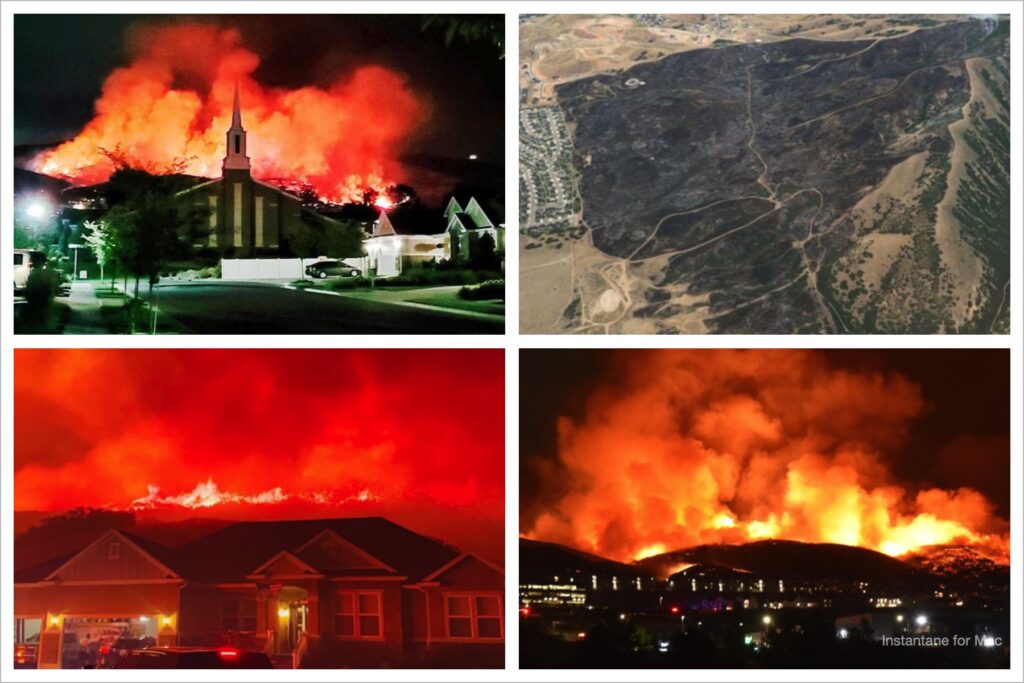
I hadn’t planned on writing a post about last Saturday night’s fire. However, in the fire’s aftermath, I’ve become inspired and grateful that our house (which is under construction) and our neighborhood was not burned.
For the past year, Rick and I have been building a home, and it’s been a long and complicated process (First World problems, I know). Our home’s completion has been delayed due to the need for a large retaining wall (much larger than we had originally anticipated) in our backyard. Along with the wall, tons of dirt was hauled in and then compacted to more fully secure the foundation of the house.
Rick and I have spent significant amounts of prayerful time in and out of the temple for guidance in where, when, and how to proceed with the building process of our home. We have dedicated the land, the construction materials, and everything else to the Lord; we want our home to feel like a temple. (In fact, I’m requiring our builder to include a cupola with a trumpet-blowing angel weather vane on the roof of the garage.) We have taken the scripture regarding “the house built upon the rock vs. building it on the sand” as a literal metaphor to our home’s construction.
We have learned so many spiritual lessons during this process. Here are a few:
The Wind
Last fall, I drove to the Timpanogos temple to pray specifically about the construction of our home’s foundation. Our builders had begun constructing the house before constructing the retaining wall, and I was worried about its subsequent stability. As I pulled into the temple’s parking lot, a ferocious wind began to blow. Once inside the temple’s chapel, I could hear the roaring wind rattling the windows. Looking down at the scriptures on my lap, my eyes fell upon the verse in Helaman, chapter 5: “And now, my sons, remember, remember that it is upon the rock of our Redeemer, who is Christ the Son of God, that ye must build your foundation; that when the devil shall send forth his mighty winds, yea, his shafts in the whirlwind, yea, when all his hail and his mighty storm shall beat upon you, it shall have no power over you to drag you down to the gulf of misery and endless woe, because of the rock upon which ye are built, which is a sure foundation, a foundation whereon if men build they cannot fall” (verse 12). Peace filled my heart, and I marveled at the multiple meanings and lessons within this particular verse.
The Earthquake
A few weeks later, a very rare 5.4 earthquake (centered in Salt Lake County) shook the surrounding areas. As a Californian, earthquakes were a part of my life. In this case, however, my faith was further strengthened when our house suffered no damage—without a retaining wall. Again, Rick and I thanked the Lord for what we felt to be His divine assurances.
The Fire
Firefighter, Ben Swensen’s post (see photo at the bottom) underscored what many of us were feeling. We liked to think our homes were spared by divine intervention, but we also know the harsh realities of human suffering caused by natural disasters. I don’t claim to understand the seemingly randomness of miracles, but I can’t deny the existence of divine intervention and miracles either. Understandably, many people mocked those who believed divine intervention had spared our homes.
Here is our own experience: At 1:00 on Sunday morning, our kids called to warn us about the fire. Rick got in the car and dashed to the building site to check on our house. Residents, who lived just around the corner from our build (and others who lived up the road in the opposite direction), were evacuating. Rick could see the fire’s flames right behind the hill. We drove down to Timpanogos Highway, parked our car alongside hundreds of other people, and watched the fire—wondering which direction the flames would spread. As you can see by the photos, the fire line came very close to many homes, but not one home perished.
Again, I completely understand and sympathize with many people throughout history who have prayed to be spared from disasters and disease, yet still lose their homes, loved ones, and suffer sickness and death. Why some prayers are miraculously answered and others are not, I don’t know. I will never understand God’s reasoning—at least in this life. But, I do recognize the Lord’s intervening hand—regardless of “happy” or “sad” outcomes or less than desirable results—despite our best efforts in exercising faith. I do know that God is there. And He is here. He is everywhere—even in our tragedies—especially in our tragedies.
Later that Sunday, Rick and I, along with our children and grandchildren, gave prayerful thanks. That night, as Rick and I laid in bed, the strong mountain winds began to blow again. Within minutes, Rick sprang out of bed and began to get dressed. He told me, “I feel prompted to go check on the house. Something’s wrong. I can’t shake this feeling.” Driving up to the construction site in the wind and rain, Rick saw that the front door of our house had swung open due to the forceful winds. The construction crew had failed to secure the door when they left. Thus, if Rick hadn’t checked the house, the winds would have surely blown the ensuing heavy rains into the front entrance of the house and ruined the ongoing finishing work in the entry, the staircase, and the living and dining rooms. Rick locked and bolted the front door, and when he got home, we gave thanks once again.
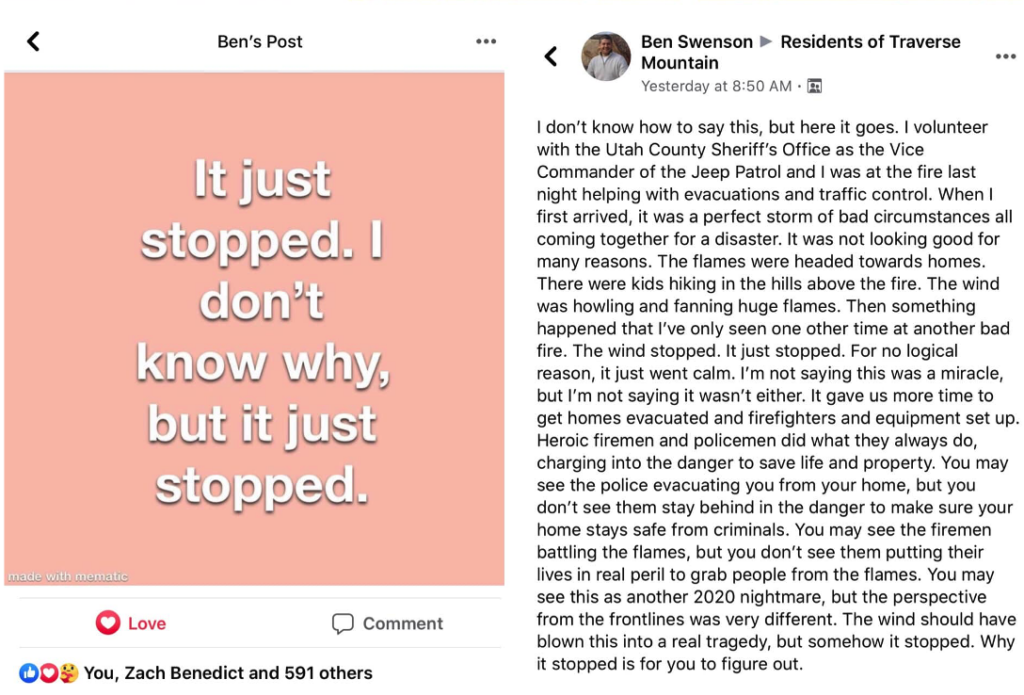
Surely, God protects all of His children in infinite ways!
Got scriptures?
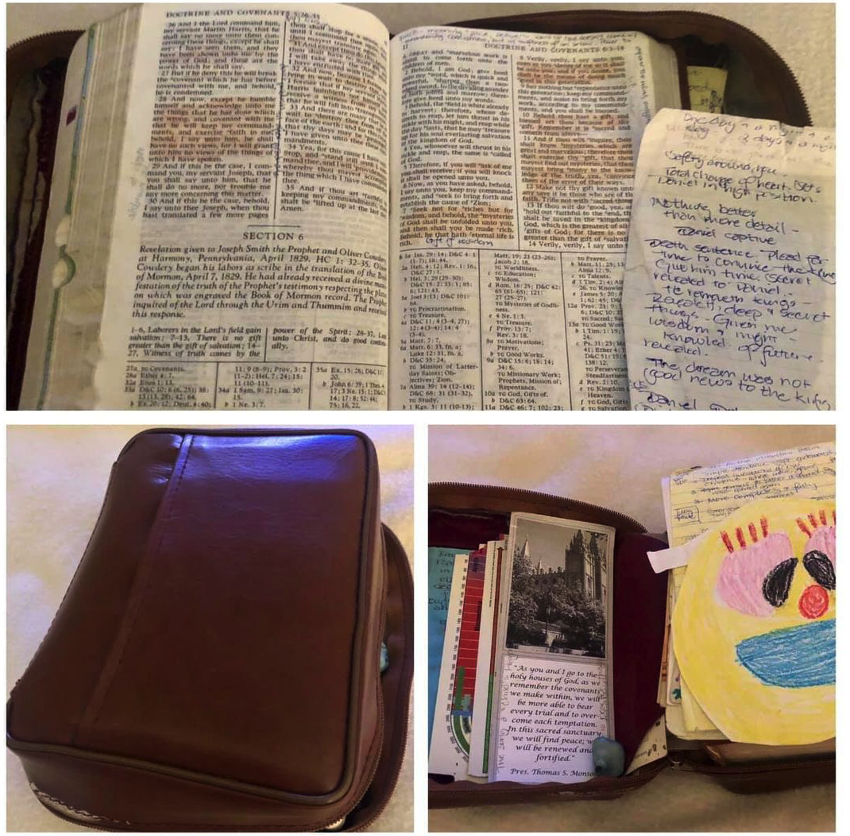
I experienced a tender mercy last week. My daughters, daughter-in-law, and granddaughter attended the Friday evening Women’s Conference at our stake center. I had taken one of my scripture sets (above) with me. After the conference, we talked, cried, and laughed as we reviewed the wonderful talks. In the cold night air, we ran and scrambled into my car and drove to our favorite eatery, Zupa’s, for dessert and continued conversation.
As I sat down to watch General Conference the next morning, I reached for this particular set of scriptures and realized it was gone. I felt sick. These scriptures are 25-years-old and contain mementos from my children and grandchildren. The little green stone (pictured above) was a gift from my granddaughter, Madison. She and I had talked about the stones gathered by the Brother of Jared (see Ether in the Book of Mormon). Madison had given me this stone as a token. I had also written down many inspirational thoughts and personal revelations I had received over the years and tucked them away in these scriptures.
Not only were these precious keepsakes and revelations irreplaceable, they were also sacred to me. I didn’t want anyone to rummage through these pages. Praying for divine intervention in helping me locate them, I drove to the stake center hoping its doors were unlocked for the televised Sunday general conference. The empty church parking lot was demoralizing; I sat in my car trying to figure out what to do.
That’s when I saw it: a tiny brown dot in the distance. I knew it was my scriptures. I drove up, scooped them up, hugged them to my chest, and thanked my Heavenly Father. My scriptures had sat there all night—completely undisturbed—in the cold and windy parking lot.
Notice verses 6 and 7 in the photo: “Ask and ye shall receive….” The Lord delivers on His promises. “Seek not for riches but wisdom. . .” I have several sets of scriptures, and each set is a treasure to me. No amount of money can compare to the pearls of wisdom found in this holy writ.
How thankful I am for ancient and modern prophets and apostles. How thankful I am that ancient prophets took the time to write these sacred records for us. How thankful I am for personal revelation which becomes my own form of scripture!
#holyscriptures #tendermercies #preciousrecords #generalconference2019
Got sand?
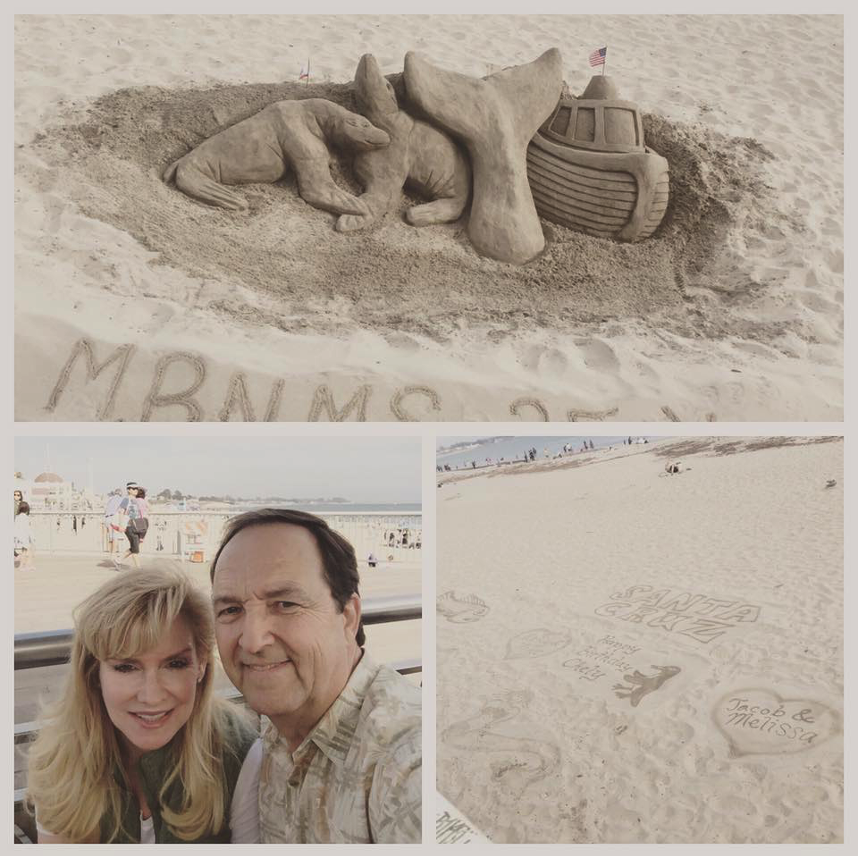
We were all dressed up and about to head to the Oakland Temple when we realized it was closed. What to do? Have lunch in Santa Cruz at the Beach Boardwalk, of course!
#notemplesessiontoday #templerenovations #californialiving #santacruzboardwalk
Got a beach?
By the beautiful sea!
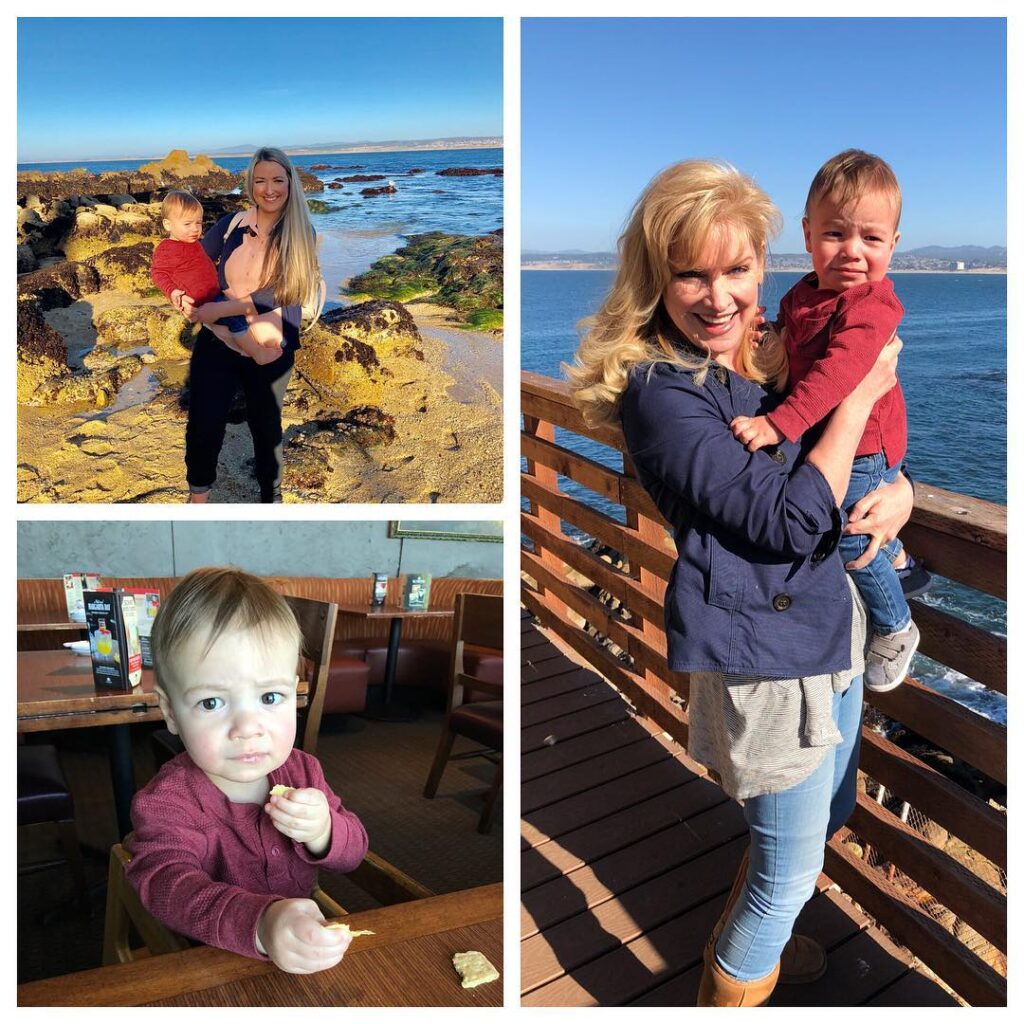
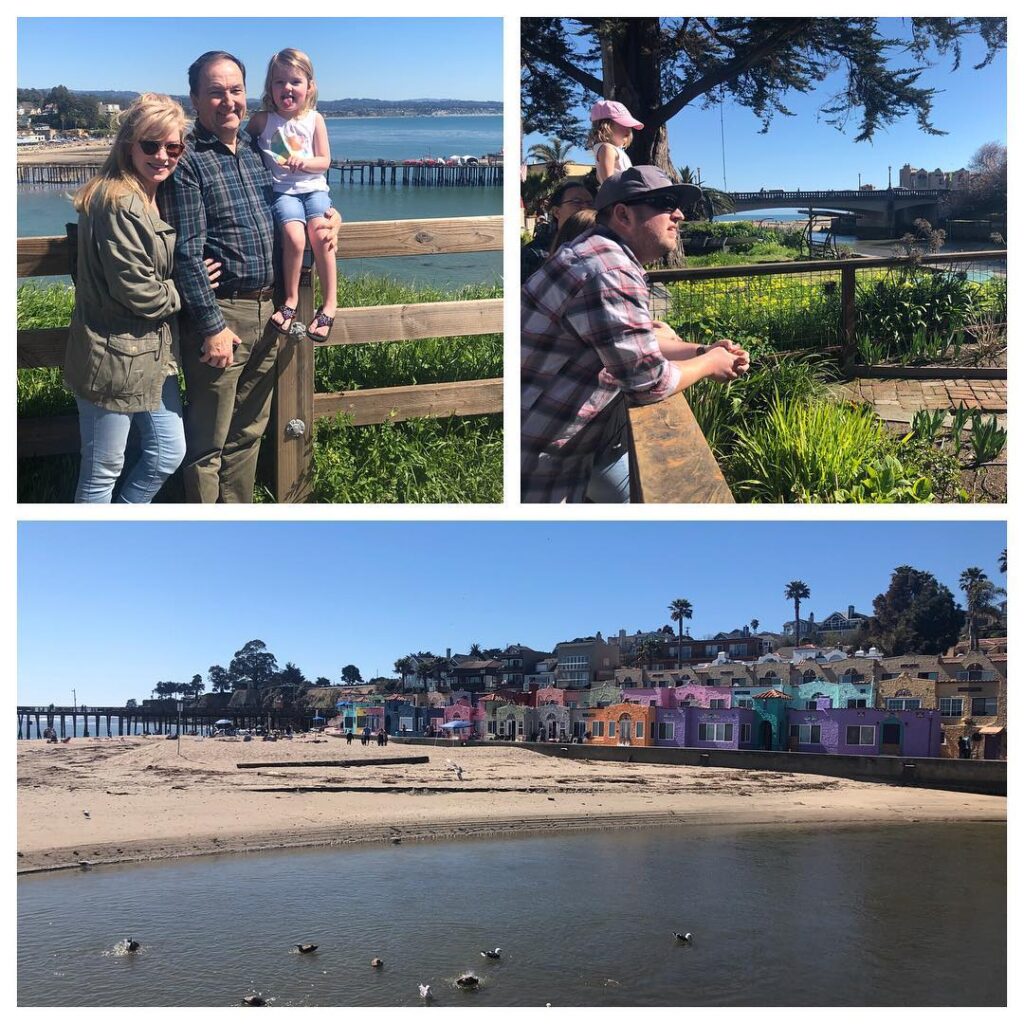
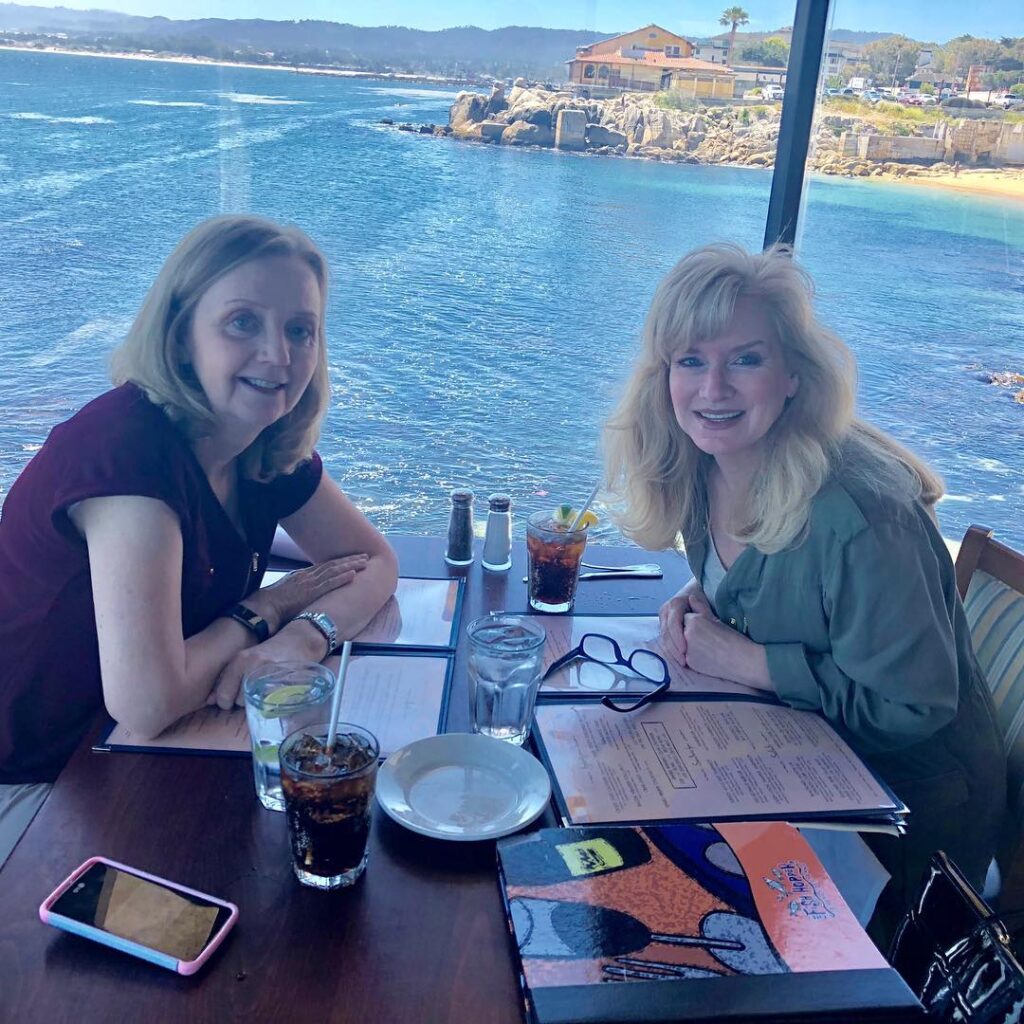
I love the ocean! It soothes my soul. I love the sounds, the smells, the rhythmic waves, the seagulls, and the seafood! Some of my favorite hangouts: Monterey Bay and Capitola.
Need prayers?
“The prayer of the righteous availeth much.“
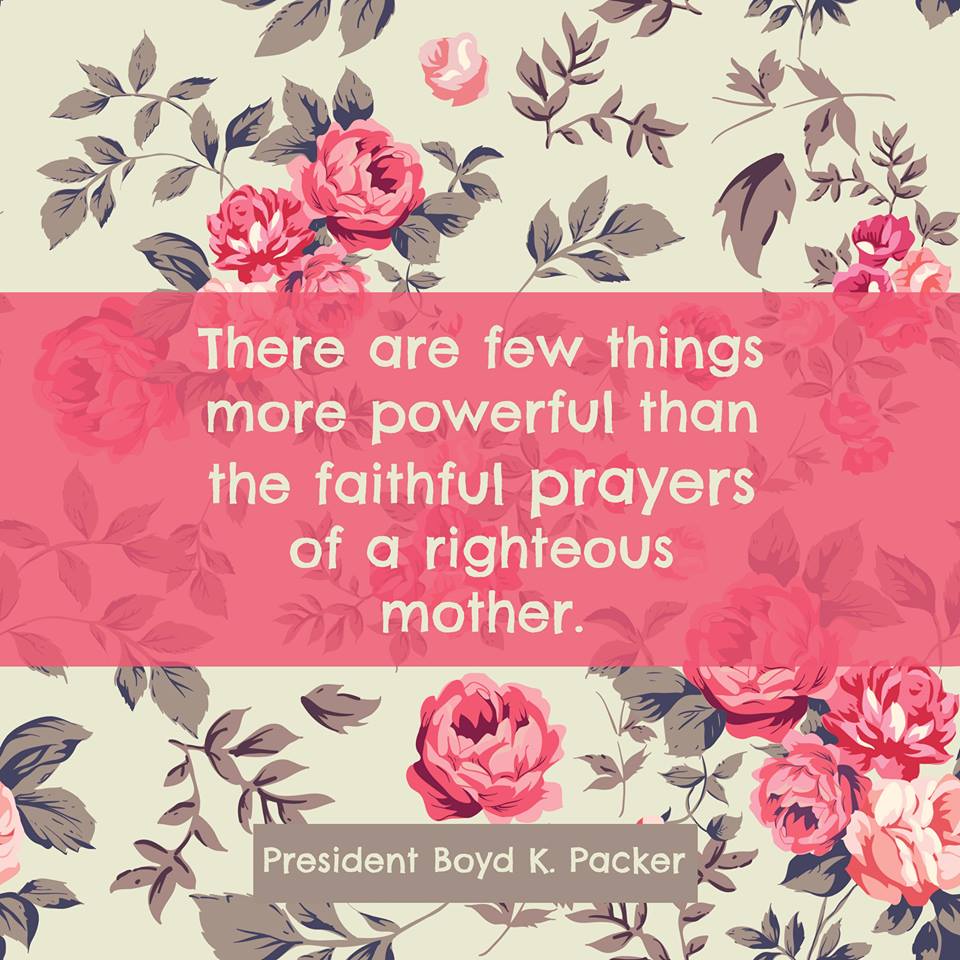
I’ve been a mom for many years. This quote has given me a lot of strength and fortitude while mothering my children. Now that my kids are all adults with their own families, I’ve found that they still very much need me. I’m still a matriarch as they seek my counsel, my prayers, my influence, and my support. Even more, I know I will continue to be a matriarch into the eternities.
#amothersinfluence #matriarchy #Christhelpsmeinmothering #mothersarepowerful #motherhoodrocks
Need a faith filled community?
“Worldwide Unified” on Facebook
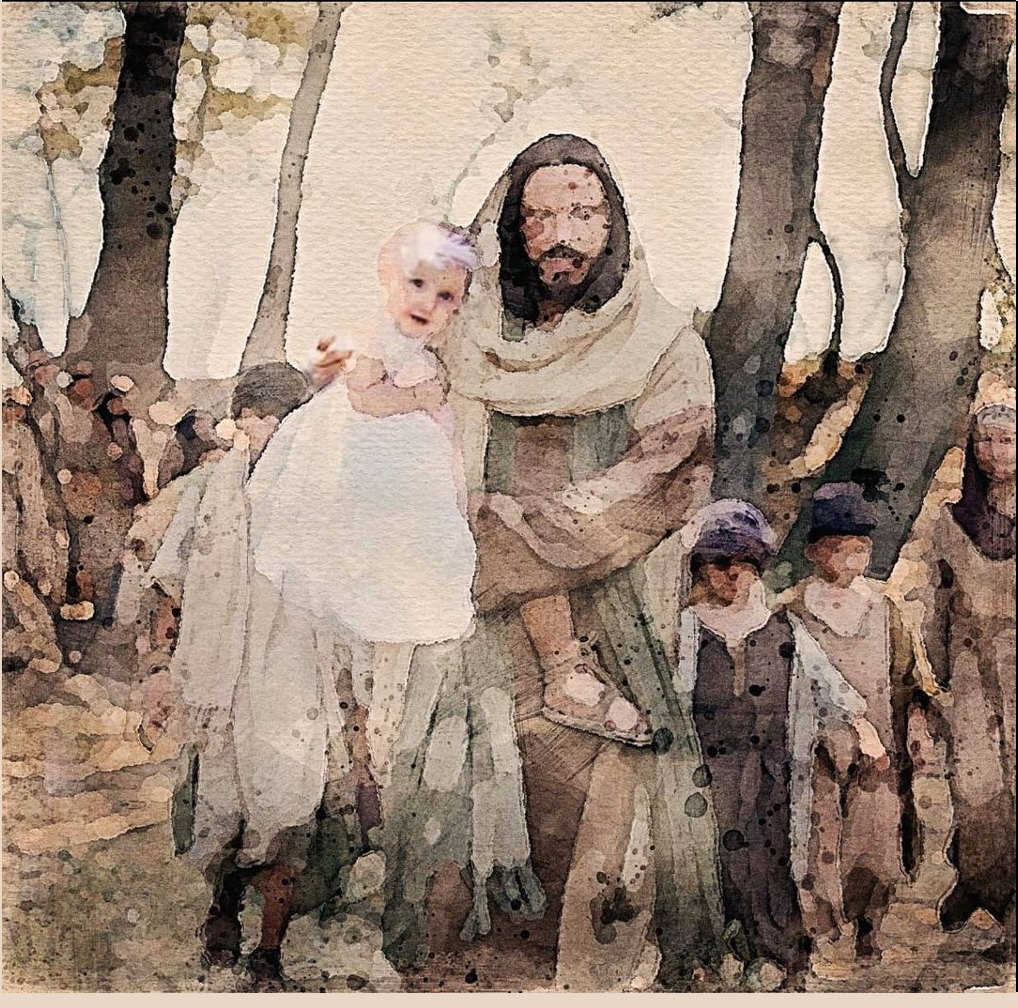
“Prayer is the most powerful tool and it can be heard from all over the world. It’s people like you who made the difference during our biggest darkest challenge of our whole life. I have had thousands of people reach out with so much love, wisdom and kindness . . . it is amazing.
My husband agreed that we need to include all those who were involved and prayed for Layla to hear the whole story and to be thanked for their prayers and fasting when we were in a really dreadful spot.
As many of you know Layla did not pull through, even with people all over the world praying, but despite how dang hard it is, as we cleaned her body today it was without a doubt that her spirit is with Jesus Christ and living even a greater life of joy and love . Everyday is so very hard. But I’ve seen it first hand how God is good even when it’s not our will.“
Got a pine cone?
What to do when tuckered all out?

When you’re so tired after hanging out with Grammy all day, you insert a pine cone in your mouth
and fall asleep in your car seat.
Place: Target Store Morgan-Hill (37.157525116439, -121.65453290312)
Address: 1061 Cochrane Rd, Morgan Hill, CA 95037
#adventureswithGammy #sweetSadie
Mar 18, 2019, 6:54 PM
Need more love?
A Heavenly Mother’s Love

“Divine Mother:
She is so bright and glorious that you cannot look at her face or her garments for the splendor with which she shines. For she is terrible with the terror of the avenging lightning, and gentle with the goodness of the bright sun; and both her terror and her gentleness are incomprehensible to humans . . . But she is with everyone and in everyone, and so beautiful is her secret that no person can know the sweetness with which she sustains people, and spares them in inscrutable mercy.”
(Hildegard von Bingen, 12th c. Vision / Paige Crosland Anderson, Golden Light, 2019)
Christmas
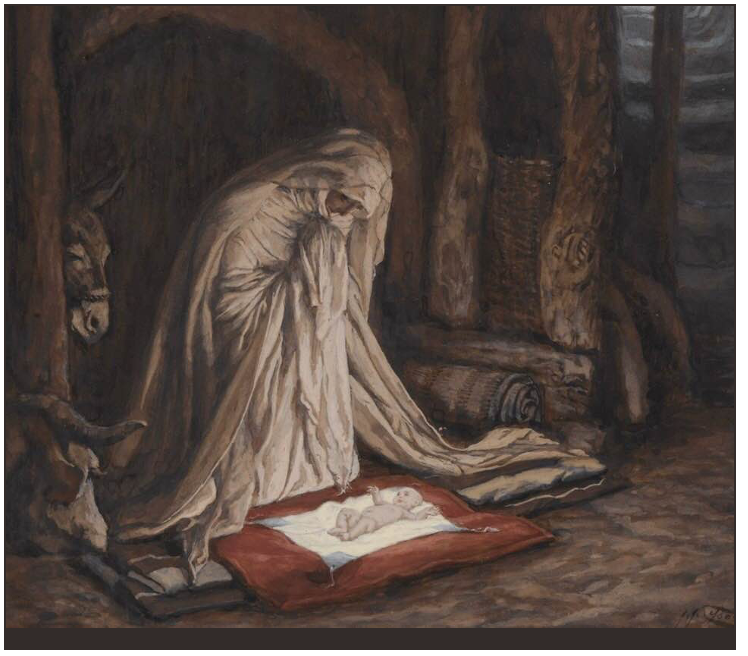
Christmas Eve 2016
A few months ago, I stopped making any of my Facebook posts public. I had cautiously put my voice “out there” regarding various issues of personal concern so felt no need to continue addressing them. And, due to the ever-growing hostility and divisiveness on social media, I had taken great thought and care before I publicly posted or commented. (Eventually, I got off social media.)
However, I will never stop publicly declaring my faith in Jesus Christ. This Christmas, I honor the birth of Jesus Christ. My discipleship is imperfect but sincere; I’m full of gratitude for His gifts to the world. ❤️
#merrychristmas #ifeelthesaviorslove #lovechristmastime #silentnightholynight #christmas2016
Joseph
Joseph’s role in helping Mary parent the Christ child was truly significant. In studying the life of Joseph, I agree with Biblical scholars who claim Joseph to be an older man and widower at the time of his betrothal to Mary. Throughout the centuries, Christian leaders and artists consider Joseph, Mary, and the Christ child as members of the “Holy Family.” Joseph only appears in the birth narratives of the Gospels as Jesus is depicted as a child when with Joseph. Regardless, Joseph was a devoted, loving, and deeply spiritual husband and father to qualify for his divine role as the “earthly” father to the Christ child.
In his December, 2023 Ensign article, “Joseph and Lessons for Stepparents,” attorney, Richard N. Bigelow gives wonderful insights regarding Joseph’s sacred role as “stepparent” to the Christ child. He outlines four different aspects in stepparenting using Joseph as a role model: 1) Remember Your Children’s Divine Nature and Destiny. 2) Protect the Children. 3) Serve Without Recognition. 4) Support Your Children’s Mission.
1. Remember Your Children’s Divine Nature and Destiny
A key part of Jesus’s development was spending time with Joseph and learning from him. Joseph knew his undertaking was very special, even if he may not have understood all the implications of just how important Jesus was. Joseph knew Jesus was born in a royal earthly line, to be a king. Joseph was willing to name the Christ child what he was instructed to name Him (see Matthew 1:21, 25). What an example of humility and obedience that Joseph was willing to do what his Heavenly Father requested!
Joseph faced the challenge of supporting Mary and the child he knew to be of heavenly origin, in spite of the physical and socially challenging circumstances of Jesus’s birth to Mary. Shepherds, angels, and, later, Wise Men came to declare and honor the sacred birth of the King of this world (see Matthew 2; Luke 2). Joseph knew from the beginning that this boy was the Son of Heavenly Father. Joseph understood the need to honor that knowledge.
All children are born with the opportunity to become kings or queens, princes or princesses (see Doctrine and Covenants 132:19). The only cost to us for the fulfillment of these promises is obedience. Honoring the knowledge that you chose to raise a king or a queen is a challenging, humbling, but necessary understanding for every successful parent and stepparent.
2. Protecting the Children
Mothers and fathers have as one of their main parenting responsibilities the physical and spiritual protection of their children. Heavenly Father knew that the adversaries of righteousness would want to harm Jesus. An angel of the Lord warned Joseph to take his family to Egypt to avoid the horror of King Herod (see Matthew 2:13–14). The angel told Joseph to stay “there until I bring thee word” (Matthew 2:13). Joseph left his home not knowing when or if he would ever return because he had taken on responsibility to protect someone else’s son.
After Herod died, an angel told Joseph to return to Israel (see Matthew 2:19–21). Think of the frustrations stepparents often have when birth parents have requests, concerns, and demands. “Go to Egypt. Wait until I tell you what to do next. Go back to Israel.” There is no record of Joseph ever complaining about this situation, despite the hardships to him, but only righteous prioritization and compliance with what was needed for his stepchild.
Joseph’s obedience to heaven and his protection of and sacrifices for the Savior and Mary are beyond argument a collection of the most selfless, meaningful, heroic, protective, and righteous fatherly acts in all of recorded history. And they were done by a man who was not Jesus’s birth father.
3. Serving With Little Recognition
After Joseph brought his family back from Egypt, we read again about him only in Luke 2:41–51, when Jesus was in the temple at age 12. At that time Jesus advised Joseph and Mary, “[Knew] ye not that I must be about my Father’s business?” (Luke 2:49), gently suggesting that this was something they should have understood.
That was a situation when many parents would get angry, bothered, or embarrassed by a perceived lack of respect from the child or interference by the natural father. But Joseph understood enough about his future king at age 12 to trust that He had a mind and future of His own and to honor that future.
Because of the goodness of his soul, Joseph seemed to be exactly the kind of self-controlled, righteous man our Heavenly Father could choose to be a good example to the Son of God. The scriptures do not indicate that raising Jesus brought Joseph any worldly blessings. As a voluntary father he humbly accepted the challenges of his decision without published complaint or expectation.
4. Supporting Your Children’s Missions
Joseph was a builder, and he likely taught Jesus about those things. Jesus was sent to a father who needed to work, where there were economic and physical struggles. Jesus could learn and observe firsthand what it took to provide for a family’s needs. During those work times, surely Joseph and Jesus came to know and appreciate each other’s personal characteristics.
By working side by side with people, you get to know them. It is also during the times of lengthy working together that people can develop a spiritual connection where they recognize the value of each other’s soul. That is the kind of foster father Heavenly Father chose for His Son.
It is possible that Joseph may have had misgivings about being a foolish, flawed human who had been given the charge to raise the Son of God. As parents, aren’t most of us concerned about our weaknesses, our ability to teach children with love and wisdom, and our ability to understand how to do the right things?
Although Joseph and Mary may not have known everything that would happen to their Son, knowing His divine identity must have created a tremendous sense of responsibility for them. But don’t all parents, including stepparents, need to put in the time to truly come to understand and appreciate the life mission of their children—not the mission the parents want but the mission given their children by their Father in Heaven and inspired by the Holy Ghost in the heart of each child?
Here’s the link for the full article: https://www.churchofjesuschrist.org/study/liahona/2023/12/united-states-and-canada-section/02-joseph-and-lessons-for-stepparents?lang=eng#p14
Surely, Joseph serves as a wonderful role model for parenting!
Christ’s Foreordained Mission as the Son of God and Redeemer
Merry Christmas! I love these depictions of Christ as our Savior and Redeemer, so I put them together into a short video.
The Shepherds
December 20, 2022
Latter-day Saint Worldwide Devotional
Shepherds and Sheep
“Elder David Bednar has spoken more specifically about the shepherds and sheep from the account of Christ’s birth, explaining that the flocks were destined for divine sacrifice.
‘There were many shepherds in Palestine, but only to those who watched over the temple flocks did the herald angels come. Only they heard the heavenly choir. Those were not ordinary sheep,’ he said.
Noting that many Nativity scenes with Joseph, Mary and the baby Jesus also include sheep and shepherds, he invites: ‘Please don’t look at the sheep and shepherds quite the same way again.'”
Not all only that, after witnessing the “babe lying in a manger,” these humble shepherds were also special witnesses who were commanded to tell others about what they had seen. The account by Luke says, “The shepherds returned, glorifying and praising God for all the things they had heard and seen, which were just as they had been told” (Luke 2: 19-20).
We, too, can also witness to others of the divinity of Jesus Christ as the Son of God and the Savior of the world!
Christ as the Good Shepherd
Four days after the birth of my third child, I was called to be the ward Primary president. I suspected something was going on when, during my hospital stay, the entire bishopric came to visit me—while repeatedly commenting on “how good I looked” after giving birth the day before. When the call came, I was completely overwhelmed. Also, during that time, my husband was serving as the Elder’s Quorum president, working full time, and attending graduate school.
After serving for several months, I was feeling burned out. That all changed one day as I sat in Sacrament meeting. Looking around the chapel at the Primary children sitting with their parents, the Spirit whispered to me, “Julie, do you love me?” I thought process was similar to the ancient apostle Peter’s reply when he told Jesus, “Yeah, Lord. Thou knowest I love thee.” Christ responded to Peter, “Then feed my sheep.” I quickly understood Christ’s personal admonition to me in that moment: “Julie, feed my lambs.” I was reminded that all of those little Primary children were Christ’s lambs, and my role as their Primary president was to feed them.
Surely, we are all shepherds in many different ways. Below are some insightful excerpts from some of the women auxiliary leaders from The Church of Jesus Christ of Latter-day Saints:
As we rejoice in this Christmas season, take a moment to consider shepherds and shepherding. What opportunities do we have to witness of the Savior like the shepherds of old? How can we follow the example of the Good Shepherd to watch over Heavenly Father’s flocks? And what can we do to prepare other shepherds who will follow us — to shepherd the shepherds?
In this unique and stretching Christmas of 2020, may we all remember that the Good Shepherd knows His sheep. He loves us, protects us and walks with us. He knows our names, and He knows our hearts. We know His voice and He is calling us to follow Him. He also pleads with each of us, because we love Him, to love and feed His lambs and invite them to trust in the saving grace of “the Lamb of God” (John 1:29).
Each of us has had a shepherd, a mentor, a friend who has been a lamp unto our feet and a light unto our path who helped us come unto Christ and follow in his footsteps (Psalms 119:105). It may have been a family member, a leader, a teacher, a neighbor or someone from work or school. Shall we not also go, and do likewise? (Luke 10:37).
Merry Christmas!
“And there were in the same country shepherds abiding in the field, keeping watch over their flock by night. And this shall be a sign unto you; Ye shall find the babe wrapped in swaddling clothes, lying in a manger.”
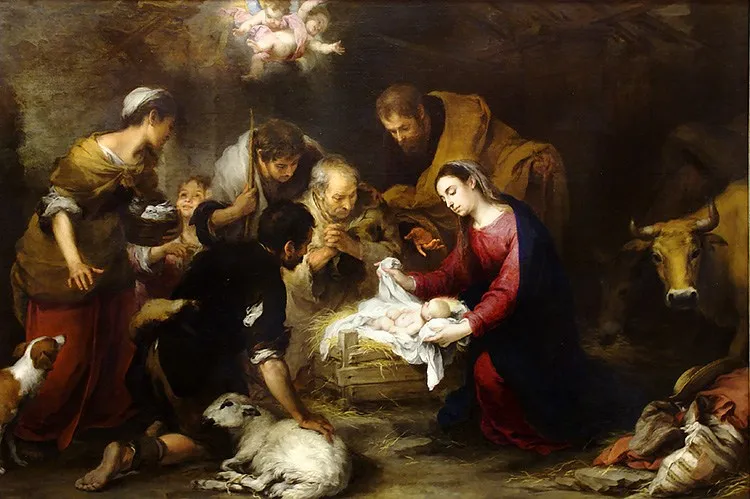
“Silent night, holy night . . .
Shepherds quake at the sight . . . ”
Christianity’s value and influence in Western societies will continue to diminish. Regardless, one’s personal faith isn’t constrained by societal gravitation and influence. Faith is a multi-faceted principle of power and action–-be it individually or collectively.
My greatest treasure is my faith in a newborn baby boy who matured and eventually changed the world . . . and who also changed my world.
#MerryChristmas #PrinceofPeace
Wise Men and Women Still Seek Him
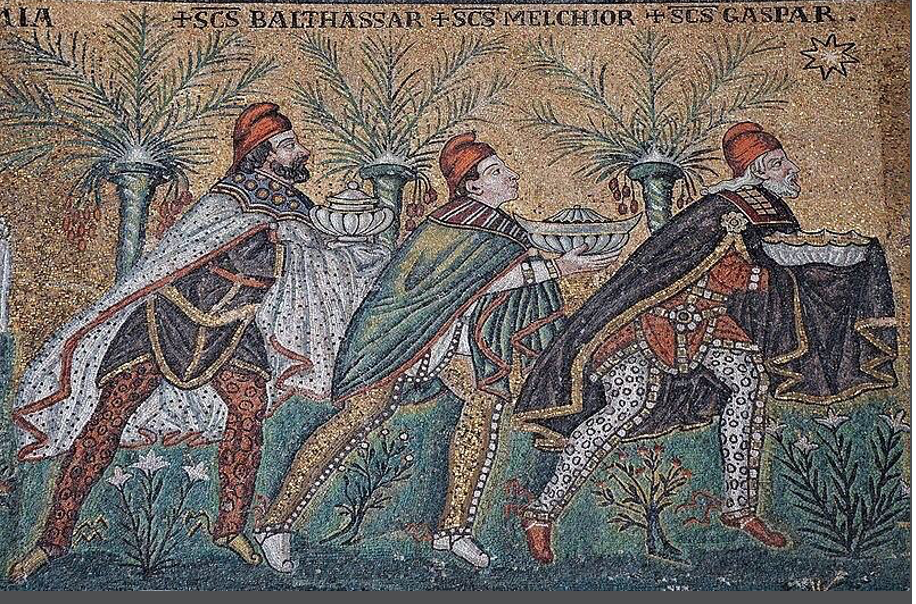
Neal A. Maxwell Institute for Religious Scholarship
For the Star
12:3 And again, we saw that heaven had been opened like a great gate and men of glory carrying the star of light upon their hands. And they descended and stood upon the pillar of light, and the entire mountain was filled by its light, which cannot be uttered by the mouth of humanity.
12:4 And (something) like the hand of a small person drew near in our eyes from the pillar and the star, at which we could not look, and it comforted us. And we saw the star enter the Cave of Treasures of Hidden Mysteries, and the cave shone beyond measure.
13:1 And when it had concentrated itself, it appeared to us in the bodily form of a small and humble human, and he said to us: “Peace to you, sons of my hidden mysteries.”
From Revelation of the Magi, trans. Brent Landau. From a 2nd or 3rd c. Manuscript, a Syriac copy of which was discovered in the Vatican Library.
#merrychristmas2020 #christmas2020
(Mosaic from Sant’Apollinare Nuovo, Ravenna, 526.)
In honor of the Wise Men, I compiled this video of some of my favorite renditions of these special men.
The Church of Jesus Christ of Latter-day Saints website says this about the Wise Men:
The scriptures tell us that ‘wise men [came] from the east’ (Matthew 2:1) to seek the Savior. The term wise men comes from a Persian word, magi. Though we aren’t told exactly who these men were, there are a few things we can say we know about them from what we are told.
People have traditionally thought there were three Wise Men because they brought three gifts. But it’s unclear from the scriptures how many Wise Men there actually were. We also understand that they visited Jesus as a young child rather than as a baby (see Matthew 2:11).
The Wise Men clearly were righteous and knew some prophecies about the Messiah’s birth. They may have been from a branch of the Lord’s people. They diligently sought the Son of God and were led to Him by the Spirit. They brought Him gifts and then returned to bear witness of His birth to their people. They were also warned in a dream not to tell Herod where the child was.
Their faithfulness and diligence can be an inspiring example to us in our personal journeys to draw closer to the Savior (Who Were the Wise Men?).
I am trying to be a “wise woman” by following “the star” in the form of prophets, apostles, and the holy scriptures as I wend my earthly way in coming to Christ.
Jesus Christ Is the Light
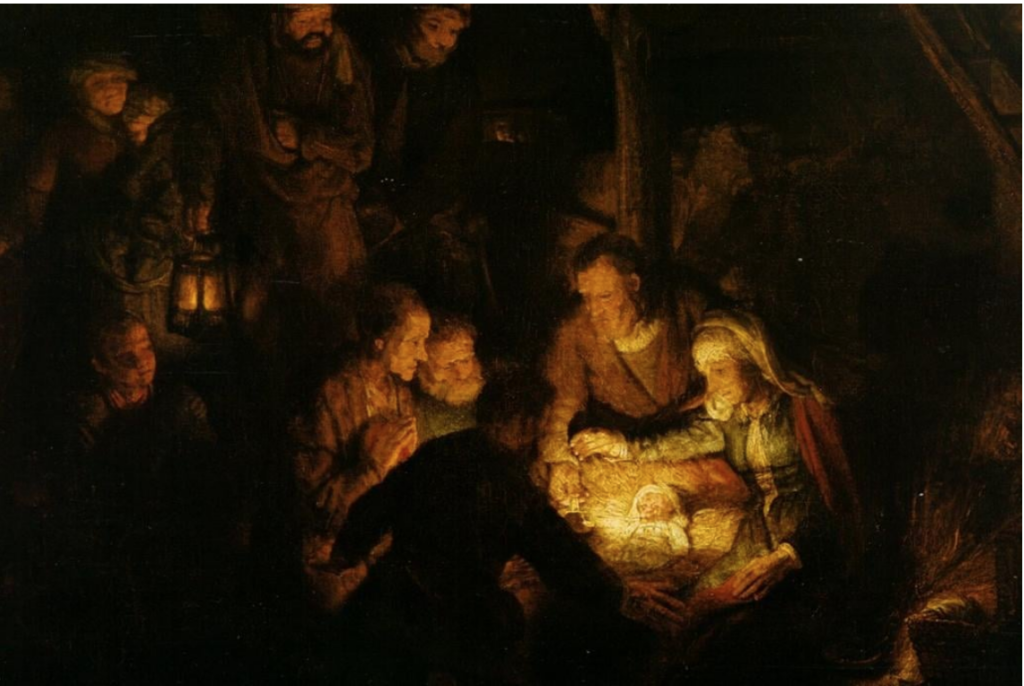
The contrast of the light to the dark is what draws me to this painting. Jesus Christ is the light.
#merrychristmas2020 #christmas2020
Neal A. Maxwell Institute for Religious Scholarship
Twenty:
I love a night nativity for the penultimate darkness of the year.
This is the moment she is reaching out, without any hesitation.
She extends her hands, herself entire, toward her wee babe.
She looks at him directly, face to face, right in the eye.
No burning bush, no misty cloud, no pillar of fire, no angels at Mamre, no whisper to Elijah, no dreaming sign or heavenly messenger.
This is love unfeigned.
(Hugo van der Goes, The Nativity at Night, National Trust, London)
@classiccatherine
“O Come All Ye Faithful, Joyful and Triumphant”

As our society grows ever more secular, I gain an ever greater appreciation for the Christmas season. This is the time when secularists and non-Christians who still celebrate the festivities of the season must acknowledge—on some level—the Savior’s birth. I also ponder and stand in awe of Mary’s holy calling in birthing and raising the Christ child. Our stake conference was this weekend, and my favorite part of the meetings was singing the wonderful Christmas carols. “Oh come all ye faithful joyful and triumphant.” This is how I feel because of Him.
His triumph can become our triumph through His atoning sacrifice for our sins.
#merrychristmas #ifeelthesaviorslove #lovechristmastime #silentnightholynight #christmas2016
(The Nativity, El Greco Deomenico Theotocopul)
Inclusivity
Engaging in Constructive and Productive Advocacy (Without Sanctimony and Insults)
August 27, 2017
This brilliant BYU law professor, Gayla Sorenson, reflects my own views. I don’t advocate for the
political left or for the right. Politicians in Washington cannot ultimately solve our problems because
they are too much the problem. Loving advocacy can. I advocate for liberty against any form of
tyranny and oppression. I advocate for the spirit of independence and free-agency. I advocate for the
free exchange of ideas in the public square. I advocate peacemaking.
I advocate for respectful dialogue and against shaming and bullying others because their opinions differ from mine. Sorenson says:
We need to change [society’s] imbalance by playing the role of advocate more and the role of
critic less. Remember, Christ is our example, so civility must be paramount. There is no room for
mocking, labeling, bullying or belittling. Advocates should remember the opposing point of view.
Effective advocates can still ably represent their client’s strengths while conceding that the other
point of view is not entirely devoid of merit. BYU students should act as advocates because Jesus
Christ himself was an advocate.
Lenny Geary was an inspiration to us all.
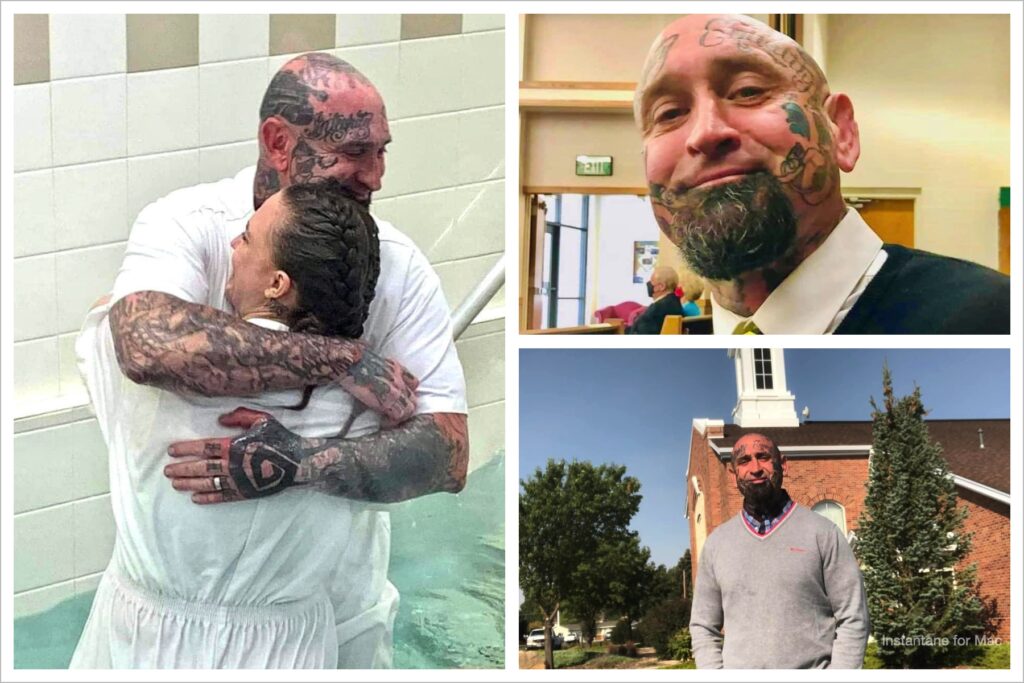
His obituary:
Lenny Geary was born on March 6th, 1974, in Los Angeles, California. Lenny had an energy and charisma that could light up any room. He loved music and considered himself an original punk rock skinhead. Lenny worked at the Govannon Studios tattoo shop in Idaho Falls. He loved a good prank and looked for opportunities to laugh with his coworkers on a regular basis. Lenny’s creativity, unique style, and zest for life was contagious. He shared openly about his experiences in hopes to help others. We believe Lenny would want us to continue that legacy.
Lenny’s parents struggled with addiction. He was introduced to gang life when he was young, and he spent his childhood in and out of foster care. Lenny was living on the streets of Los Angeles by the time he was thirteen years old. Gang life was a natural progression for Lenny. He shared, “I was a soldier. I put in work for my gang, and never even considered that there was a God. I thought believing in God was a weakness. Crime, violence, and dishonesty were a way of life for me.” Lenny struggled with an addiction to alcohol and became addicted to heroin when he was young.
Lenny fell in love with Idaho Falls and moved because he wanted something different. He shared, “I noticed the genuine goodness of the people in Idaho Falls right away and knew this was my chance to build a better life.”
Lenny spent time in prison; that’s where he found God. He shared, “They locked me up in Idaho Falls, and I thought I would get sick coming off the drugs. I started reading the Bible and Book of Mormon just to keep my mind off getting sick. I wasn’t a believer but I needed something to focus on.”
Lenny read a scripture in the Book of Mormon from 2 Nephi: “And he inviteth all to come unto him and partake of his goodness; and he denieth none that come unto him, black and white, bond and free, male and female; and he remember the heathen; and all are alike unto God.”
When Lenny got out of jail he sent a message to the missionaries of the Church of Jesus Christ of Latter-day Saints and told them he wanted to get baptized. He said, “Some of my friends told me I was crazy. The church wouldn’t want a guy like me. Who cares what people say! I’ve always been stubborn. People called me a Jesus Freak. I don’t care! I’m okay being stubborn for God.”
Lenny’s journey wasn’t easy. “It took a while to get baptized,” He shared. “That’s when I found out that no doesn’t always mean no, especially when it comes to God, no usually means not yet.”
The work Lenny did to prepare for baptism was sacred to him. He shared that he found out who he really was because of the love and fellowship of the people in the Ammon ward. He loved spending time with the missionaries. “It was the happiest time of my life,” he said.
Lenny’s baptism affected people all around the world. A photo of Lenny in his white clothes in the baptismal font was shared on social media, and it inspired people everywhere. Lenny gives people hope.
Lenny never stopped fighting his addiction. When he relapsed he put himself into treatment. Lenny passed away on March 20th, 2023. His cause of death has not been determined, but we know he is victorious through Christ. Lenny’s daughter, Shayla, shared that she believes her father is in a better place, and he will be able to support his children as he wanted to where he is now. Lenny’s life was difficult, but there was a tenderness in Lenny that connected him to all of us. Lenny loved animals and children. He is survived by his three children, Shayla Geary, Liam Geary, and Reagan Geary, and by friends and community that cannot be measured.
